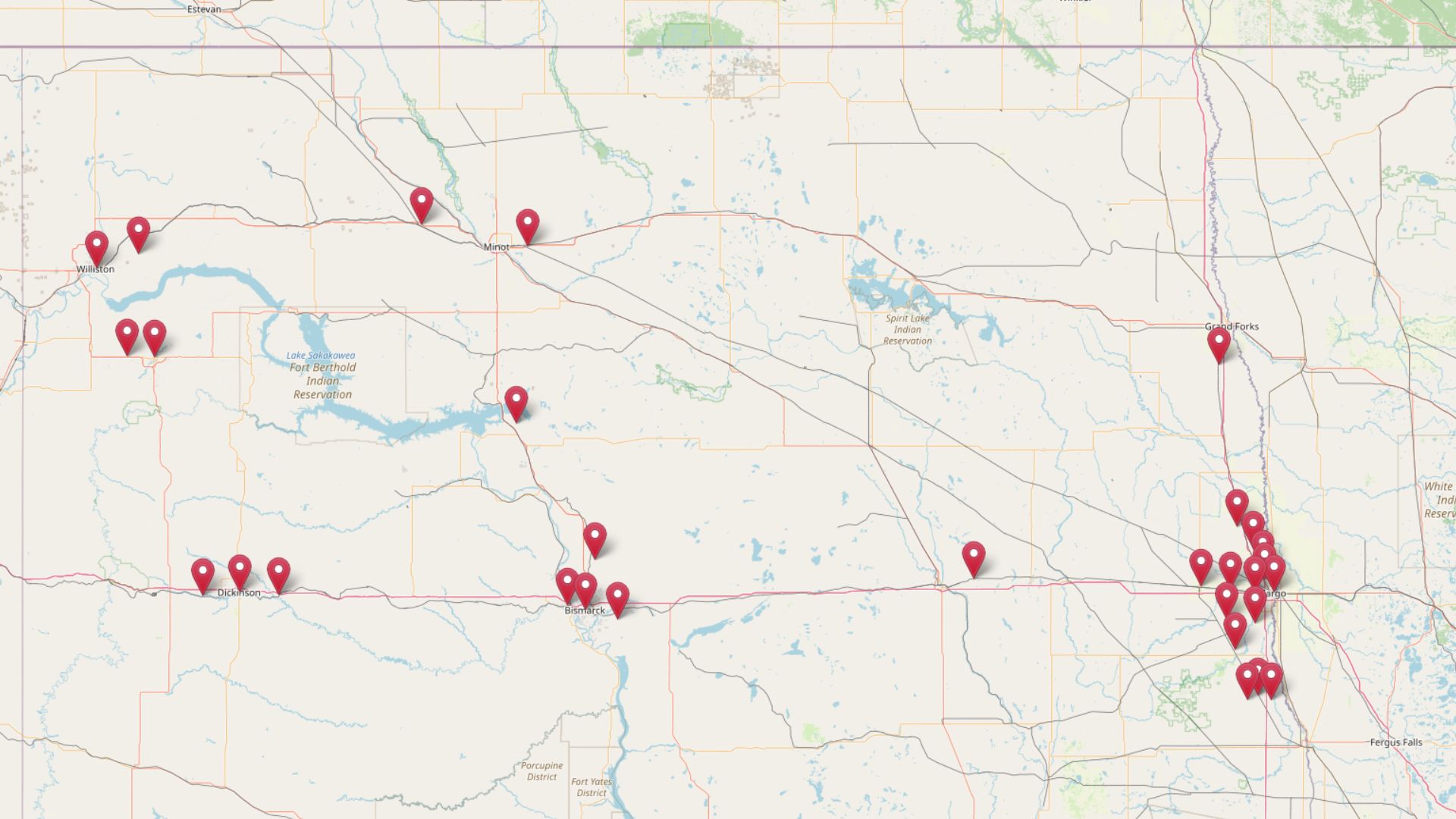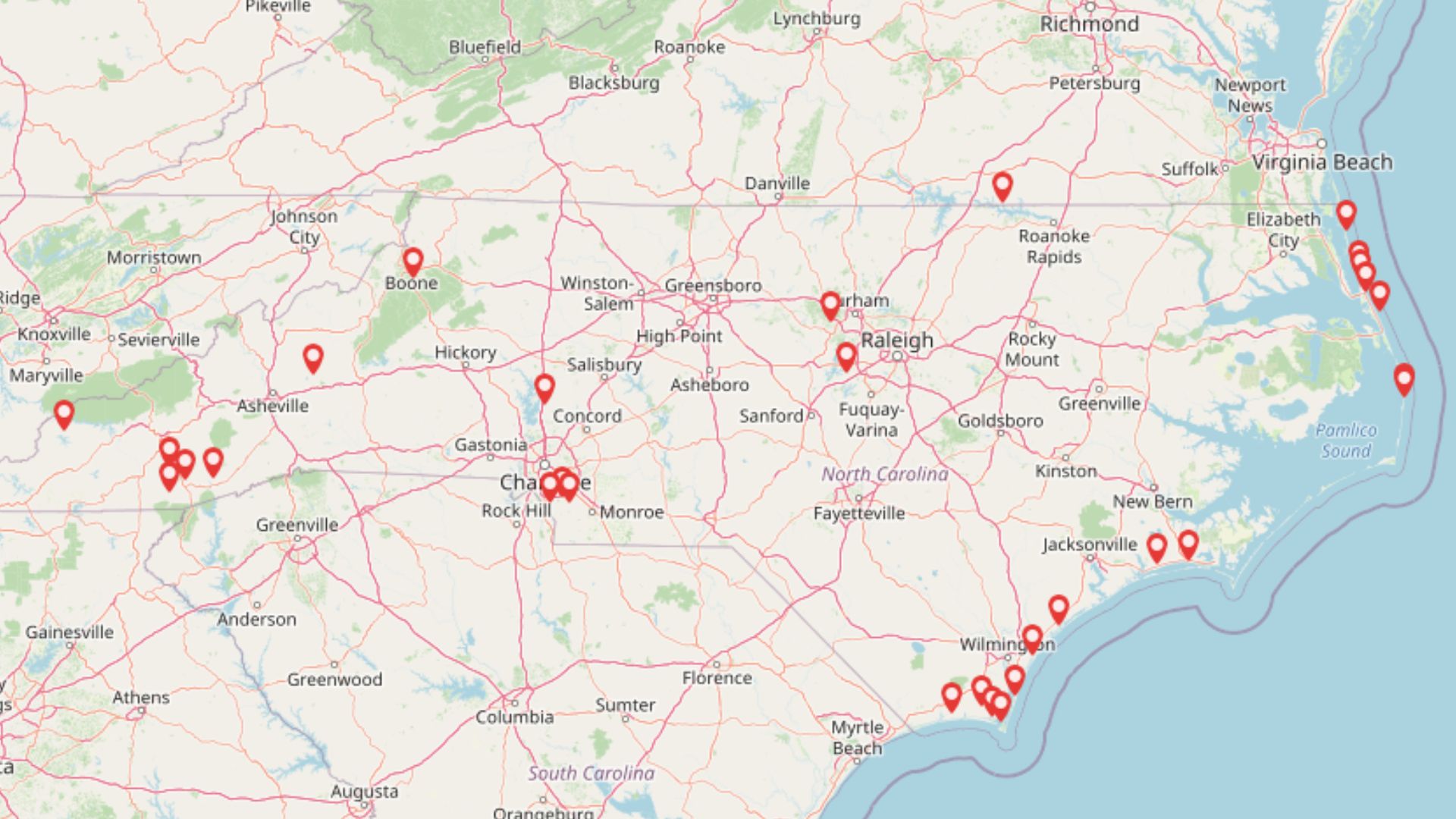
Using the latest Zillow Home Value Index data, we’ve ranked the 30 most expensive towns in North Carolina based on current home prices. These communities represent more than just high costs—they showcase North Carolina’s most desirable locations where natural beauty meets strong investment potential.
From coastal barrier islands to mountain retreats, each town tells a story of premium living and sustained growth. These rankings reveal where North Carolina’s wealthiest residents choose to call home and why certain communities command such extraordinary prices.
30. Lake Santeetlah – 59% Home Price Increase Since 2012
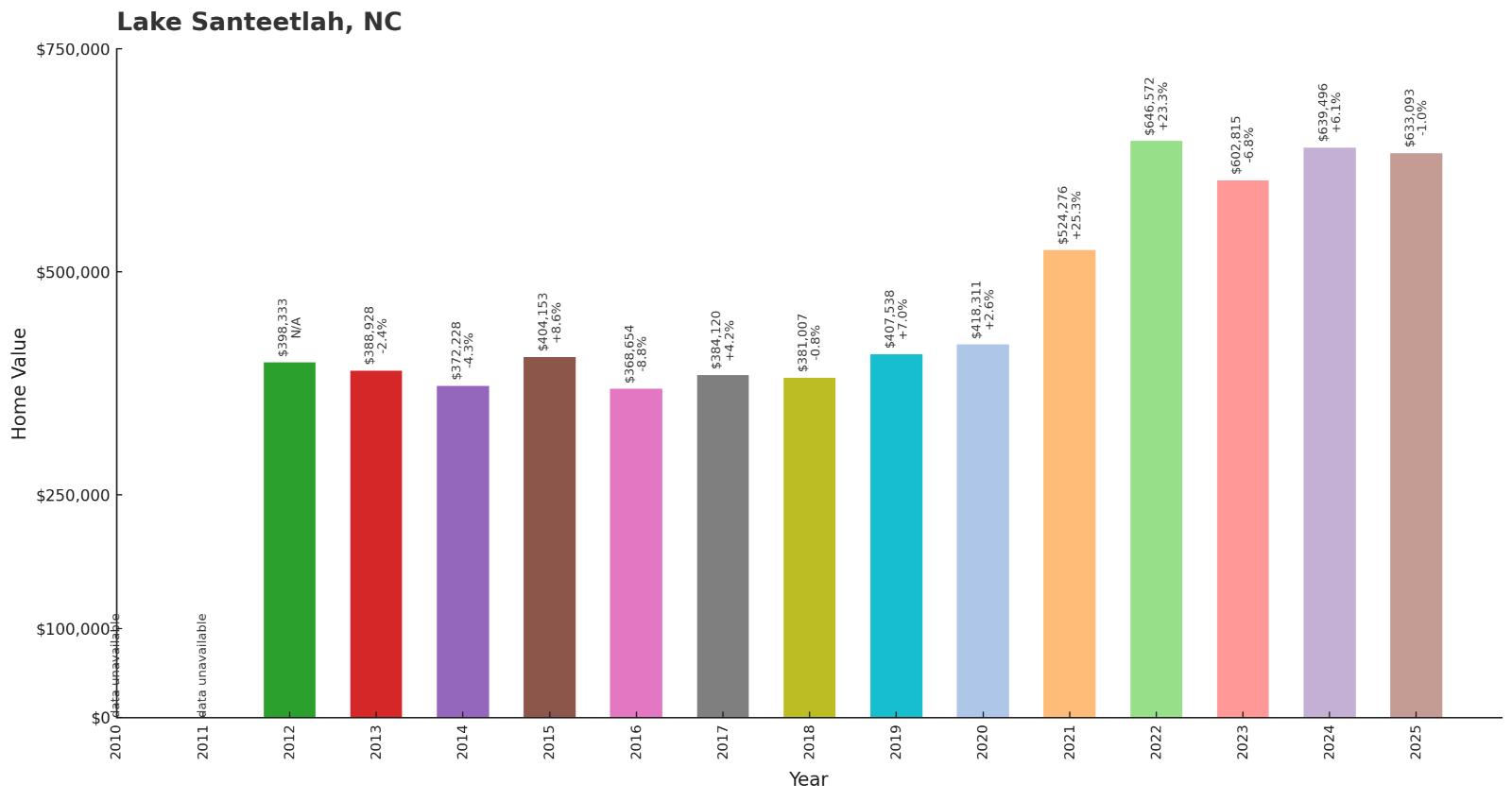
- 2010: N/A
- 2011: N/A
- 2012: $398,333
- 2013: $388,928
- 2014: $372,228
- 2015: $404,153
- 2016: $368,654
- 2017: $384,120
- 2018: $381,007
- 2019: $407,538
- 2020: $418,311
- 2021: $524,276
- 2022: $646,572
- 2023: $602,815
- 2024: $639,496
- 2025: $633,093
Lake Santeetlah experienced steady growth from its first recorded value in 2012, with prices climbing 59% to reach $633,093 by 2025. The community saw its biggest gains during the pandemic years of 2021-2022, when values jumped from $524,276 to $646,572. This mountain lake community has shown resilience despite some fluctuation in recent years.
Why Lake Santeetlah?
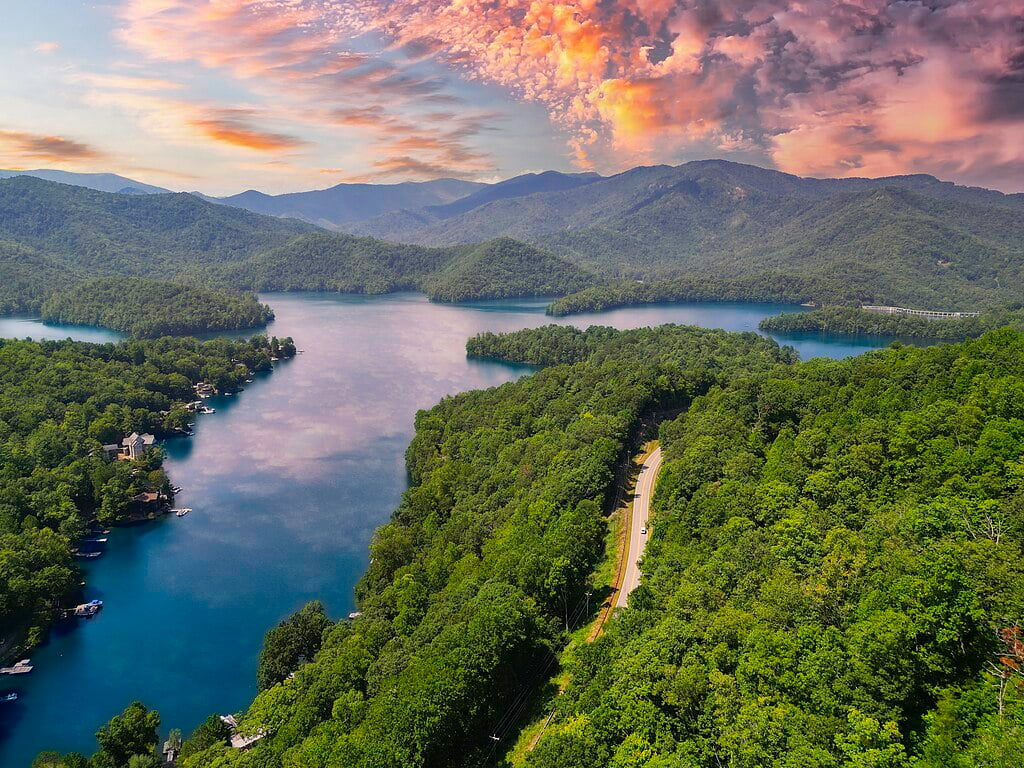
Why are people willing to pay so much to live here? What’s special about it?
Lake Santeetlah attracts buyers seeking a pristine mountain lake lifestyle in the heart of the Nantahala National Forest. The crystal-clear waters and surrounding wilderness create an unparalleled setting for outdoor enthusiasts who value privacy and natural beauty. Unlike more developed lake communities, Santeetlah offers an authentic mountain experience with minimal commercial development.
The lake’s unique position within the national forest provides permanent protection from overdevelopment, ensuring property values remain stable. Homes here typically feature large lots with private lake access, appealing to buyers who want both luxury amenities and genuine wilderness access just outside their door.
How Lake Santeetlah Rose to Prominence
Lake Santeetlah was created in 1928 when Alcoa built a dam on the Cheoah River to generate hydroelectric power for their aluminum smelting operations. The Cherokee name “Santeetlah” means “blue waters,” perfectly describing the lake’s distinctive cobalt color that comes from its incredible depth and mineral content. For decades, the area remained relatively undiscovered except by serious anglers and wilderness enthusiasts.
The community began attracting affluent second-home buyers in the 1980s and 1990s as North Carolina’s mountain regions gained popularity. The lake’s reputation for exceptional fishing—particularly for smallmouth bass and trout—drew attention from outdoor recreation enthusiasts willing to pay premium prices for waterfront access. Its location within the national forest boundaries created scarcity that drove up land values significantly.
3 Interesting Tidbits
1. Deepest Lake in North Carolina – At 210 feet deep, Lake Santeetlah is the deepest lake in the state, creating its signature blue color and excellent fishing conditions.
2. Alcoa’s Legacy – The aluminum company still owns and operates the dam, but residential development around the lake has created one of western North Carolina’s most exclusive communities.
3. Film Location Fame – The lake and surrounding forests served as filming locations for several Hollywood movies, including portions of “The Fugitive” starring Harrison Ford.
29. Caswell Beach – 52% Home Price Increase Since 2010

- 2010: $418,994
- 2011: $352,261
- 2012: $304,901
- 2013: $303,767
- 2014: $303,441
- 2015: $307,021
- 2016: $315,425
- 2017: $327,525
- 2018: $344,856
- 2019: $367,230
- 2020: $374,966
- 2021: $466,589
- 2022: $612,506
- 2023: $622,926
- 2024: $627,864
- 2025: $638,407
Caswell Beach showed remarkable recovery after significant post-2010 declines, with values bottoming out around $303,000 in 2013-2014 before beginning a steady climb. The community experienced explosive growth during 2021-2022, jumping from $466,589 to $612,506. Current prices of $638,407 represent a 52% increase from 2010 levels, demonstrating strong long-term investment potential.
Why Caswell Beach?
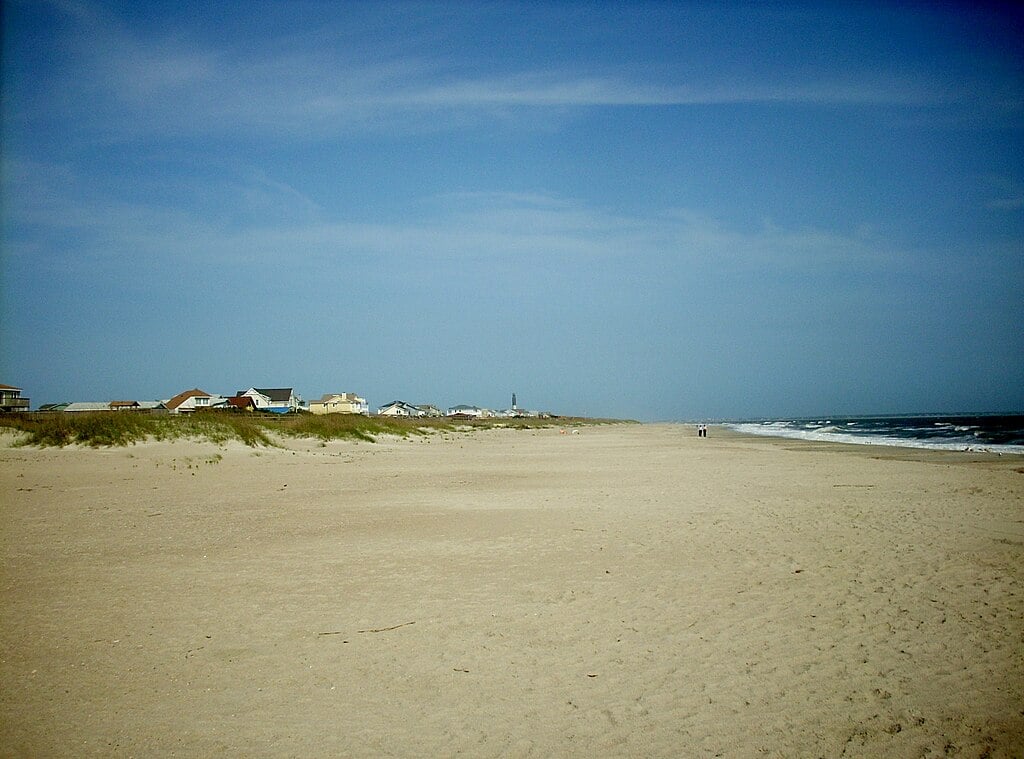
Why are people willing to pay so much to live here? What’s special about it?
Caswell Beach offers the rare combination of pristine oceanfront living with significant historical importance, being home to Fort Caswell and Oak Island Lighthouse. The community maintains a deliberately quiet, residential character that attracts buyers seeking peaceful coastal living without commercial development. Strict building codes and limited development preserve the area’s natural beauty and ensure property values remain stable.
The beach’s wide, uncrowded shoreline provides exceptional privacy compared to more touristy coastal areas in North Carolina. Residents enjoy year-round access to excellent fishing, both from the shore and nearby deep-water access, while being just minutes from the amenities of Southport and Wilmington.
How Caswell Beach Rose to Prominence
Caswell Beach began as a military installation when Fort Caswell was established in 1826 to protect the Cape Fear River entrance. The fort played roles in the Civil War and both World Wars, with the military maintaining control of much of the island through the mid-20th century. When the military finally released control of portions of the island, residential development began in earnest during the 1970s and 1980s.
The community’s incorporation in 1975 allowed residents to implement strict zoning and building regulations that preserved the area’s character while controlling growth. The presence of the historic lighthouse and fort created tourism interest, but the town successfully balanced historical preservation with residential development, creating one of the coast’s most exclusive communities.
3 Interesting Tidbits
1. Lighthouse Legacy – The Oak Island Lighthouse, built in 1958, is one of the newest lighthouses in the United States and the brightest lighthouse in North America, visible for 24 nautical miles.
2. Military Heritage – Fort Caswell served continuously from 1826 to 1946, making it one of the longest-serving coastal fortifications in American history.
3. Turtle Sanctuary – The beach serves as a major nesting ground for loggerhead sea turtles, with the town implementing special lighting ordinances to protect nesting sites.
28. Chapel Hill – 81% Home Price Increase Since 2010
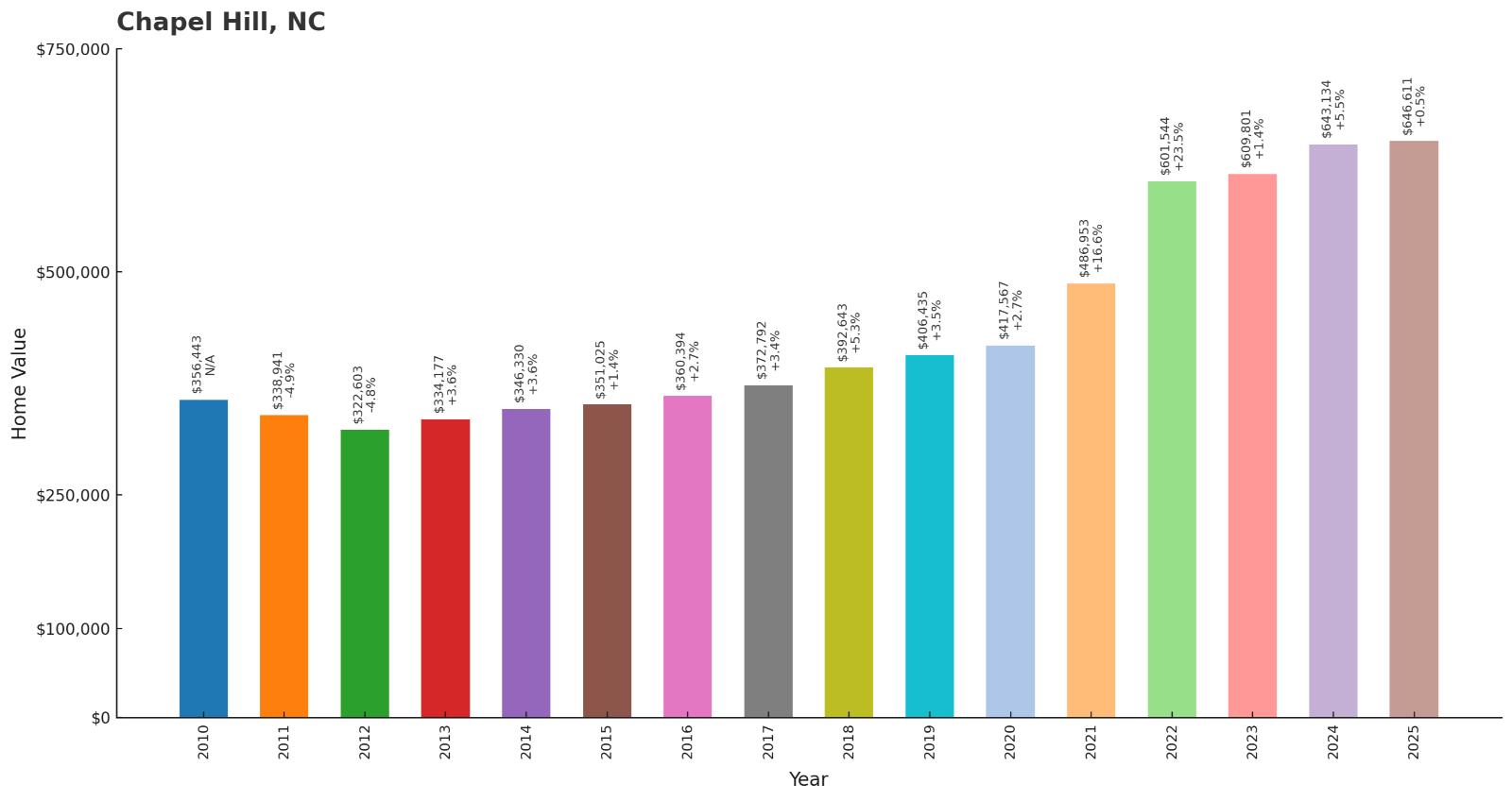
- 2010: $356,443
- 2011: $338,941
- 2012: $322,603
- 2013: $334,177
- 2014: $346,330
- 2015: $351,025
- 2016: $360,394
- 2017: $372,792
- 2018: $392,643
- 2019: $406,435
- 2020: $417,567
- 2021: $486,953
- 2022: $601,544
- 2023: $609,801
- 2024: $643,134
- 2025: $646,611
Chapel Hill recovered from early-decade dips to post an impressive 81% increase since 2010, reaching $646,611 in 2025. The university town saw consistent growth through most years, with acceleration during the pandemic period from 2020-2022. The combination of academic prestige and Research Triangle proximity continues to drive strong demand.
Why Chapel Hill?
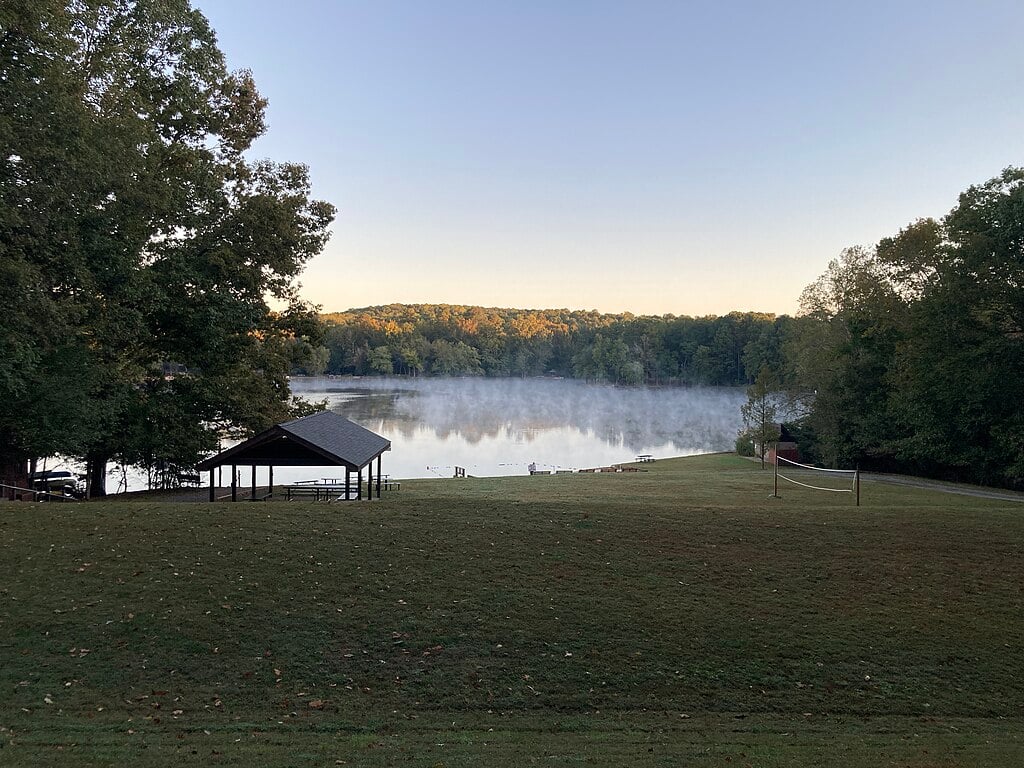
Why are people willing to pay so much to live here? What’s special about it?
Chapel Hill commands premium prices due to its status as home to the University of North Carolina, bringing intellectual vitality and cultural amenities typically found only in major cities. The town offers an exceptional quality of life with top-rated schools, walkable neighborhoods, and a vibrant downtown filled with restaurants, shops, and entertainment venues. Faculty, researchers, and professionals from the Research Triangle compete for limited housing in the most desirable neighborhoods.
The community’s commitment to preserving its small-town character while embracing growth has created neighborhoods that blend historic charm with modern amenities. Residents enjoy easy access to Research Triangle employment opportunities while living in a community that prioritizes education, arts, and environmental sustainability.
How Chapel Hill Rose to Prominence
Chapel Hill was founded in 1793 specifically to house the University of North Carolina, making it one of the first planned university towns in America. The community developed around the campus, with faculty and staff creating a residential area that attracted families who valued education and intellectual pursuits. The town’s growth accelerated significantly during the mid-20th century as the Research Triangle began attracting technology companies and research institutions.
The 1980s and 1990s brought explosive growth as the Research Triangle Park became a nationally recognized hub for technology and pharmaceutical companies. Chapel Hill’s position within this economic boom, combined with the university’s rising national profile, created sustained demand for housing that continues today. The town’s careful growth management has maintained its character while accommodating new residents.
3 Interesting Tidbits
1. Oldest State University – The University of North Carolina at Chapel Hill, chartered in 1789, is the oldest public university in the United States and the only one to award degrees in the 18th century.
2. Basketball Shrine – The Dean Dome (Dean E. Smith Center) is considered the cathedral of college basketball, hosting legendary games that have shaped the sport’s history.
3. Literary Hub – Chapel Hill has produced numerous famous authors and continues to host one of the nation’s most important independent bookstores, Flyleaf Books, supporting a thriving literary community.
27. Henrico – 78% Home Price Increase Since 2012
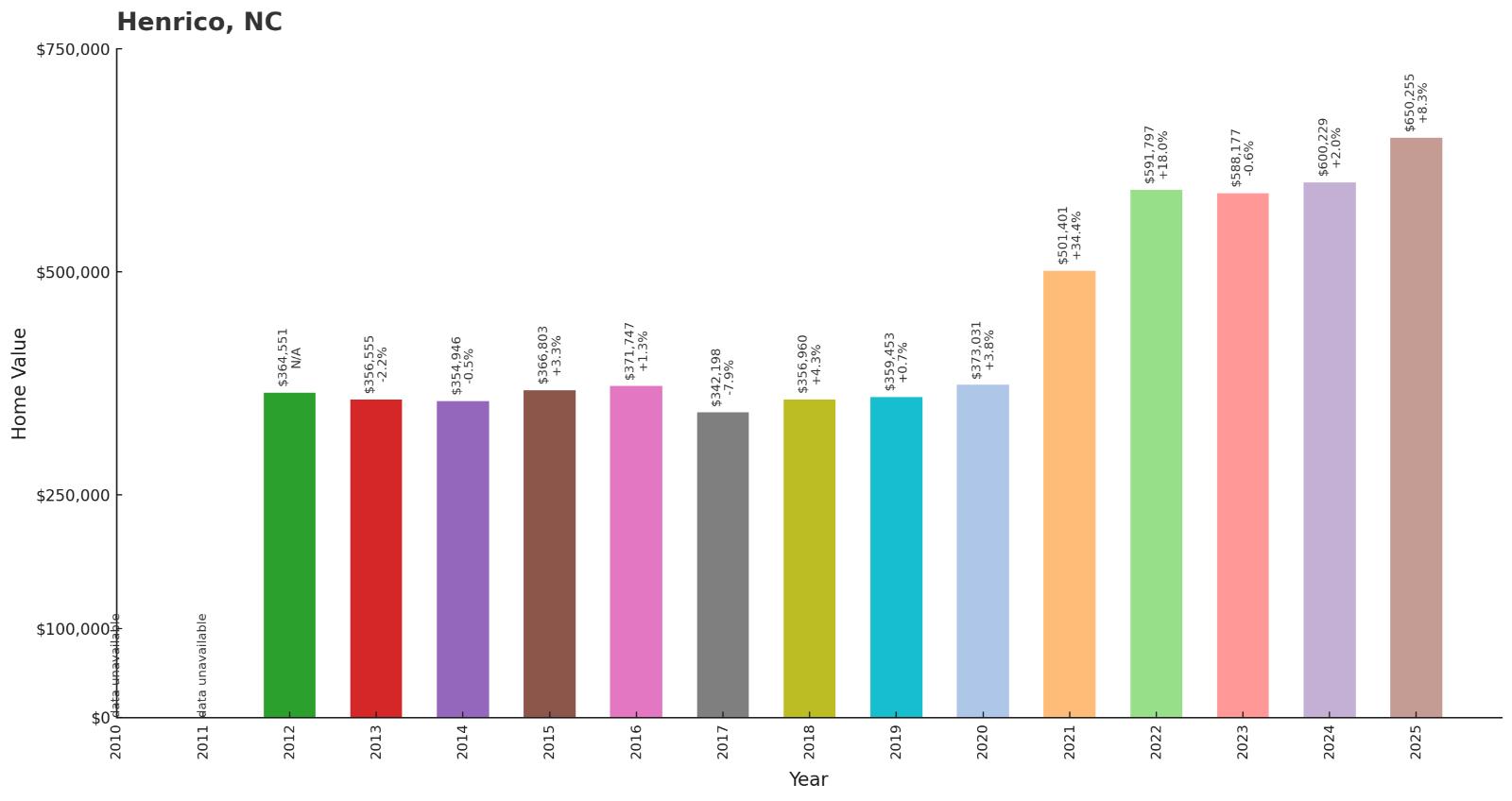
- 2010: N/A
- 2011: N/A
- 2012: $364,551
- 2013: $356,555
- 2014: $354,946
- 2015: $366,803
- 2016: $371,747
- 2017: $342,198
- 2018: $356,960
- 2019: $359,453
- 2020: $373,031
- 2021: $501,401
- 2022: $591,797
- 2023: $588,177
- 2024: $600,229
- 2025: $650,255
Henrico demonstrated remarkable growth from its 2012 baseline, climbing 78% to reach $650,255 in 2025. The community experienced steady appreciation through most years, with dramatic acceleration during 2021-2022 when values jumped from $501,401 to $591,797. Recent growth continues this upward trajectory despite some minor fluctuations.
Why Henrico?
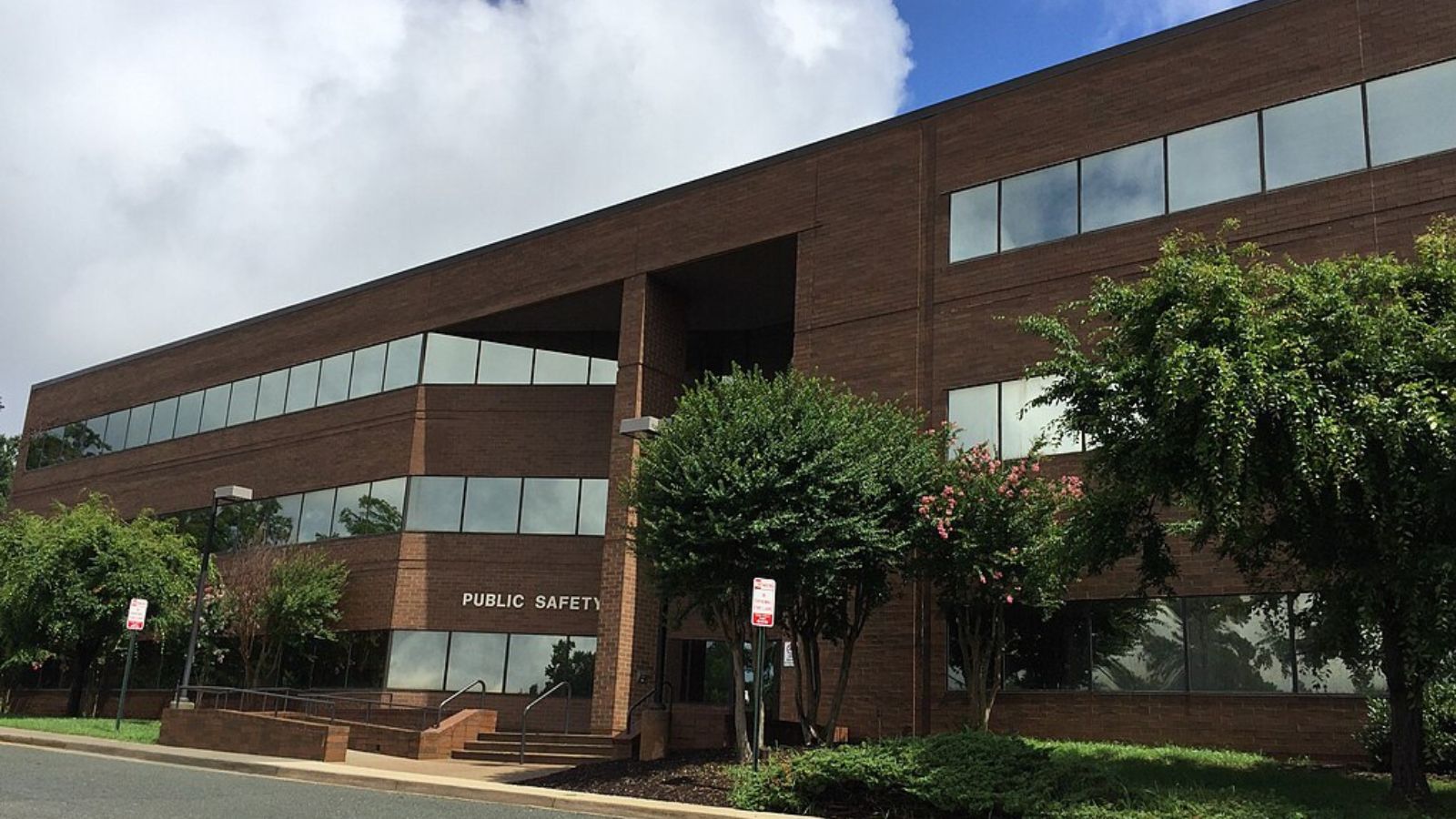
Why are people willing to pay so much to live here? What’s special about it?
Henrico attracts buyers seeking suburban luxury with excellent access to Charlotte’s employment centers and cultural amenities. The community offers newer construction, larger lots, and top-rated schools that appeal to professionals and executives looking for premium housing options. Residents value the area’s careful development that maintains a residential feel while providing modern conveniences and amenities.
The location provides the perfect balance of suburban tranquility and urban accessibility, allowing residents to enjoy quiet neighborhoods while remaining connected to Charlotte’s business and entertainment districts. High-quality construction standards and community amenities create a premium living experience that justifies the elevated home prices.
How Henrico Rose to Prominence
Henrico developed as Charlotte’s metropolitan area expanded outward during the late 20th century, transforming from rural farmland into an upscale suburban community. The area attracted attention from developers and homebuyers during the 1990s as Charlotte’s banking and business sectors experienced rapid growth, creating demand for luxury housing within commuting distance of the city center.
The community’s growth accelerated during the 2000s as Charlotte solidified its position as a major financial center, attracting executives and professionals who sought high-quality housing options. Careful planning and zoning regulations ensured that development maintained high standards, creating the premium residential community that commands today’s elevated prices.
3 Interesting Tidbits
1. Banking Hub Proximity – Henrico’s location provides easy access to Charlotte’s banking district, home to major financial institutions including Bank of America’s corporate headquarters.
2. Educational Excellence – The area is served by some of North Carolina’s highest-rated school districts, making it particularly attractive to families with children.
3. Master-Planned Growth – Unlike many suburban areas that grew organically, Henrico benefited from comprehensive planning that ensured quality infrastructure and amenities from the beginning.
26. Kitty Hawk – 106% Home Price Increase Since 2010

- 2010: $316,156
- 2011: $300,645
- 2012: $303,835
- 2013: $317,319
- 2014: $322,921
- 2015: $323,331
- 2016: $328,642
- 2017: $349,119
- 2018: $369,519
- 2019: $380,704
- 2020: $386,705
- 2021: $496,786
- 2022: $626,958
- 2023: $646,010
- 2024: $650,232
- 2025: $651,474
Kitty Hawk achieved remarkable 106% growth since 2010, more than doubling from $316,156 to $651,474 by 2025. The Outer Banks community showed steady appreciation through most years, with explosive growth during 2021-2022 when prices jumped from $496,786 to $626,958. This performance reflects the area’s growing appeal as both a vacation destination and investment opportunity.
Why Kitty Hawk?

Why are people willing to pay so much to live here? What’s special about it?
Kitty Hawk offers the perfect combination of aviation history, pristine beaches, and Outer Banks charm without the crowds of more touristy areas. The community provides excellent access to both ocean and sound activities, with residents enjoying world-class fishing, surfing, and boating opportunities year-round. The area’s connection to the Wright Brothers’ first flight adds cultural significance that appeals to history enthusiasts and aviation fans.
Unlike some Outer Banks communities that are purely seasonal, Kitty Hawk maintains a year-round residential population that creates a genuine community feel. The town offers modern amenities and services while preserving the laid-back coastal lifestyle that makes the Outer Banks so appealing to visitors and residents alike.
How Kitty Hawk Rose to Prominence
Kitty Hawk gained worldwide fame in 1903 when Orville and Wilbur Wright chose the area for their historic first powered flight, attracted by the steady winds and isolated location. The community remained relatively quiet for decades, serving primarily as a fishing village and occasional destination for adventurous tourists willing to make the difficult journey to the Outer Banks.
The opening of reliable road access to the mainland in the 1930s began transforming Kitty Hawk from an isolated fishing community into a viable residential area. Tourism growth accelerated after World War II, and the establishment of the Wright Brothers National Memorial brought steady visitors. By the 1980s and 1990s, improved infrastructure and the growing popularity of coastal living turned Kitty Hawk into one of the Outer Banks’ most desirable residential communities.
3 Interesting Tidbits
1. First Flight Fame – Kitty Hawk is forever linked to aviation history as the site of the Wright Brothers’ first powered flight on December 17, 1903.
2. Hang Gliding Capital – Jockey’s Ridge State Park in nearby Nags Head, easily accessible from Kitty Hawk, is considered the hang gliding capital of the East Coast due to its massive sand dunes.
3. Wild Horse Connection – The area’s name possibly derives from the Algonquian word “chickahauk,” and wild horses once roamed freely throughout the Outer Banks, including the Kitty Hawk area.
25. Wesley Chapel – 119% Home Price Increase Since 2010

- 2010: $297,588
- 2011: $279,282
- 2012: $274,275
- 2013: $291,365
- 2014: $309,922
- 2015: $321,768
- 2016: $335,532
- 2017: $357,541
- 2018: $371,769
- 2019: $386,451
- 2020: $405,133
- 2021: $492,161
- 2022: $617,889
- 2023: $609,370
- 2024: $649,103
- 2025: $652,609
Wesley Chapel posted exceptional 119% growth since 2010, climbing from $297,588 to $652,609 by 2025. The community showed consistent year-over-year appreciation through most of the period, with significant acceleration during 2021-2022. This Charlotte-area suburb has become increasingly attractive to buyers seeking newer construction and excellent schools.
Why Wesley Chapel?
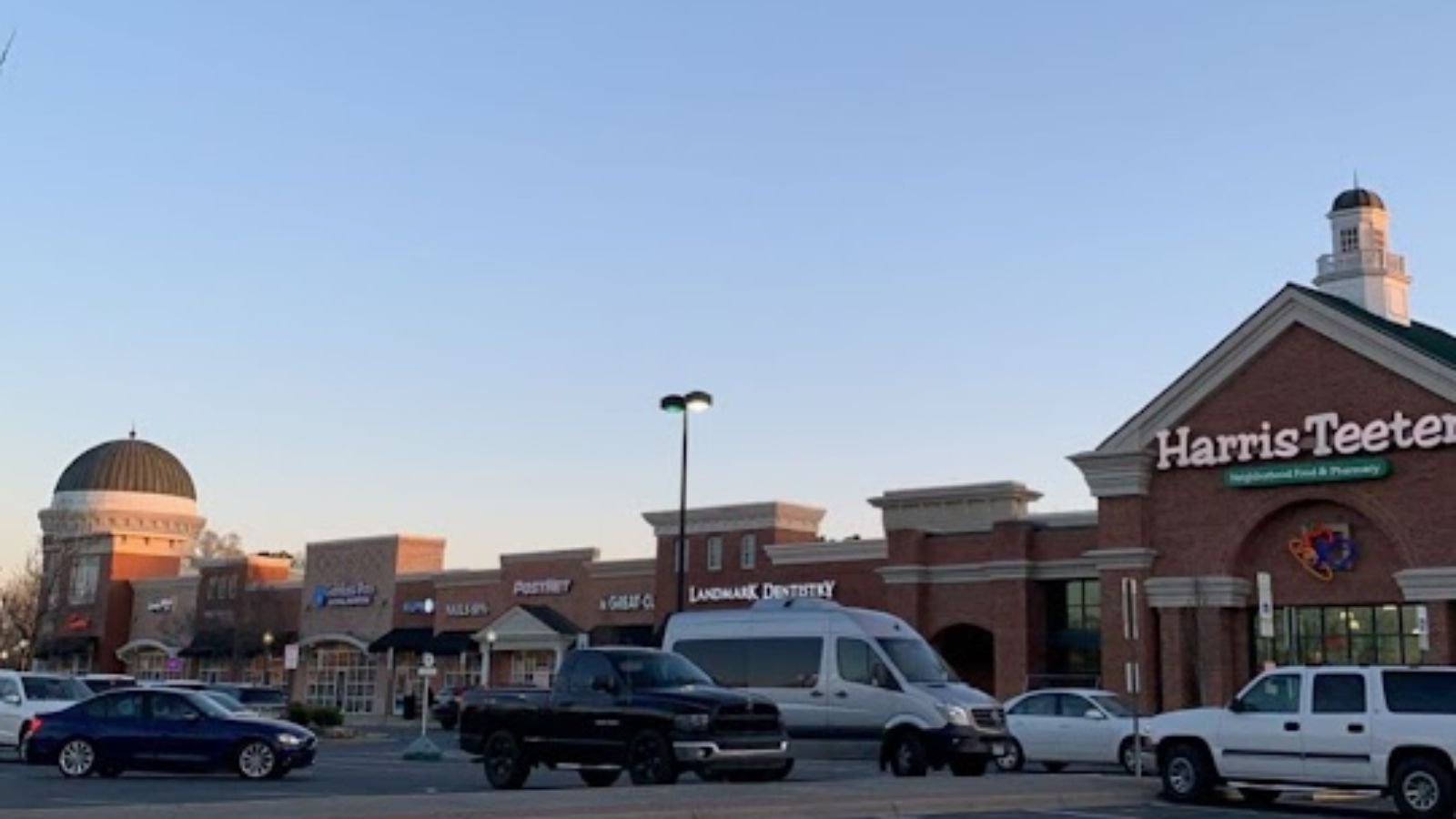
Why are people willing to pay so much to live here? What’s special about it?
Wesley Chapel attracts families and professionals seeking modern suburban living with top-rated schools and newer construction within the Charlotte metropolitan area. The community offers larger lots, contemporary home designs, and excellent access to both Charlotte’s employment centers and recreational amenities. Residents appreciate the area’s careful development that prioritizes quality construction and community amenities.
The location provides the ideal balance for families who want suburban tranquility without sacrificing access to urban opportunities. Excellent schools, safe neighborhoods, and modern infrastructure create an attractive package for buyers willing to pay premium prices for quality of life and long-term investment potential.
How Wesley Chapel Rose to Prominence
Wesley Chapel developed as Charlotte’s metropolitan area expanded outward during the 1990s and 2000s, transforming from rural farmland into a master-planned suburban community. The area attracted attention from developers who recognized the potential for high-quality residential development within commuting distance of Charlotte’s growing business districts.
The community’s growth accelerated as Charlotte solidified its position as a major banking and business center, creating demand for upscale suburban housing. Careful planning ensured that development maintained high standards for construction quality, schools, and community amenities, establishing Wesley Chapel as one of the region’s premier suburban destinations.
3 Interesting Tidbits
1. Planned Community Success – Wesley Chapel represents one of the most successful examples of master-planned suburban development in the Charlotte region.
2. School District Excellence – The area is served by highly-rated school districts that consistently rank among the best in North Carolina, driving residential demand.
3. Corporate Proximity – Strategic location provides easy access to major corporate centers and Charlotte Douglas International Airport, appealing to business professionals.
24. Salvo – 92% Home Price Increase Since 2012

- 2010: N/A
- 2011: N/A
- 2012: $344,460
- 2013: $366,420
- 2014: $370,151
- 2015: $359,462
- 2016: $368,878
- 2017: $382,513
- 2018: $393,528
- 2019: $410,207
- 2020: $407,786
- 2021: $504,587
- 2022: $654,878
- 2023: $648,424
- 2024: $669,210
- 2025: $662,039
Salvo achieved strong 92% growth since 2012, rising from $344,460 to $662,039 by 2025. This Outer Banks community showed steady appreciation through most years, with dramatic growth during 2021-2022 when values jumped from $504,587 to $654,878. The village’s location on Hatteras Island provides unique appeal for buyers seeking authentic Outer Banks living.
Why Salvo?
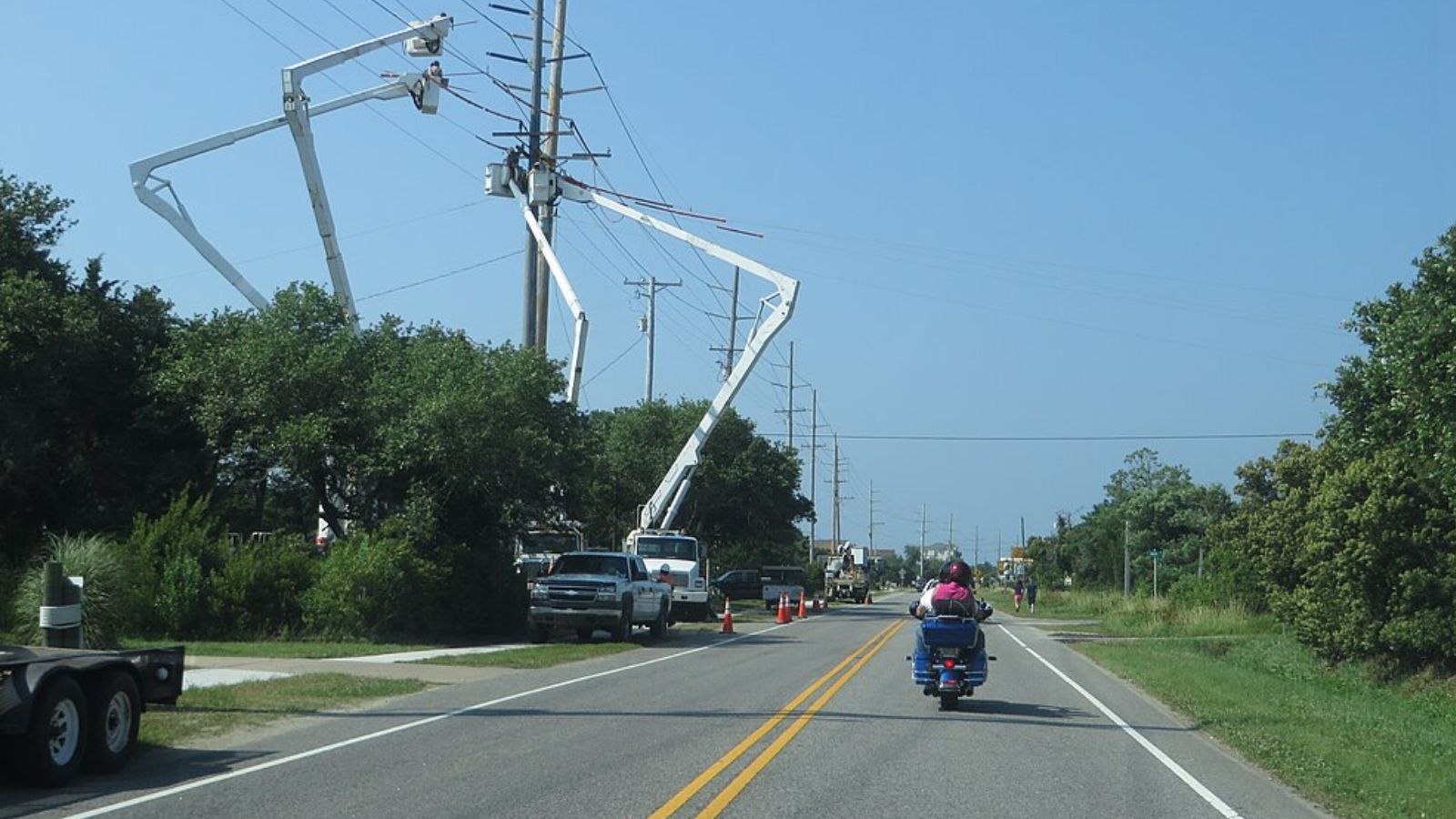
Why are people willing to pay so much to live here? What’s special about it?
Salvo offers an authentic Outer Banks experience on Hatteras Island, where residents enjoy uncrowded beaches and genuine fishing village character. The community provides access to world-renowned fishing grounds both offshore and in the Pamlico Sound, making it a paradise for serious anglers and water sports enthusiasts. Unlike more developed areas, Salvo maintains its small-town charm while offering modern conveniences.
The village’s location provides the perfect escape from urban life, with residents enjoying stunning sunrises over the Atlantic and sunsets over the sound. The area offers excellent rental income potential due to its popularity with vacationers seeking an authentic coastal experience away from crowded tourist areas.
How Salvo Rose to Prominence
Salvo began as a small fishing village on Hatteras Island, with early settlers attracted by the area’s exceptional fishing opportunities and strategic location between the Atlantic Ocean and Pamlico Sound. The community remained relatively isolated until improved road access and ferry service in the mid-20th century began bringing visitors to the area.
The village’s growth as a residential and vacation destination accelerated during the 1980s and 1990s as the Outer Banks gained popularity. Salvo’s authentic character and excellent fishing attracted buyers seeking a genuine coastal lifestyle, while its location within the Cape Hatteras National Seashore ensured protection from overdevelopment. The community’s reputation for world-class fishing and peaceful coastal living has driven steady appreciation in property values.
3 Interesting Tidbits
1. Fishing Paradise – Salvo is considered one of the premier fishing destinations on the East Coast, with easy access to both surf fishing and deep-sea fishing opportunities.
2. National Seashore Protection – The village’s location within Cape Hatteras National Seashore provides permanent protection from commercial development and overdevelopment.
3. Shipwreck History – The waters off Salvo are part of the “Graveyard of the Atlantic,” with numerous shipwrecks creating artificial reefs that attract marine life and diving enthusiasts.
23. Davidson – 116% Home Price Increase Since 2010

- 2010: $307,051
- 2011: $289,046
- 2012: $293,818
- 2013: $306,432
- 2014: $319,027
- 2015: $337,156
- 2016: $357,801
- 2017: $371,414
- 2018: $385,991
- 2019: $401,282
- 2020: $417,484
- 2021: $503,244
- 2022: $616,326
- 2023: $611,424
- 2024: $654,854
- 2025: $662,468
Davidson demonstrated impressive 116% growth since 2010, more than doubling from $307,051 to $662,468 by 2025. This college town showed consistent year-over-year appreciation through most years, with significant acceleration during 2021-2022 when values jumped from $503,244 to $616,326. The combination of Davidson College prestige and Charlotte proximity continues driving strong demand.
Why Davidson?
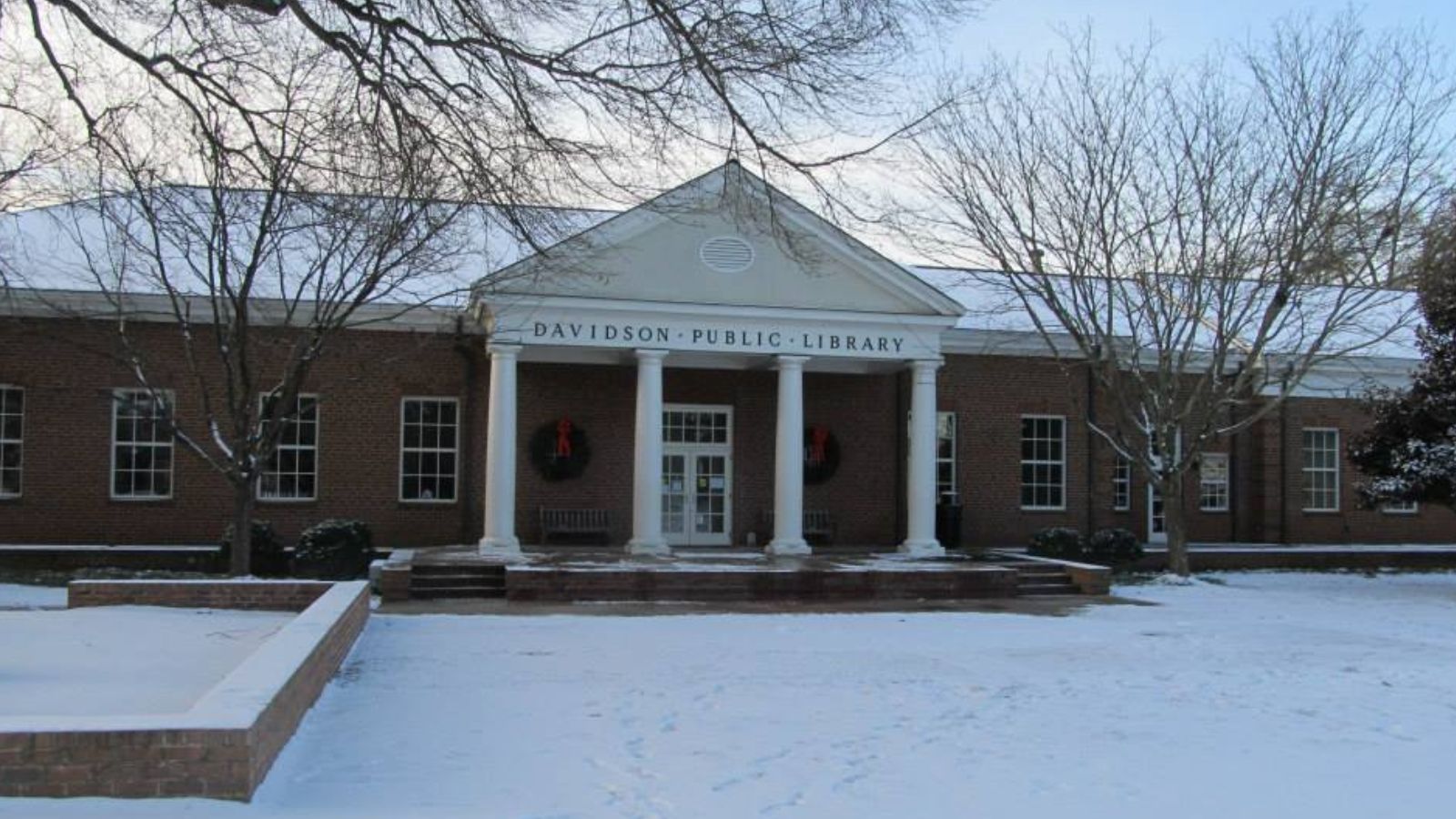
Why are people willing to pay so much to live here? What’s special about it?
Davidson commands premium prices due to its prestigious liberal arts college and charming small-town atmosphere within the Charlotte metropolitan area. The community offers exceptional schools, walkable neighborhoods, and cultural amenities that rival much larger cities, all while maintaining its historic character and sense of community. Residents value the intellectual environment created by the college and the town’s commitment to preserving its unique identity.
The location provides easy access to Charlotte’s employment opportunities while offering a completely different lifestyle from typical suburban communities. Davidson’s combination of academic excellence, historic charm, and modern amenities creates a premium living experience that attracts professionals, academics, and families seeking quality over quantity.
How Davidson Rose to Prominence
Davidson was founded in 1837 around Davidson College, creating a classic American college town that has maintained its character for nearly two centuries. The community developed as faculty, staff, and families attracted to the college’s academic excellence established homes in the surrounding area. The town’s growth remained modest and controlled for much of its history, preserving the intimate scale that makes it special.
The community’s transformation into a highly desirable residential area accelerated during the 1980s and 1990s as Charlotte’s economy expanded and professionals began seeking alternatives to typical suburban development. Davidson’s unique combination of small-town charm, academic prestige, and proximity to major employment centers created sustained demand that continues to drive property values upward.
3 Interesting Tidbits
1. Presidential Connection – Davidson College alumnus Woodrow Wilson served as the 28th President of the United States, and the town maintains strong ties to political and academic leadership.
2. Basketball Legacy – NBA star Stephen Curry played basketball at Davidson College, helping put the small school and town on the national map during his remarkable college career.
3. Historic Preservation – Davidson maintains one of North Carolina’s most successful historic preservation programs, ensuring that growth doesn’t compromise the community’s character and charm.
22. Montreat – 26% Home Price Increase Since 2021
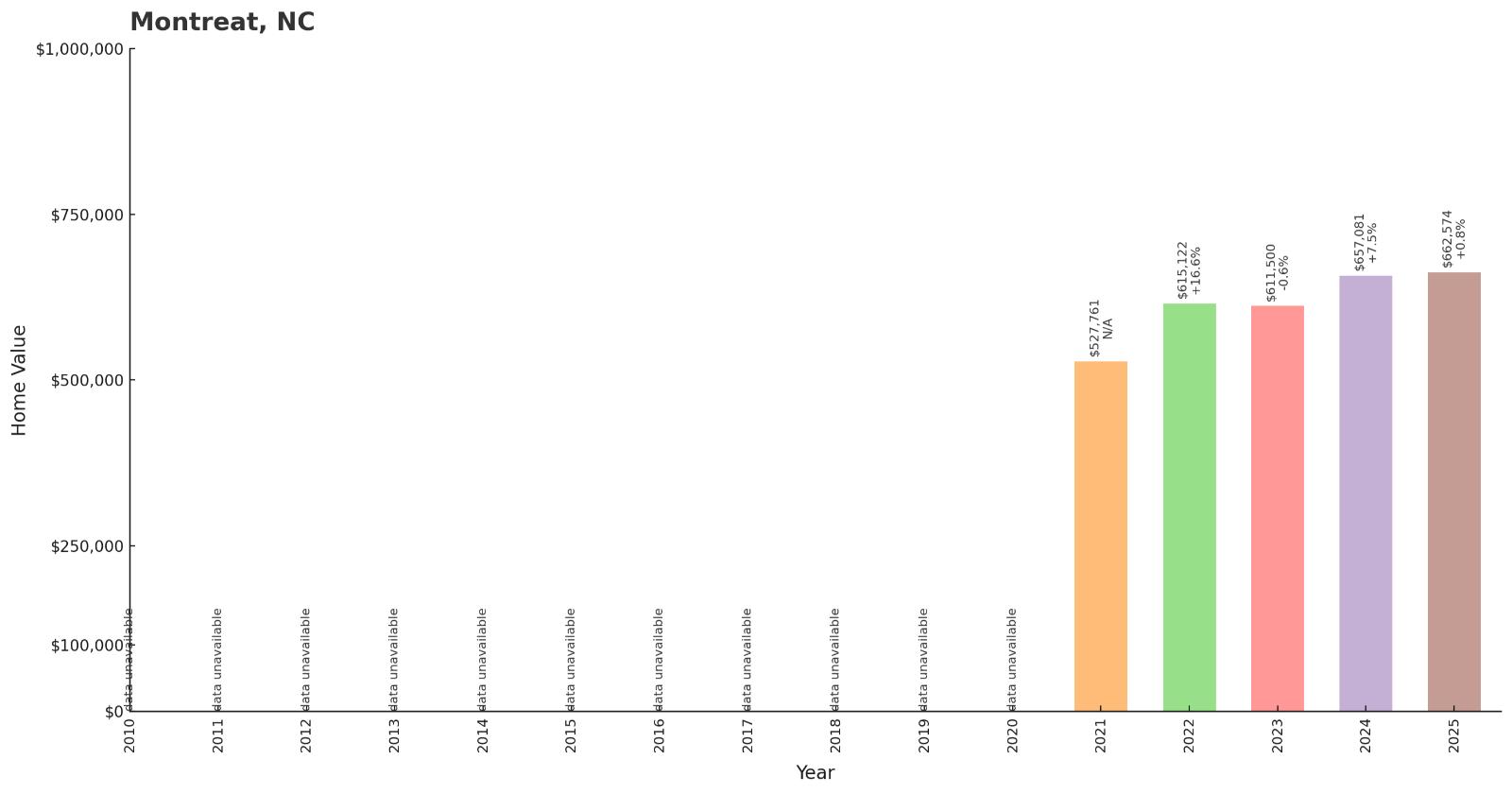
- 2010: N/A
- 2011: N/A
- 2012: N/A
- 2013: N/A
- 2014: N/A
- 2015: N/A
- 2016: N/A
- 2017: N/A
- 2018: N/A
- 2019: N/A
- 2020: N/A
- 2021: $527,761
- 2022: $615,122
- 2023: $611,500
- 2024: $657,081
- 2025: $662,574
Montreat showed solid 26% growth since data became available in 2021, rising from $527,761 to $662,574 by 2025. This mountain retreat community experienced initial growth through 2022, followed by slight adjustment in 2023 before resuming upward trajectory. Limited data reflects the community’s exclusive nature and restricted development patterns.
Why Montreat?

Why are people willing to pay so much to live here? What’s special about it?
Montreat offers an extraordinary combination of natural beauty and spiritual heritage, nestled in a pristine mountain valley near Asheville. The community provides a unique living experience centered around Montreat College and the historic conference center that has hosted religious and educational gatherings for over a century. Residents enjoy hiking trails, mountain streams, and a close-knit community atmosphere that’s increasingly rare in today’s world.
The town’s commitment to preserving its natural environment and historic character creates a living experience unlike anywhere else in North Carolina. Strict development guidelines and the presence of educational and spiritual institutions ensure that Montreat maintains its peaceful, contemplative atmosphere while providing modern conveniences and excellent access to Asheville’s amenities.
How Montreat Rose to Prominence
Montreat was established in 1897 as a Christian retreat and conference center, founded by John Collins Prestwood who envisioned a mountain sanctuary for religious and educational gatherings. The community developed around this mission, with carefully planned infrastructure designed to support conferences, retreats, and summer programs while preserving the area’s natural beauty.
The founding of Montreat College in 1916 added an educational component that attracted year-round residents and established the community’s reputation for academic and spiritual excellence. Throughout the 20th century, Montreat hosted numerous prominent religious and political leaders, building a national reputation that continues to attract buyers seeking a unique mountain lifestyle with historic significance.
3 Interesting Tidbits
1. Presidential Retreat – Montreat served as a frequent retreat location for several U.S. presidents, including connections to the Billy Graham family who maintained a home in the community.
2. Gated Community Origins – Montreat was one of America’s first planned gated communities, designed from the beginning to control access and preserve its unique character.
3. Conference Legacy – The Montreat Conference Center has hosted religious and educational gatherings for over 125 years, making it one of the longest-operating conference facilities in the Southeast.
21. New Hill – 158% Home Price Increase Since 2010
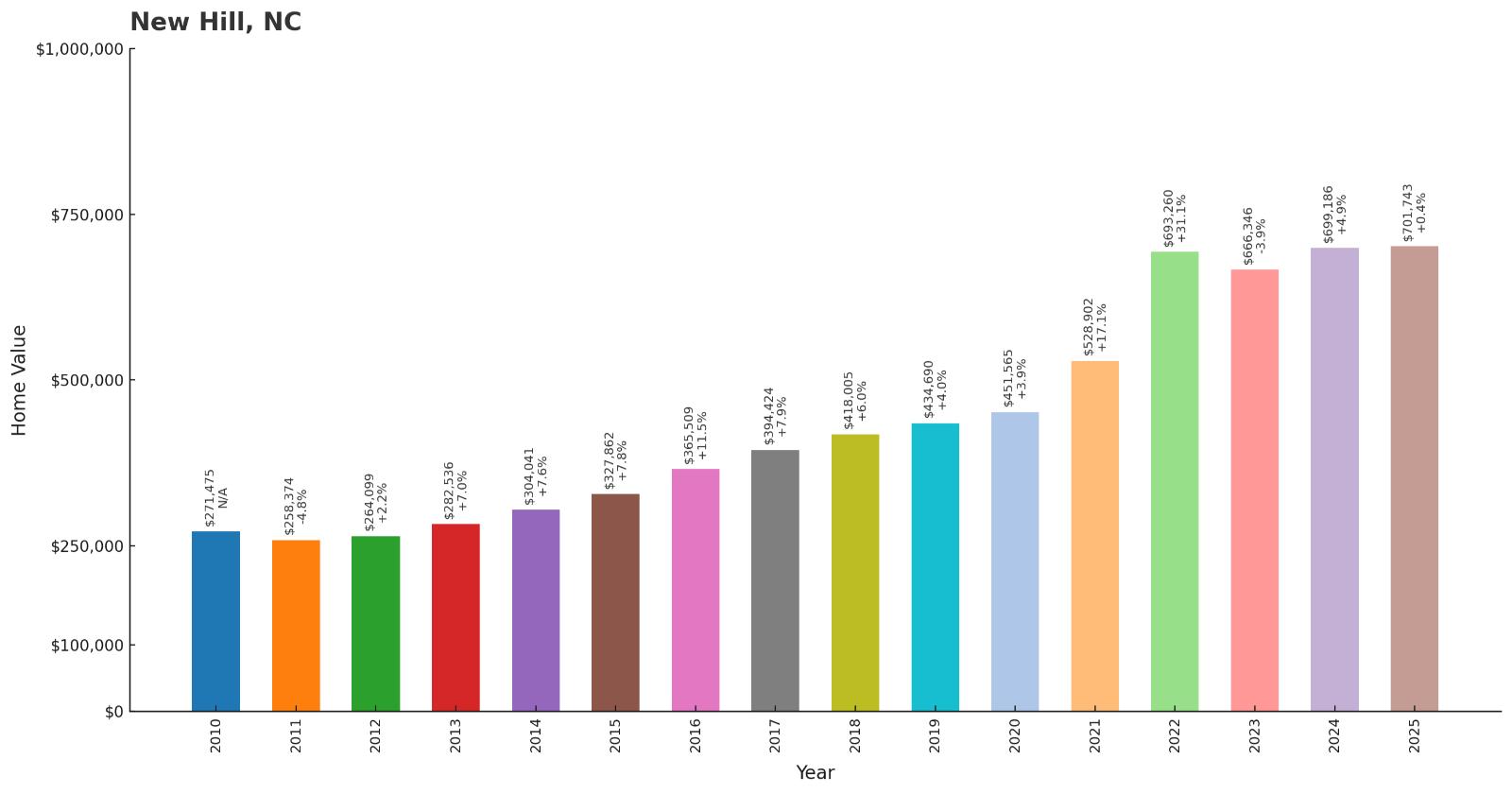
- 2010: $271,475
- 2011: $258,374
- 2012: $264,099
- 2013: $282,536
- 2014: $304,041
- 2015: $327,862
- 2016: $365,509
- 2017: $394,424
- 2018: $418,005
- 2019: $434,690
- 2020: $451,565
- 2021: $528,902
- 2022: $693,260
- 2023: $666,346
- 2024: $699,186
- 2025: $701,743
New Hill achieved remarkable 158% growth since 2010, rising from $271,475 to $701,743 by 2025. This Research Triangle community showed consistent appreciation through most years, with explosive growth during 2021-2022 when values jumped from $528,902 to $693,260. The community’s strategic location and excellent schools continue attracting buyers willing to pay premium prices.
Why New Hill?
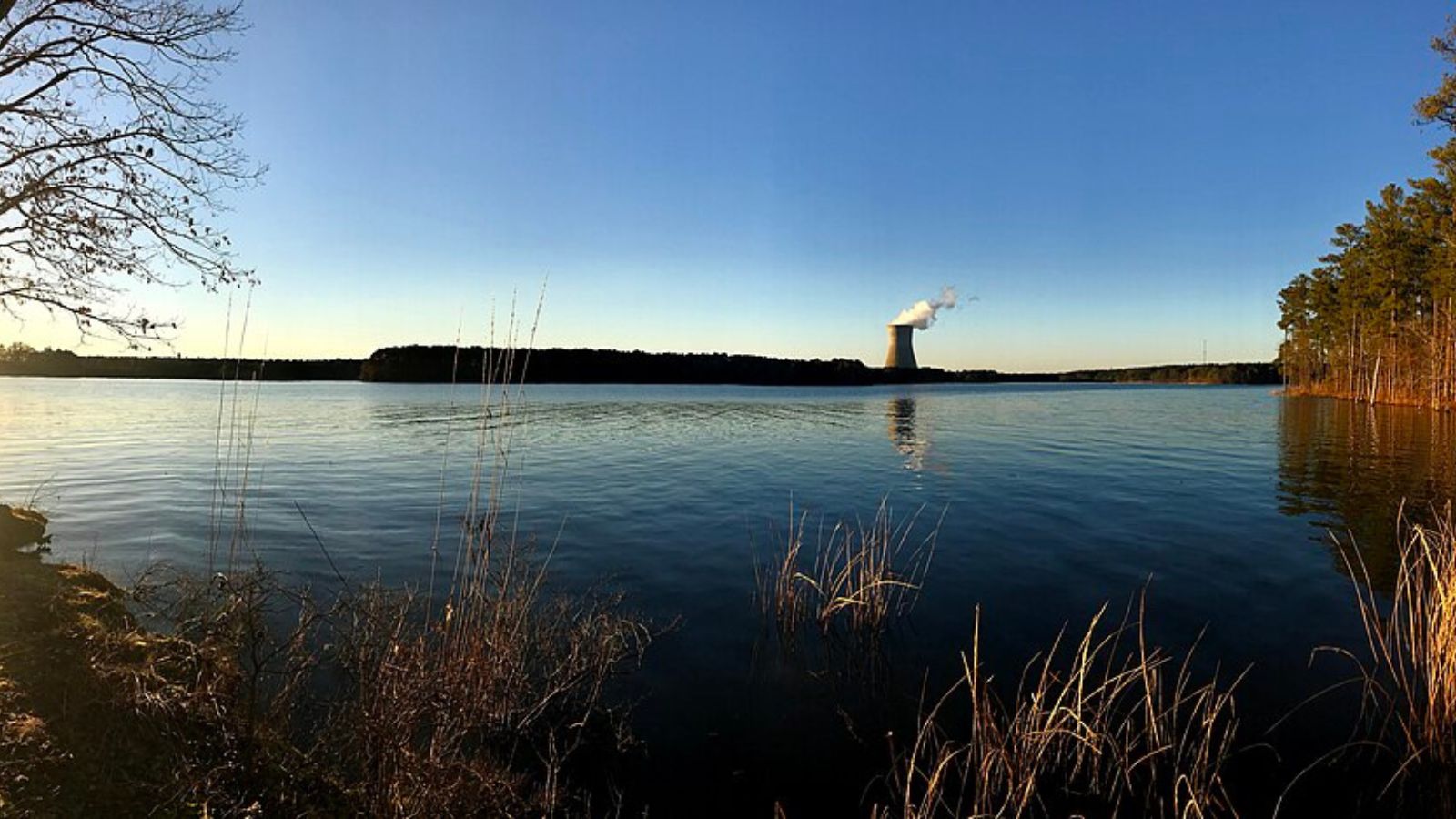
Why are people willing to pay so much to live here? What’s special about it?
New Hill attracts professionals and executives seeking upscale suburban living within the Research Triangle area, offering newer construction and larger lots than more established communities. The area provides excellent access to RTP, Cary, and Raleigh employment centers while maintaining a more residential, less congested feel than closer-in suburbs. Residents appreciate the combination of modern amenities, top-rated schools, and room to spread out.
The community’s rapid development has focused on quality construction and family-friendly amenities that appeal to affluent buyers looking for long-term investment potential. Strategic location provides the best of both worlds—proximity to Research Triangle opportunities with the space and privacy that comes from being slightly further out from urban centers.
How New Hill Rose to Prominence
New Hill transformed from rural farmland into an upscale suburban community during the Research Triangle’s explosive growth period of the 1990s and 2000s. The area attracted attention from developers and homebuyers as nearby areas like Cary and Apex became increasingly expensive and crowded, creating demand for quality housing options with more space and privacy.
The community’s growth accelerated as the Research Triangle Park and surrounding areas solidified their positions as major employment centers, creating sustained demand from professionals and executives seeking high-quality housing within reasonable commuting distance. Careful development and excellent schools established New Hill as one of the region’s premier residential communities.
3 Interesting Tidbits
1. Research Triangle Access – New Hill provides easy access to RTP, one of the largest research parks in the world, home to major technology and pharmaceutical companies.
2. Rural Heritage – Despite rapid suburban development, the area maintains connections to its agricultural past with preserved farmland and rural roads creating a unique suburban-rural blend.
3. School Excellence – The area is served by highly-rated Wake County schools, including some of the most sought-after elementary and high schools in the state.
20. Lake Toxaway – 134% Home Price Increase Since 2010
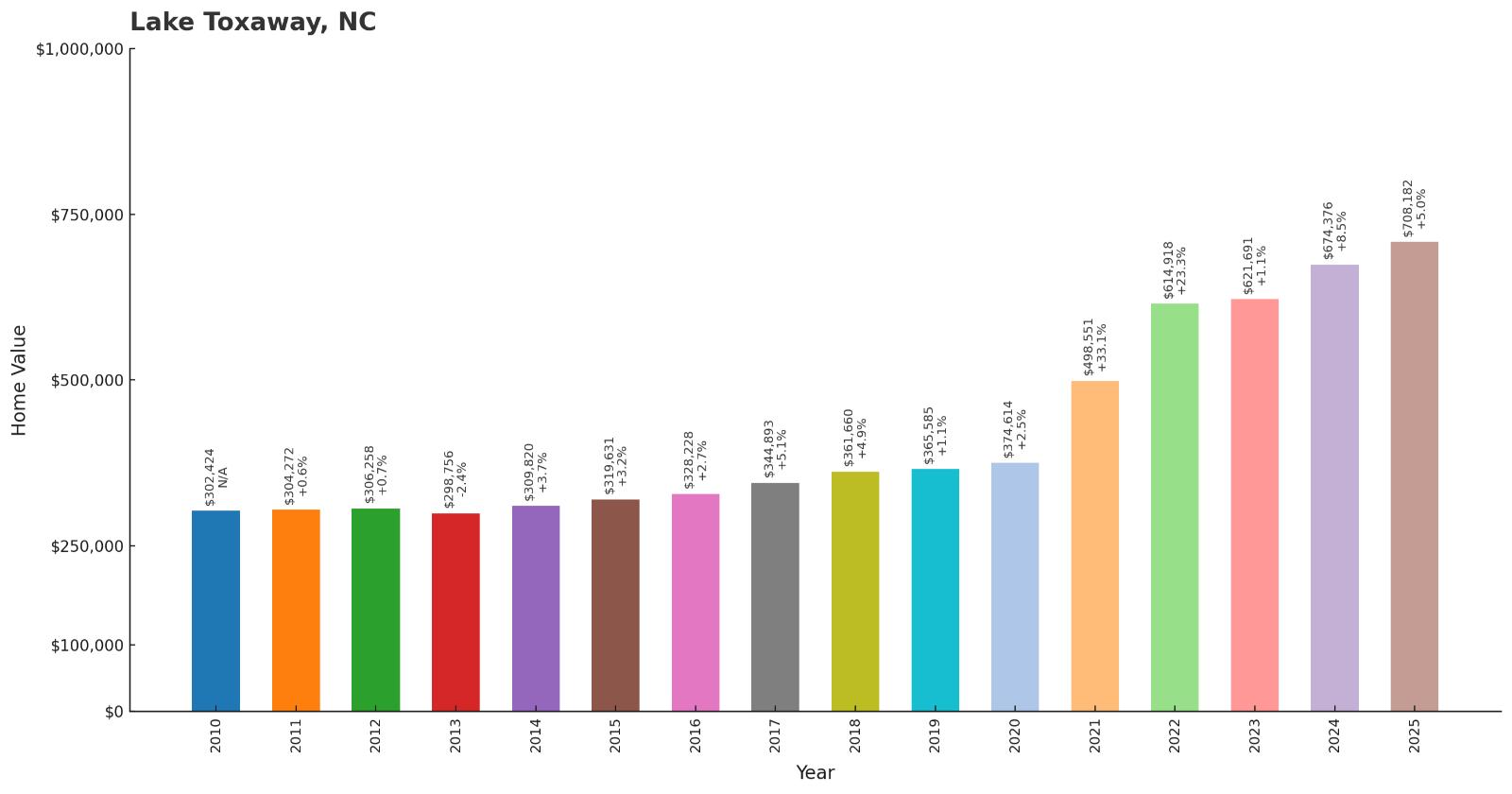
- 2010: $302,424
- 2011: $304,272
- 2012: $306,258
- 2013: $298,756
- 2014: $309,820
- 2015: $319,631
- 2016: $328,228
- 2017: $344,893
- 2018: $361,660
- 2019: $365,585
- 2020: $374,614
- 2021: $498,551
- 2022: $614,918
- 2023: $621,691
- 2024: $674,376
- 2025: $708,182
Lake Toxaway achieved impressive 134% growth since 2010, rising from $302,424 to $708,182 by 2025. This mountain lake community showed steady appreciation through most years, with significant acceleration during 2021-2022 when values jumped from $498,551 to $614,918. Recent strong performance continues this upward trajectory in one of western North Carolina’s most exclusive communities.
Why Lake Toxaway?
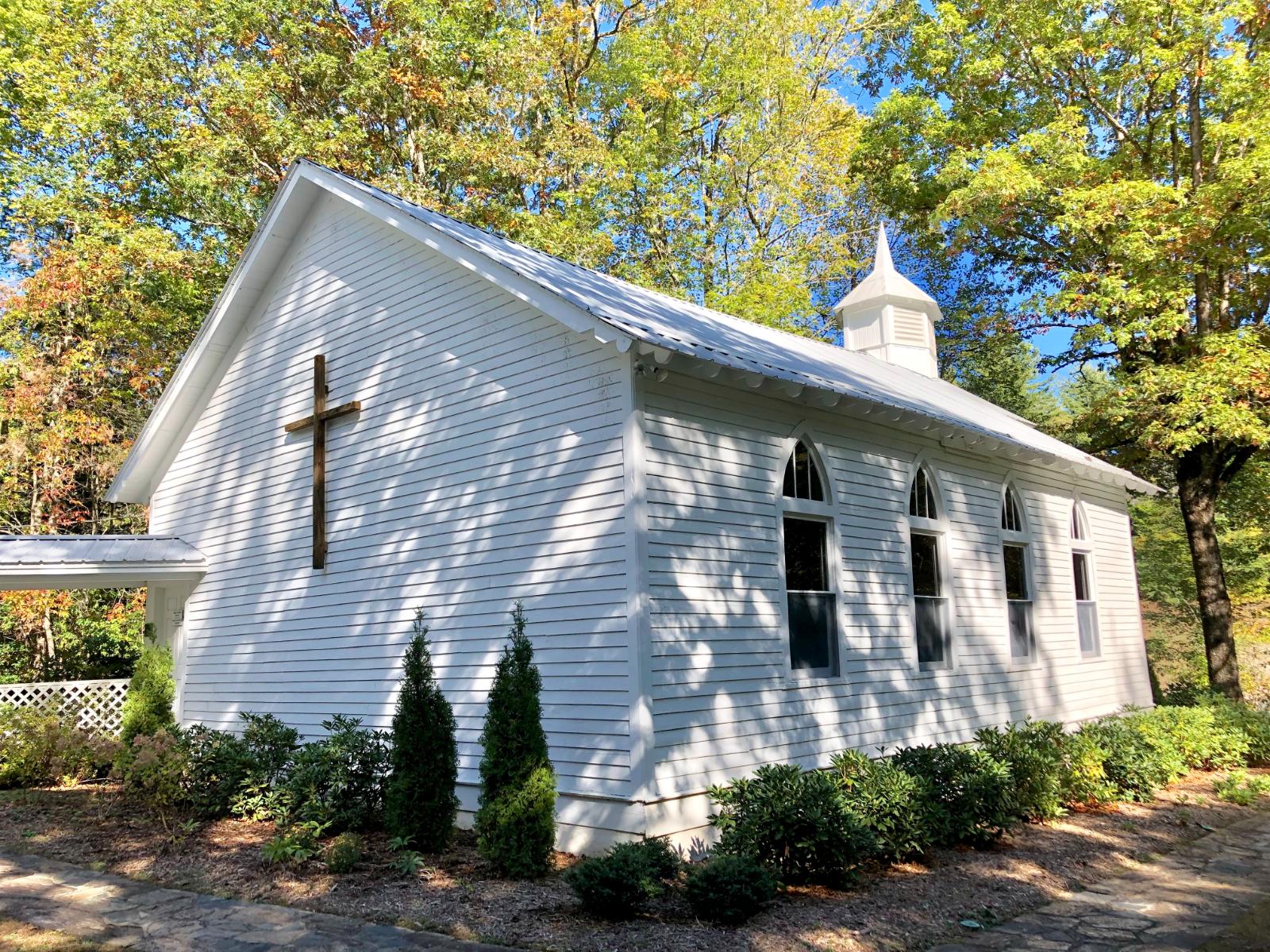
Why are people willing to pay so much to live here? What’s special about it?
Lake Toxaway offers an exclusive mountain lake lifestyle in western North Carolina, featuring pristine waters surrounded by luxury homes and world-class amenities. The community provides residents with access to water sports, fishing, golf, and hiking in one of the region’s most scenic settings. The private lake and controlled development ensure that property values remain stable while maintaining the area’s natural beauty and exclusivity.
Residents enjoy a resort-like lifestyle year-round, with amenities that include marina facilities, golf courses, and recreational programs that create a true community atmosphere. The location provides easy access to Asheville and other mountain destinations while offering complete privacy and luxury amenities that justify premium pricing.
How Lake Toxaway Rose to Prominence
Lake Toxaway was originally created in 1903 when developers built a dam to create what was then the largest private lake in North Carolina. The early community attracted wealthy families from across the Southeast who built grand summer “cottages” along the lake’s shores. After the original dam failed in 1916, the lake remained mostly dry until the 1960s when new developers reconstructed the dam and began developing the modern resort community.
The community’s transformation into one of North Carolina’s most exclusive residential areas began in earnest during the 1970s and 1980s as the mountains gained popularity as a year-round destination. Careful planning and restrictive covenants ensured that development maintained high standards while preserving the area’s natural beauty, creating the luxury mountain community that commands today’s premium prices.
3 Interesting Tidbits
1. Private Lake Paradise – Lake Toxaway is North Carolina’s largest private lake, covering 640 acres with 14 miles of pristine shoreline restricted to property owners and their guests.
2. Historic Resort Legacy – The original Lake Toxaway Inn, built in 1903, was one of the South’s most elegant mountain resorts before the dam failure, attracting wealthy families from across the region.
3. Elevation Excellence – At 3,010 feet elevation, Lake Toxaway enjoys cool summers and mild winters that make it appealing as both a year-round residence and seasonal retreat.
19. Saint James – 80% Home Price Increase Since 2010
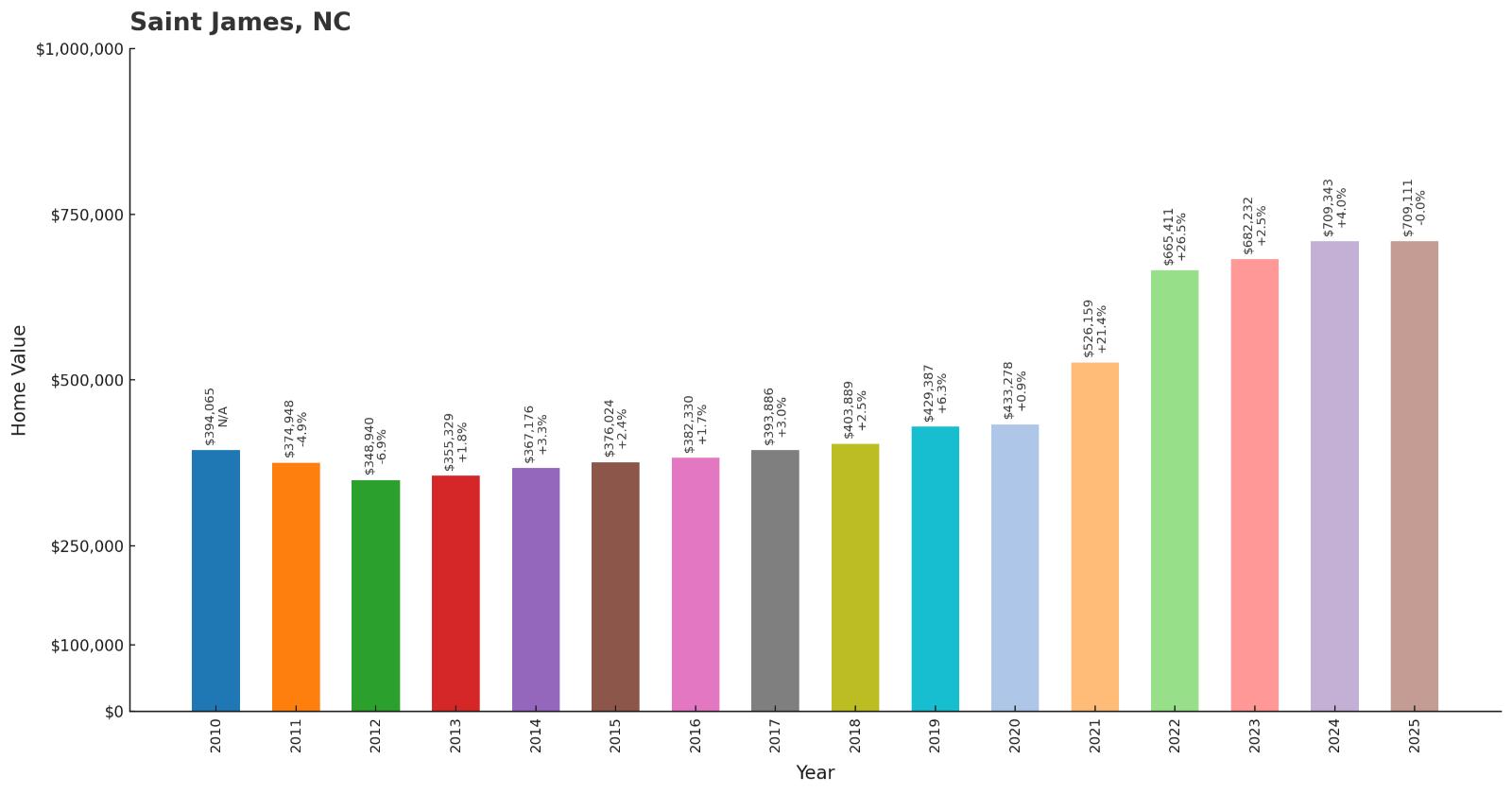
- 2010: $394,065
- 2011: $374,948
- 2012: $348,940
- 2013: $355,329
- 2014: $367,176
- 2015: $376,024
- 2016: $382,330
- 2017: $393,886
- 2018: $403,889
- 2019: $429,387
- 2020: $433,278
- 2021: $526,159
- 2022: $665,411
- 2023: $682,232
- 2024: $709,343
- 2025: $709,111
Saint James demonstrated solid 80% growth since 2010, rising from $394,065 to $709,111 by 2025. This coastal community recovered from early-decade declines to show strong appreciation, with dramatic acceleration during 2021-2022 when values jumped from $526,159 to $665,411. The area’s golf course communities and waterfront access continue driving premium pricing.
Why Saint James?
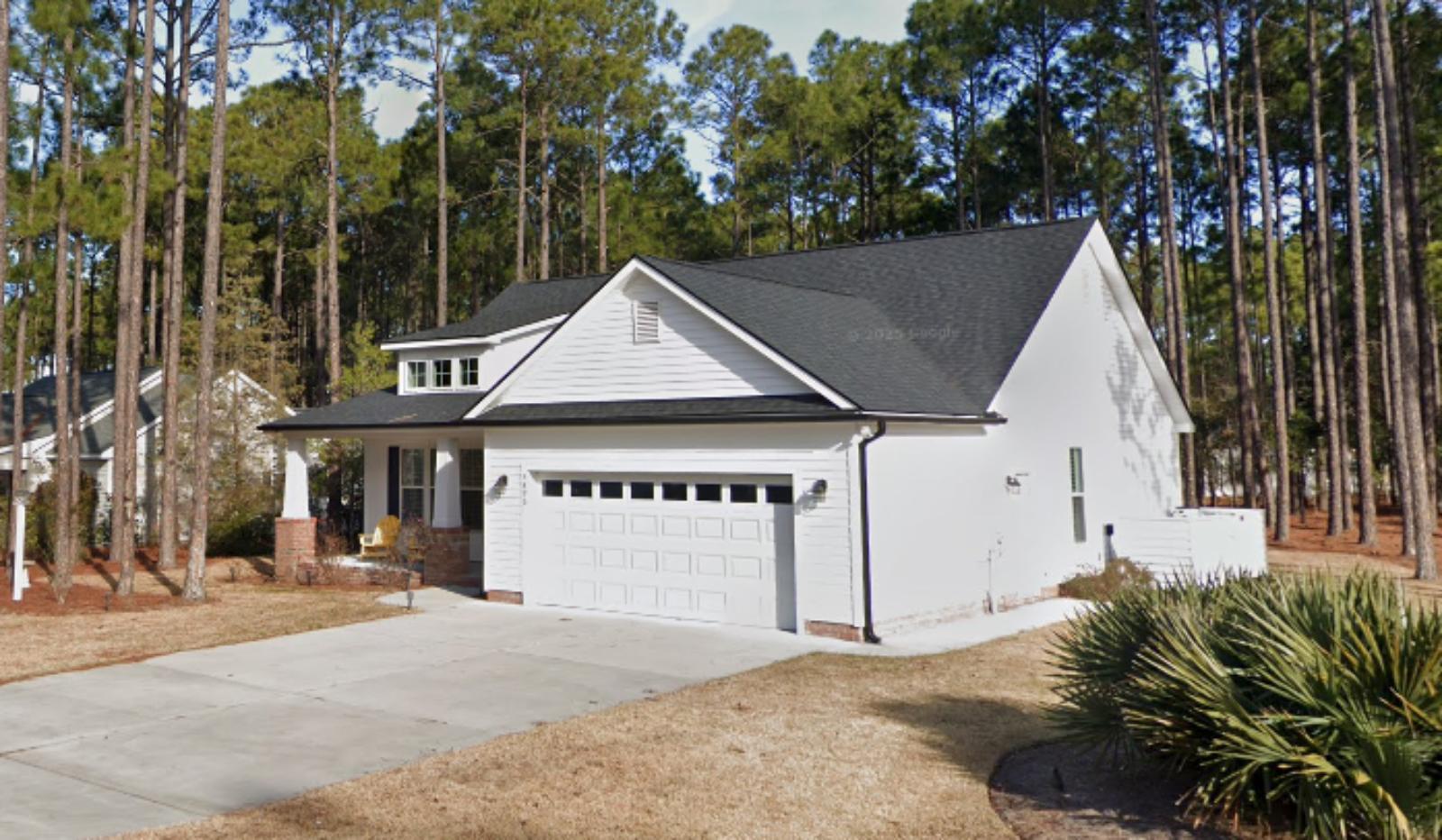
Why are people willing to pay so much to live here? What’s special about it?
Saint James attracts buyers seeking upscale coastal living with golf course amenities and waterfront access in southeastern North Carolina. The community offers a resort-like lifestyle with multiple golf courses, marina facilities, and luxury amenities that appeal to retirees and second-home buyers. Residents enjoy the combination of small-town charm and sophisticated recreational opportunities within easy reach of larger cities.
The area provides excellent value compared to more expensive coastal destinations while offering similar amenities and lifestyle opportunities. Strategic location near the Brunswick County coast provides access to beaches, boating, and fishing while maintaining affordable luxury living that attracts buyers from across the Southeast.
How Saint James Rose to Prominence
Saint James began as a small coastal community in Brunswick County, developing slowly as a fishing and agricultural area through most of the 20th century. The community’s transformation began during the 1980s and 1990s when developers recognized the area’s potential for golf course communities and waterfront development, taking advantage of the location’s natural beauty and relatively affordable land prices.
The area’s growth accelerated as southeastern North Carolina gained popularity as a retirement destination, with Saint James offering an attractive alternative to more expensive coastal areas like the Outer Banks or Charleston. The development of high-quality golf courses and marina facilities established the community as a destination for affluent buyers seeking coastal lifestyle amenities at more reasonable prices.
3 Interesting Tidbits
1. Golf Paradise – Saint James is home to multiple championship golf courses designed by renowned architects, making it a premier destination for golf enthusiasts.
2. Intracoastal Access – The community provides residents with easy access to the Intracoastal Waterway, offering excellent boating and fishing opportunities.
3. Retirement Haven – Saint James has become one of southeastern North Carolina’s most popular retirement communities, offering amenities and lifestyle options that appeal to active adults.
18. Pine Knoll Shores – 97% Home Price Increase Since 2010
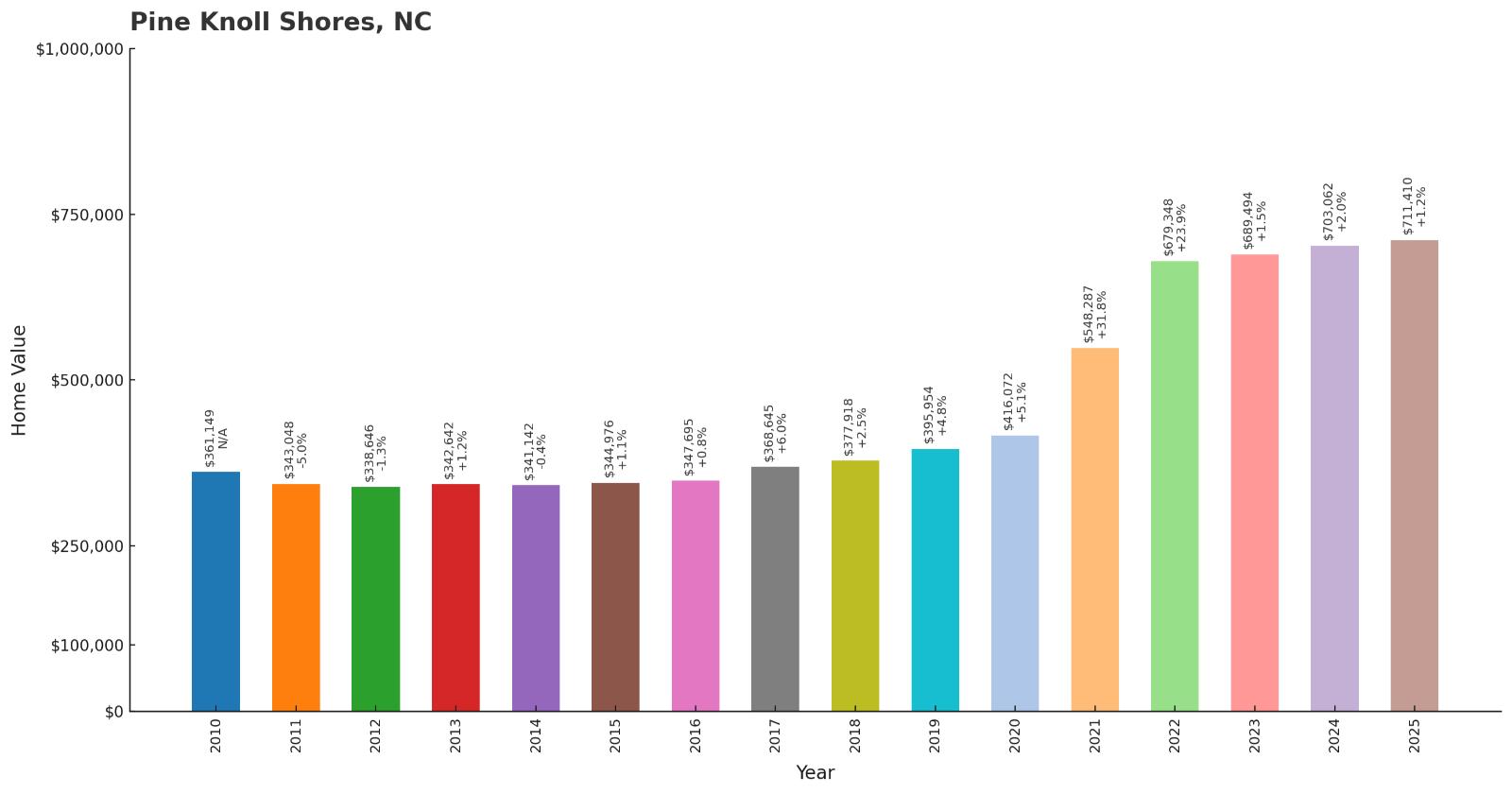
- 2010: $361,149
- 2011: $343,048
- 2012: $338,646
- 2013: $342,642
- 2014: $341,142
- 2015: $344,976
- 2016: $347,695
- 2017: $368,645
- 2018: $377,918
- 2019: $395,954
- 2020: $416,072
- 2021: $548,287
- 2022: $679,348
- 2023: $689,494
- 2024: $703,062
- 2025: $711,410
Pine Knoll Shores achieved strong 97% growth since 2010, nearly doubling from $361,149 to $711,410 by 2025. This Crystal Coast community showed steady appreciation through most years, with significant acceleration during 2021-2022 when values jumped from $548,287 to $679,348. The area’s pristine beaches and controlled development continue attracting premium prices.
Why Pine Knoll Shores?

Why are people willing to pay so much to live here? What’s special about it?
Pine Knoll Shores offers an exclusive coastal lifestyle on Bogue Banks with pristine beaches and carefully controlled development that preserves the area’s natural beauty. The community provides residents with access to excellent fishing, boating, and beach activities while maintaining a peaceful, residential atmosphere away from commercial tourist areas. Strict building codes and environmental protections ensure that property values remain stable and the coastal environment stays pristine.
Residents enjoy year-round coastal living with amenities that include the North Carolina Maritime Museum and Fort Macon State Park nearby, providing cultural and recreational opportunities beyond the beach. The community’s commitment to environmental preservation and quality development creates a premium living experience that justifies higher home prices.
How Pine Knoll Shores Rose to Prominence
Pine Knoll Shores was developed as a planned community on Bogue Banks during the 1970s, with developers focusing on creating an upscale coastal community that preserved the area’s maritime forests and natural beauty. The community was designed with strict environmental guidelines and architectural standards that maintained the coastal character while providing modern amenities.
The area’s growth as a premier coastal destination accelerated during the 1980s and 1990s as the Crystal Coast gained recognition for its pristine beaches and excellent fishing. Pine Knoll Shores’ commitment to controlled development and environmental preservation distinguished it from other coastal communities, attracting buyers willing to pay premium prices for quality and exclusivity.
3 Interesting Tidbits
1. Maritime Forest Preservation – Pine Knoll Shores maintains one of the few remaining maritime forests on the North Carolina coast, providing unique natural beauty and environmental protection.
2. Aquarium Connection – The community is home to the North Carolina Maritime Museum, which features exhibits on local marine life and coastal history.
3. Planned Community Pioneer – Pine Knoll Shores was one of the first planned coastal communities in North Carolina to prioritize environmental preservation alongside development.
17. Nags Head – 91% Home Price Increase Since 2010
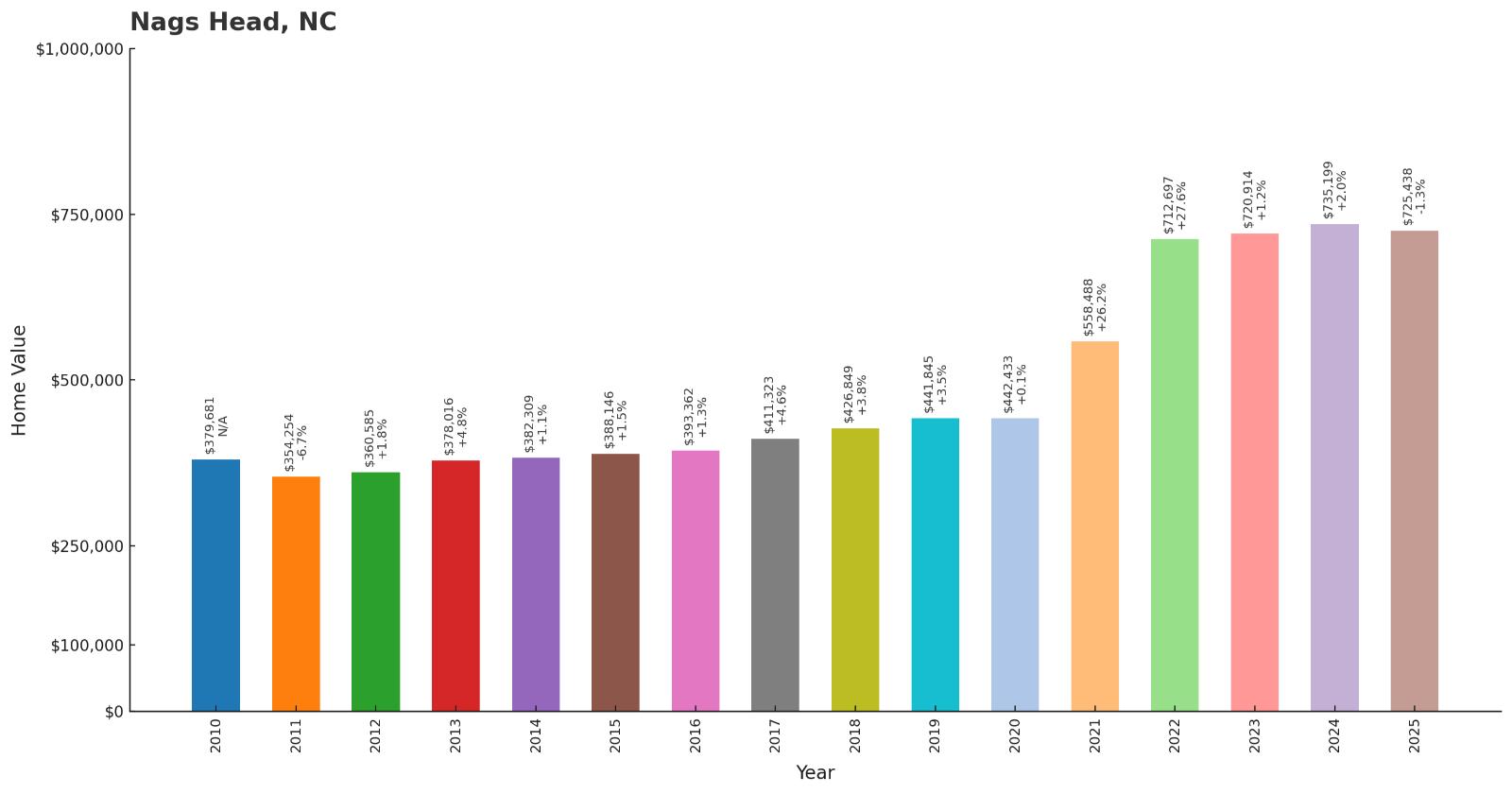
- 2010: $379,681
- 2011: $354,254
- 2012: $360,585
- 2013: $378,016
- 2014: $382,309
- 2015: $388,146
- 2016: $393,362
- 2017: $411,323
- 2018: $426,849
- 2019: $441,845
- 2020: $442,433
- 2021: $558,488
- 2022: $712,697
- 2023: $720,914
- 2024: $735,199
- 2025: $725,438
Nags Head achieved impressive 91% growth since 2010, rising from $379,681 to $725,438 by 2025. This iconic Outer Banks destination showed consistent appreciation through most years, with explosive growth during 2021-2022 when values jumped from $558,488 to $712,697. The community’s central location and tourist appeal continue driving strong investment returns.
Why Nags Head?

Why are people willing to pay so much to live here? What’s special about it?
Nags Head combines iconic Outer Banks character with excellent rental income potential and year-round recreational opportunities. The community offers residents access to pristine beaches, world-class fishing, and historic attractions like Jockey’s Ridge State Park, home to the largest natural sand dune system on the East Coast. The area’s central location provides easy access to both northern and southern Outer Banks destinations while maintaining its own distinct identity.
Property owners benefit from strong vacation rental demand due to Nags Head’s reputation as a premier beach destination with attractions for all ages. The combination of natural beauty, recreational opportunities, and investment potential creates a compelling package for buyers willing to pay premium prices for Outer Banks real estate.
How Nags Head Rose to Prominence
Nags Head gained fame as one of the first beach resort destinations on the Outer Banks, with wealthy families from inland North Carolina building summer cottages there beginning in the 1830s. The community’s growth accelerated after the Civil War as improved transportation made the area more accessible to visitors seeking cool summer breezes and excellent fishing.
The area’s transformation into a major tourist destination occurred during the mid-20th century with the construction of bridges and improved roads that made year-round access possible. Nags Head’s central location and diverse attractions, including Jockey’s Ridge and proximity to the Wright Brothers Memorial, established it as a hub for Outer Banks tourism and a premier location for both vacation homes and investment properties.
3 Interesting Tidbits
1. Jockey’s Ridge Legacy – Nags Head is home to Jockey’s Ridge State Park, featuring the tallest natural sand dunes on the East Coast and a mecca for hang gliding enthusiasts.
2. First Resort – Nags Head was one of the first established beach resort communities in North Carolina, with a history of attracting visitors dating back to the 1830s.
3. Shipwreck Stories – The town’s name allegedly comes from the practice of tying lanterns to horses’ necks to lure ships onto the shoals, though this colorful story is likely more legend than fact.
16. Emerald Isle – 84% Home Price Increase Since 2010
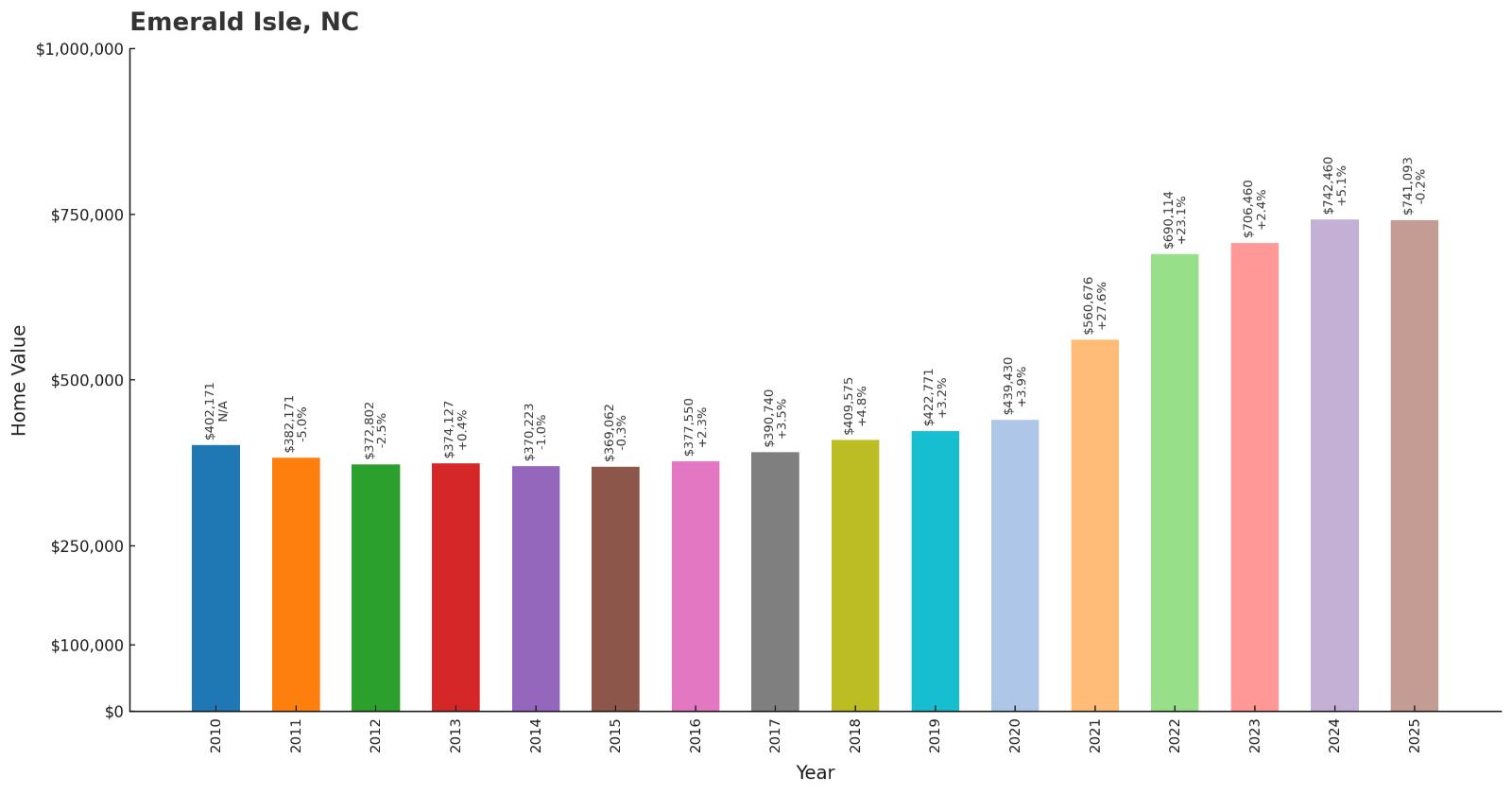
- 2010: $402,171
- 2011: $382,171
- 2012: $372,802
- 2013: $374,127
- 2014: $370,223
- 2015: $369,062
- 2016: $377,550
- 2017: $390,740
- 2018: $409,575
- 2019: $422,771
- 2020: $439,430
- 2021: $560,676
- 2022: $690,114
- 2023: $706,460
- 2024: $742,460
- 2025: $741,093
Emerald Isle posted solid 84% growth since 2010, rising from $402,171 to $741,093 by 2025. This Crystal Coast community showed steady recovery from early-decade lows, with dramatic acceleration during 2021-2022 when values jumped from $560,676 to $690,114. The island’s pristine beaches and family-friendly atmosphere continue attracting premium buyers.
Why Emerald Isle?
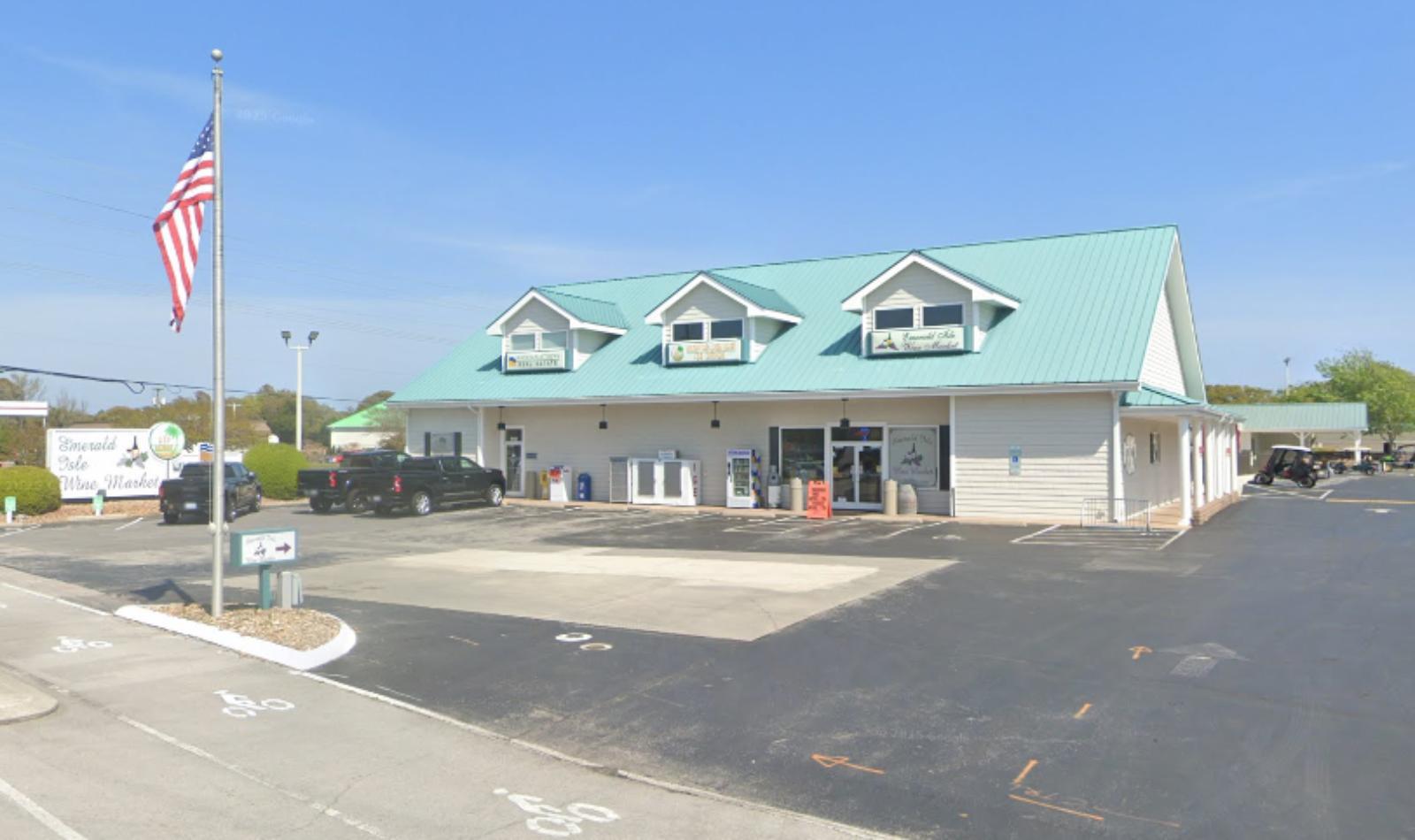
Why are people willing to pay so much to live here? What’s special about it?
Emerald Isle offers an exceptional family-friendly beach destination with some of North Carolina’s most beautiful and uncrowded beaches on Bogue Banks. The community provides excellent access to both ocean and sound activities, with residents enjoying world-class fishing, boating, and water sports in a more relaxed setting than many other coastal areas. The island’s careful development and environmental protection create a premium coastal experience.
Property owners benefit from strong vacation rental income due to the area’s popularity with families seeking clean beaches and safe swimming conditions. The combination of natural beauty, recreational opportunities, and excellent rental potential makes Emerald Isle an attractive investment for buyers seeking both lifestyle and financial returns.
How Emerald Isle Rose to Prominence
Emerald Isle developed as a beach community during the 1950s and 1960s when the first bridge to Bogue Banks made the area accessible to mainland visitors. Early development focused on creating a family-oriented destination with an emphasis on preserving the natural environment and maintaining wide, clean beaches that distinguished it from more commercialized coastal areas.
The community’s growth accelerated during the 1980s and 1990s as the Crystal Coast gained recognition as one of North Carolina’s premier coastal destinations. Emerald Isle’s commitment to controlled development and environmental protection, combined with its excellent beaches and family-friendly atmosphere, established it as a top choice for both vacation homes and permanent residences.
3 Interesting Tidbits
1. Turtle Paradise – Emerald Isle serves as an important nesting ground for loggerhead sea turtles, with the community implementing lighting ordinances to protect nesting sites.
2. Crystal Coast Gem – The island is considered the crown jewel of the Crystal Coast, named for the exceptionally clear waters and pristine sand beaches.
3. Family Tradition – Many families have been visiting Emerald Isle for multiple generations, creating a loyal following that supports strong property values and rental demand.
15. Blowing Rock – 93% Home Price Increase Since 2010
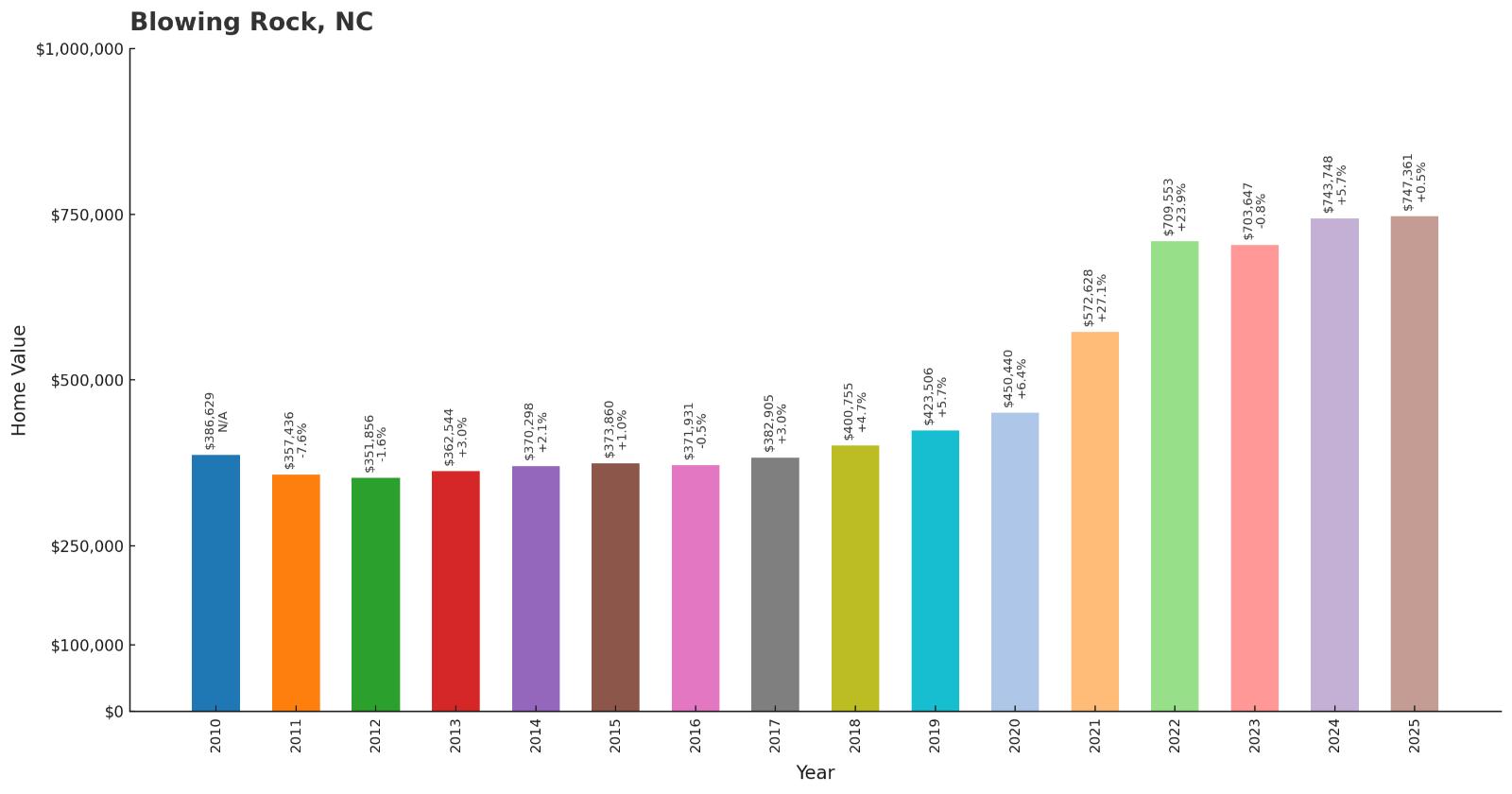
- 2010: $386,629
- 2011: $357,436
- 2012: $351,856
- 2013: $362,544
- 2014: $370,298
- 2015: $373,860
- 2016: $371,931
- 2017: $382,905
- 2018: $400,755
- 2019: $423,506
- 2020: $450,440
- 2021: $572,628
- 2022: $709,553
- 2023: $703,647
- 2024: $743,748
- 2025: $747,361
Blowing Rock achieved strong 93% growth since 2010, rising from $386,629 to $747,361 by 2025. This mountain resort town showed steady appreciation through most years, with explosive growth during 2021-2022 when values jumped from $572,628 to $709,553. The community’s unique attractions and cool climate continue driving demand from buyers seeking mountain luxury.
Why Blowing Rock?

Why are people willing to pay so much to live here? What’s special about it?
Blowing Rock attracts buyers seeking a classic mountain resort experience with year-round appeal and exceptional natural beauty. The town offers cool summers, stunning fall foliage, and unique attractions like the famous Blowing Rock formation where objects thrown into the gorge are blown back by updrafts. Residents enjoy a charming downtown filled with boutique shops, fine dining, and cultural events that create a sophisticated mountain lifestyle.
The community’s elevation of 4,000 feet provides relief from summer heat and creates an ideal climate for outdoor activities year-round. Property owners benefit from strong vacation rental demand due to the area’s popularity as a mountain retreat, while the town’s careful preservation of its historic character ensures long-term property value stability.
How Blowing Rock Rose to Prominence
Blowing Rock began attracting visitors in the late 1800s when wealthy families from the South discovered its cool summer climate and scenic beauty. The arrival of the railroad made the area accessible, and grand hotels were built to accommodate tourists seeking respite from the heat of lower elevations. The town developed as a classic mountain resort destination with a focus on preserving its natural attractions and small-town charm.
The community’s transformation into a year-round residential destination began during the mid-20th century as improved roads made it accessible in all seasons. Blowing Rock’s unique combination of natural beauty, cultural amenities, and recreational opportunities established it as one of North Carolina’s premier mountain communities, attracting buyers willing to pay premium prices for mountain luxury living.
3 Interesting Tidbits
1. Wind Phenomenon – The famous Blowing Rock formation creates updrafts so strong that lightweight objects thrown into the gorge are blown back, giving the town its distinctive name.
2. Altitude Advantage – At 4,000 feet elevation, Blowing Rock enjoys temperatures typically 10-15 degrees cooler than the surrounding valleys, making it a natural air conditioning destination.
3. Appalachian Trail Access – The town provides easy access to the Blue Ridge Parkway and Appalachian Trail, making it a hub for serious hikers and outdoor enthusiasts.
14. Glenville – 94% Home Price Increase Since 2010

- 2010: $388,691
- 2011: $358,928
- 2012: $367,929
- 2013: $360,735
- 2014: $378,445
- 2015: $395,009
- 2016: $383,711
- 2017: $402,159
- 2018: $426,196
- 2019: $425,679
- 2020: $437,976
- 2021: $596,853
- 2022: $725,973
- 2023: $706,321
- 2024: $751,995
- 2025: $752,165
Glenville posted impressive 94% growth since 2010, rising from $388,691 to $752,165 by 2025. This mountain lake community showed steady appreciation through most years, with dramatic acceleration during 2021-2022 when values jumped from $596,853 to $725,973. Lake Glenville’s pristine waters and mountain setting continue attracting affluent buyers seeking luxury mountain retreats.
Why Glenville?
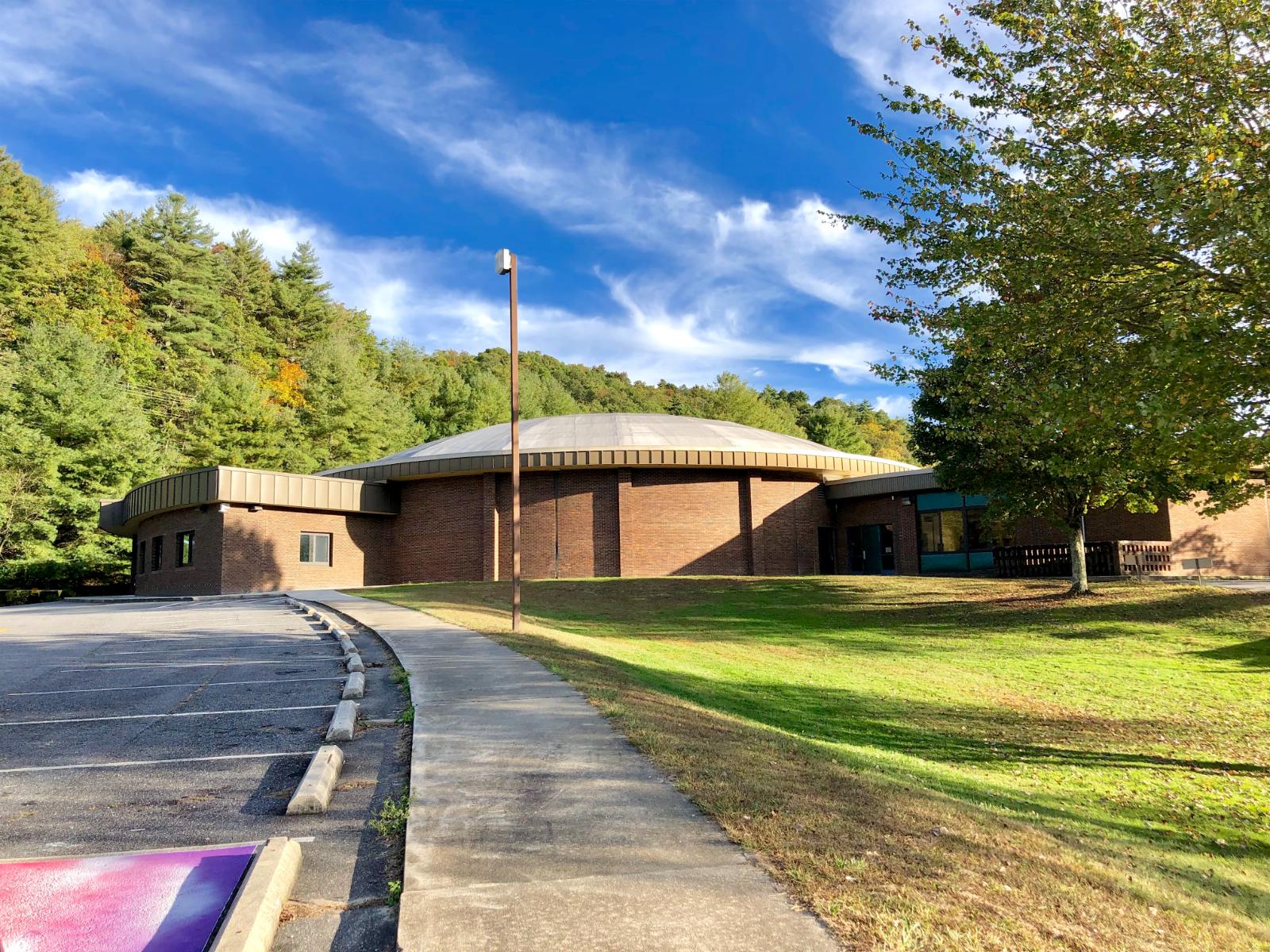
Why are people willing to pay so much to live here? What’s special about it?
Glenville offers an exclusive mountain lake lifestyle centered around Lake Glenville, one of the highest elevation lakes in the eastern United States. The community provides residents with pristine waters perfect for boating, fishing, and swimming, all surrounded by spectacular mountain scenery and luxury homes. The area’s unique combination of lake and mountain amenities creates a resort-like atmosphere that appeals to buyers seeking the ultimate mountain retreat.
Property owners enjoy both scenic beauty and recreational opportunities, with the lake providing excellent fishing and water sports while the surrounding mountains offer hiking, wildlife viewing, and seasonal beauty. The community’s exclusive character and limited development ensure that property values remain stable while preserving the natural environment that makes the area special.
How Glenville Rose to Prominence
Lake Glenville was created in 1941 when Nantahala Power Company built a dam on the Tuckasegee River to generate hydroelectric power. The resulting lake, sitting at 3,500 feet elevation, created unique opportunities for mountain lake development that attracted attention from developers and affluent buyers seeking cool summer retreats with water access.
The community’s development as a luxury destination accelerated during the 1980s and 1990s as western North Carolina’s mountains gained popularity among second-home buyers. Glenville’s combination of high elevation, pristine lake waters, and spectacular mountain views distinguished it from other lake communities, establishing it as one of the region’s most exclusive residential areas.
3 Interesting Tidbits
1. Highest Lake – Lake Glenville is one of the highest major lakes in the southeastern United States, sitting at 3,500 feet elevation with crystal-clear mountain waters.
2. Waterfall Wonderland – The area around Lake Glenville features numerous waterfalls, including several that can be accessed by boat, creating unique recreational opportunities.
3. Cool Waters – The lake’s high elevation keeps water temperatures refreshingly cool even in summer, providing natural relief from heat and excellent conditions for trout fishing.
13. Kure Beach – 107% Home Price Increase Since 2010

- 2010: $370,986
- 2011: $342,197
- 2012: $336,827
- 2013: $344,631
- 2014: $358,306
- 2015: $364,219
- 2016: $377,219
- 2017: $393,880
- 2018: $417,215
- 2019: $440,055
- 2020: $471,895
- 2021: $599,493
- 2022: $775,522
- 2023: $779,697
- 2024: $785,910
- 2025: $767,878
Kure Beach achieved strong 107% growth since 2010, more than doubling from $370,986 to $767,878 by 2025. This coastal community showed steady recovery from early-decade lows, with explosive growth during 2021-2022 when values jumped from $599,493 to $775,522. The area’s historic pier and family-friendly beaches continue driving premium coastal pricing.
Why Kure Beach?
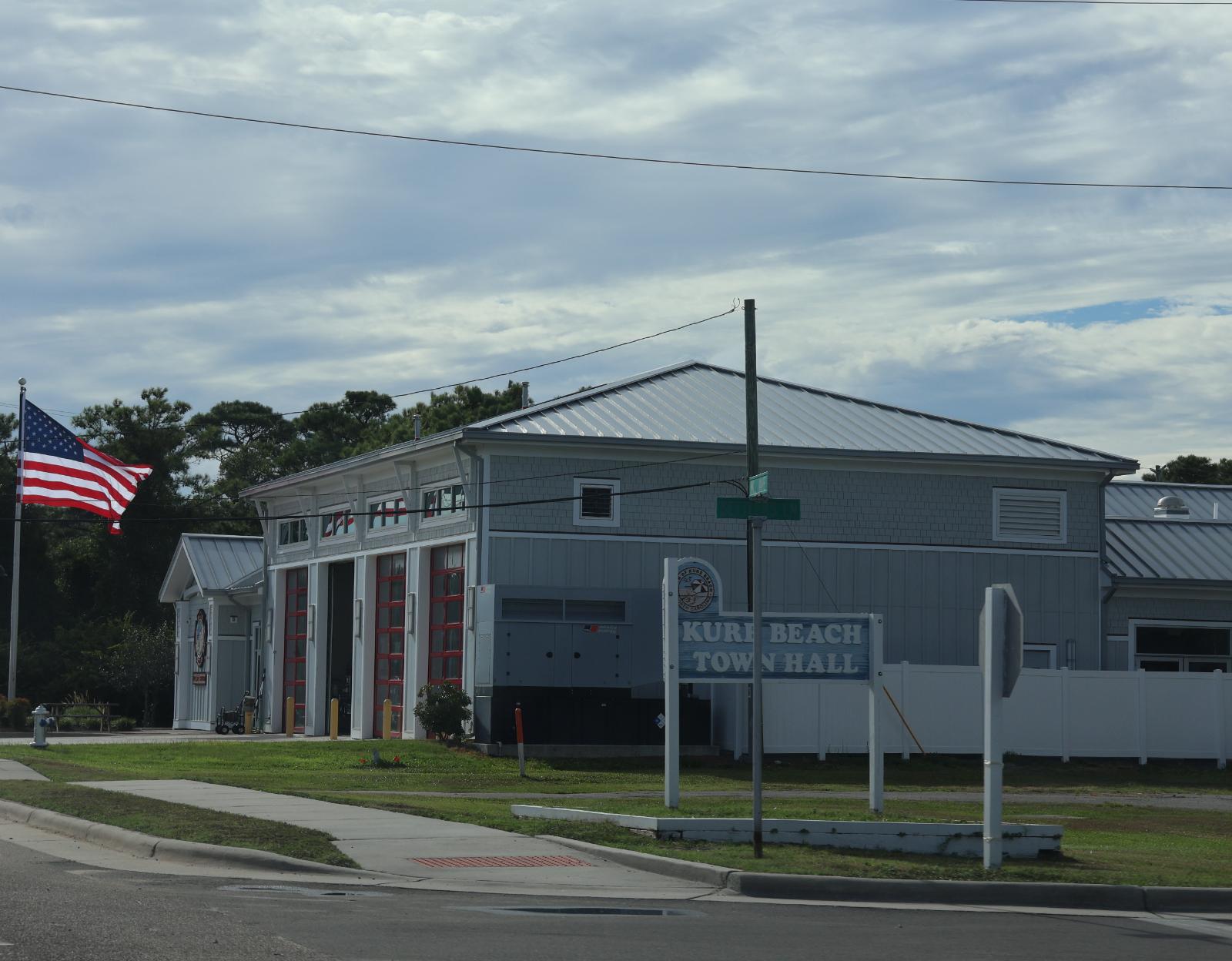
Why are people willing to pay so much to live here? What’s special about it?
Kure Beach offers a classic small-town coastal experience with pristine beaches and the historic Kure Beach Pier, creating an authentic North Carolina beach community atmosphere. The town maintains a deliberately quiet, residential character that appeals to families and retirees seeking peaceful coastal living without commercial overdevelopment. Residents enjoy excellent fishing both from the pier and surf, along with easy access to Fort Fisher State Park and its rich Civil War history.
The community’s commitment to preserving its small-town character while maintaining modern amenities creates a unique coastal experience that commands premium prices. Property owners benefit from strong rental demand due to the area’s reputation as a family-friendly destination with clean beaches and authentic coastal charm.
How Kure Beach Rose to Prominence
Kure Beach developed as a small fishing community and became more accessible to visitors with the construction of bridges connecting it to the mainland. The community’s growth as a beach destination accelerated during the mid-20th century, with the famous Kure Beach Pier becoming a central attraction that drew anglers and families from across the region.
The area’s proximity to Fort Fisher, a crucial Confederate stronghold during the Civil War, added historical significance that attracted visitors interested in both beach recreation and history. Kure Beach’s commitment to controlled development and preservation of its fishing village character distinguished it from more commercialized beach communities, creating the premium residential destination it is today.
3 Interesting Tidbits
1. Fishing Pier Legacy – The Kure Beach Pier, built in 1916, is one of the oldest fishing piers on the North Carolina coast and remains a central community gathering place.
2. Civil War History – The nearby Fort Fisher State Historic Site was the site of the largest Civil War battle in North Carolina and the last major Confederate port to fall to Union forces.
3. Sea Turtle Sanctuary – Kure Beach serves as an important nesting area for loggerhead sea turtles, with the community actively participating in conservation efforts.
12. Southern Shores – 87% Home Price Increase Since 2010
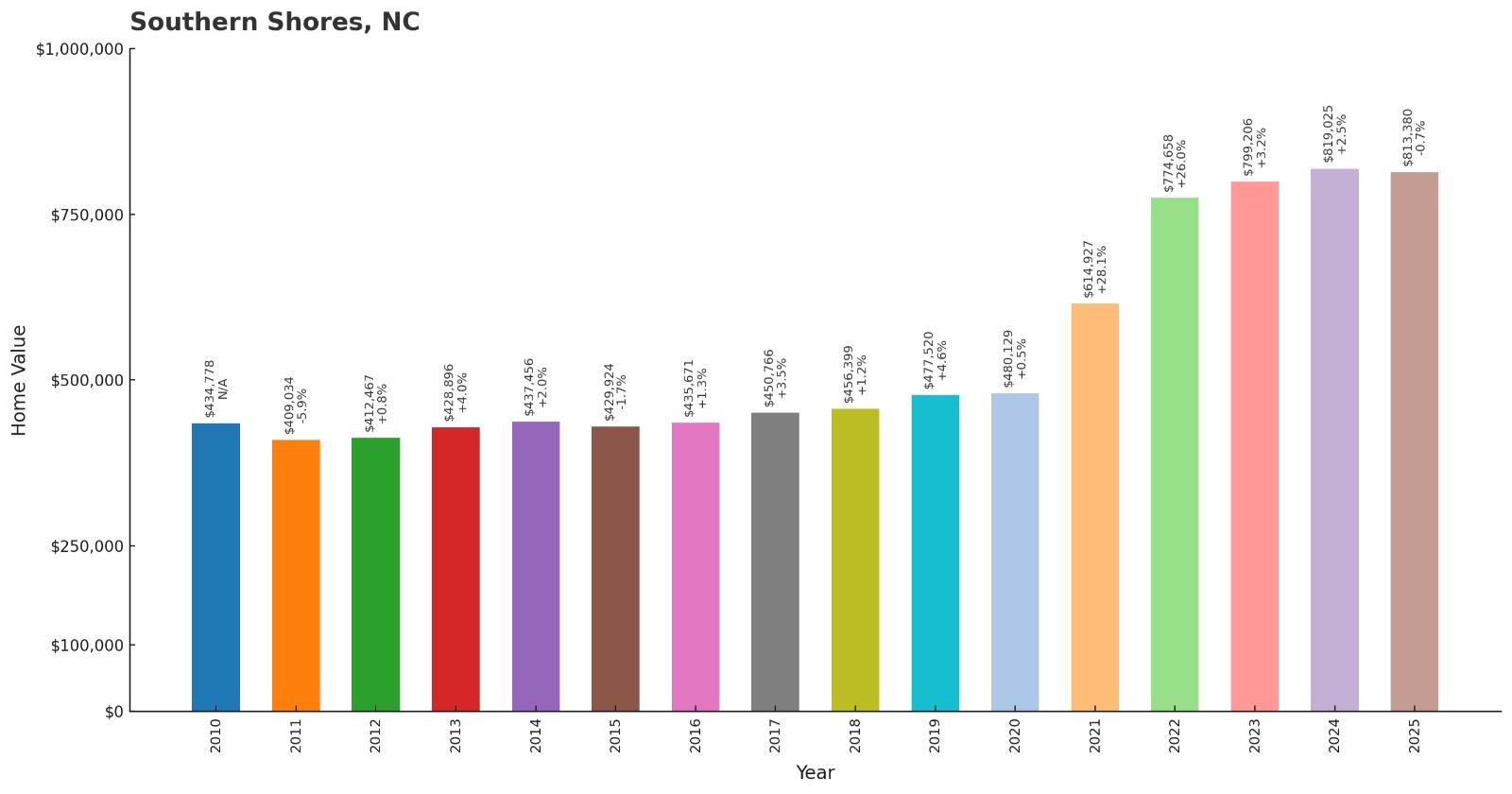
- 2010: $434,778
- 2011: $409,034
- 2012: $412,467
- 2013: $428,896
- 2014: $437,456
- 2015: $429,924
- 2016: $435,671
- 2017: $450,766
- 2018: $456,399
- 2019: $477,520
- 2020: $480,129
- 2021: $614,927
- 2022: $774,658
- 2023: $799,206
- 2024: $819,025
- 2025: $813,380
Southern Shores demonstrated solid 87% growth since 2010, rising from $434,778 to $813,380 by 2025. This upscale Outer Banks community showed steady appreciation through most years, with significant acceleration during 2021-2022 when values jumped from $614,927 to $774,658. The area’s planned community design and excellent amenities continue attracting affluent buyers.
Why Southern Shores?
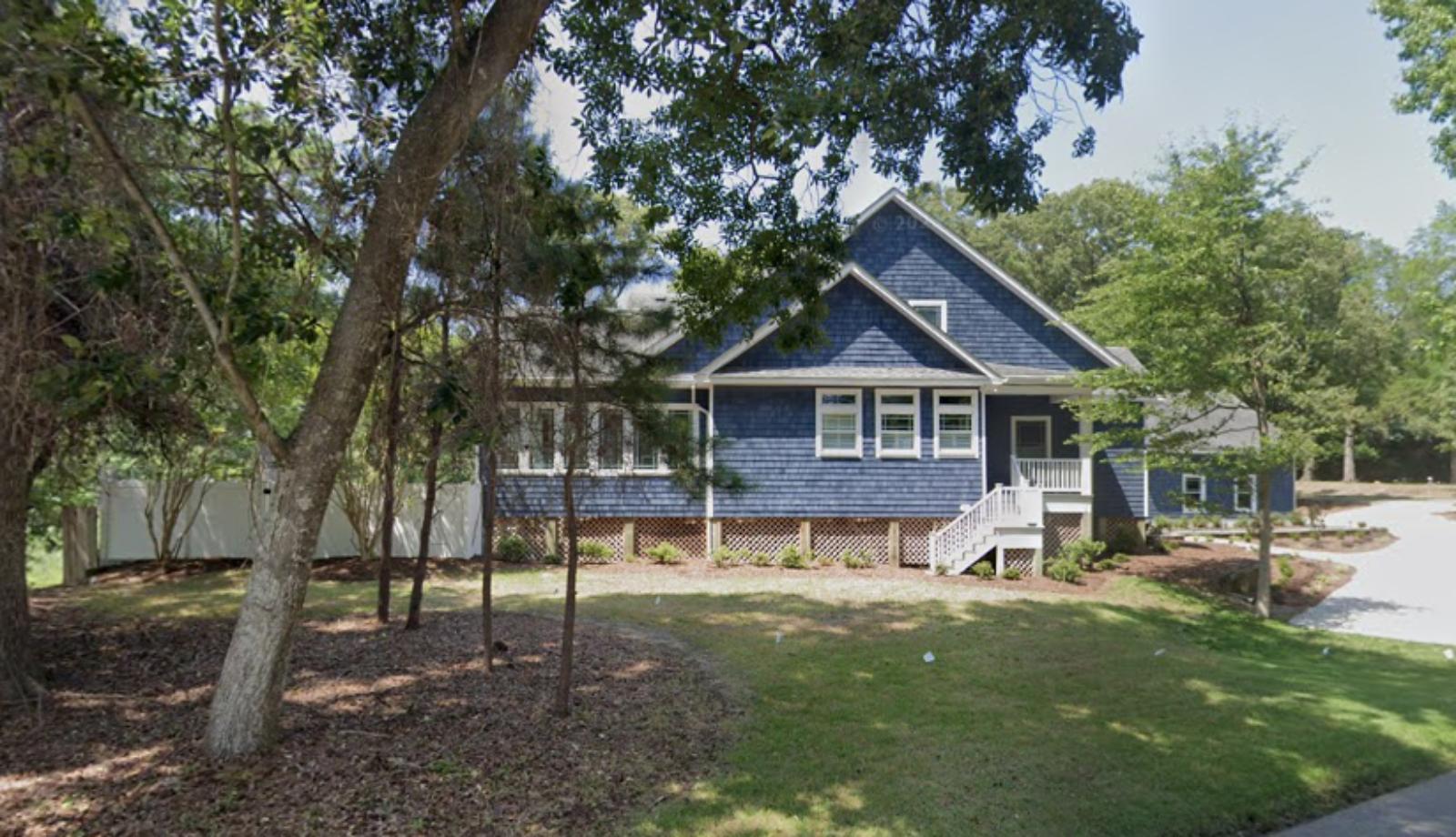
Why are people willing to pay so much to live here? What’s special about it?
Southern Shores offers an upscale Outer Banks experience with carefully planned development that preserves the area’s maritime forests and natural beauty. The community provides residents with access to both ocean and sound waters, along with amenities like golf courses, tennis facilities, and private beach access that create a resort-like atmosphere. Strict architectural guidelines and environmental protections ensure that the community maintains its exclusive character and property values.
Property owners enjoy the benefits of living in one of the Outer Banks’ most prestigious communities, with excellent rental income potential and access to world-class recreational opportunities. The combination of natural beauty, recreational amenities, and controlled development creates a premium coastal living experience that justifies the elevated home prices.
How Southern Shores Rose to Prominence
Southern Shores was developed as a planned community in the 1970s with a focus on preserving the area’s maritime forests and creating an upscale residential destination. The developers implemented strict building codes and environmental protections that distinguished Southern Shores from other Outer Banks communities, attracting affluent buyers seeking luxury coastal living with environmental consciousness.
The community’s growth as a premier Outer Banks destination accelerated during the 1980s and 1990s as the area gained recognition for its unique approach to coastal development. Southern Shores’ combination of luxury amenities, environmental protection, and strategic location established it as one of the most desirable addresses on the Outer Banks.
3 Interesting Tidbits
1. Maritime Forest Preservation – Southern Shores maintains extensive maritime forests that provide natural storm protection and create unique coastal ecosystems rarely found in developed areas.
2. Planned Community Pioneer – The community was one of the first planned developments on the Outer Banks to prioritize environmental preservation alongside luxury amenities.
3. Duck Woods Legacy – The area was originally known as Duck Woods, and efforts were made during development to preserve the historic name and character of the natural landscape.
11. Waves – 90% Home Price Increase Since 2012
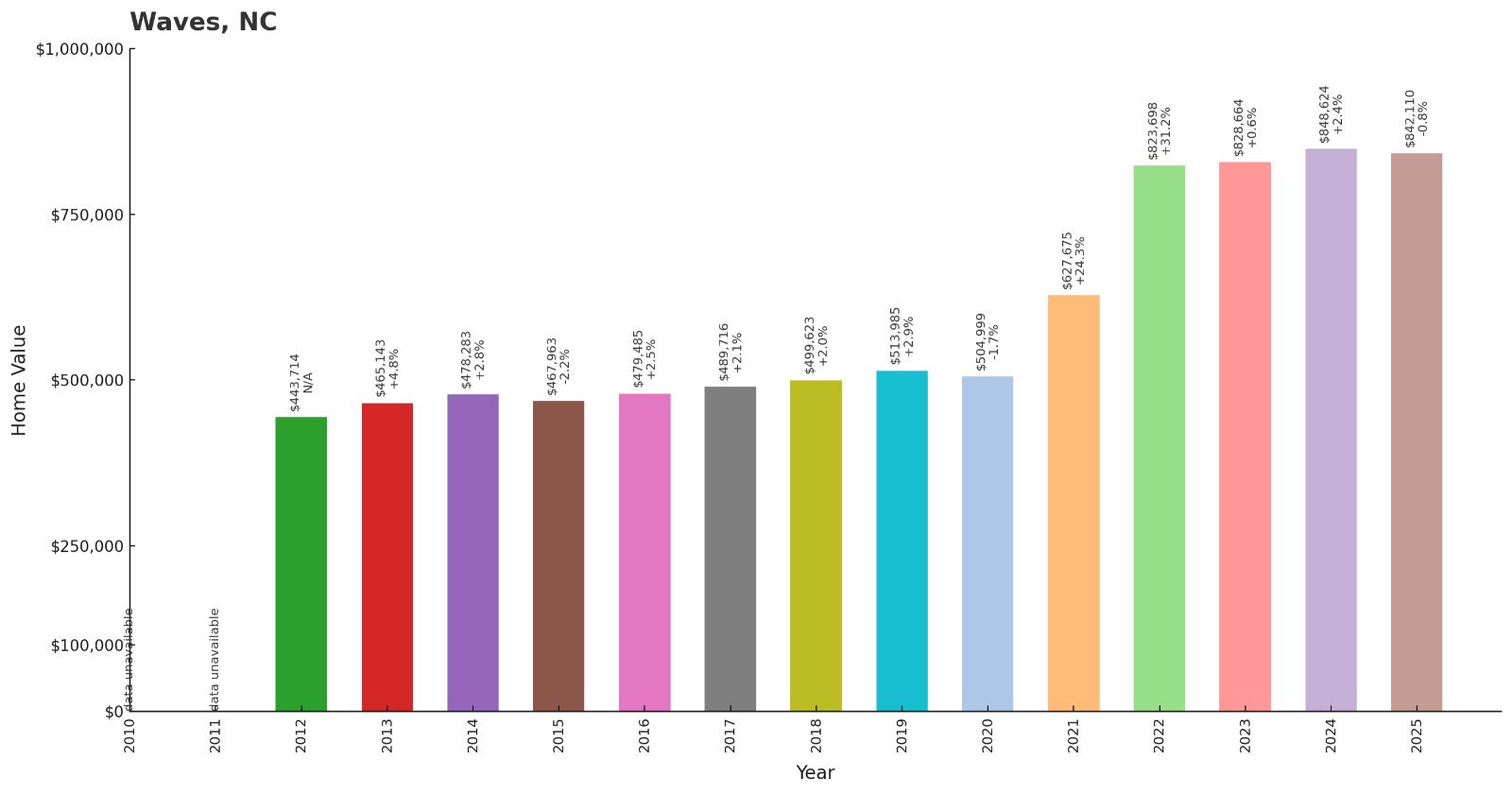
- 2010: N/A
- 2011: N/A
- 2012: $443,714
- 2013: $465,143
- 2014: $478,283
- 2015: $467,963
- 2016: $479,485
- 2017: $489,716
- 2018: $499,623
- 2019: $513,985
- 2020: $504,999
- 2021: $627,675
- 2022: $823,698
- 2023: $828,664
- 2024: $848,624
- 2025: $842,110
Waves achieved impressive 90% growth since 2012, rising from $443,714 to $842,110 by 2025. This Hatteras Island community showed consistent appreciation through most years, with dramatic acceleration during 2021-2022 when values jumped from $627,675 to $823,698. The village’s world-renowned windsurfing conditions and authentic Outer Banks character continue driving premium pricing.
Why Waves?
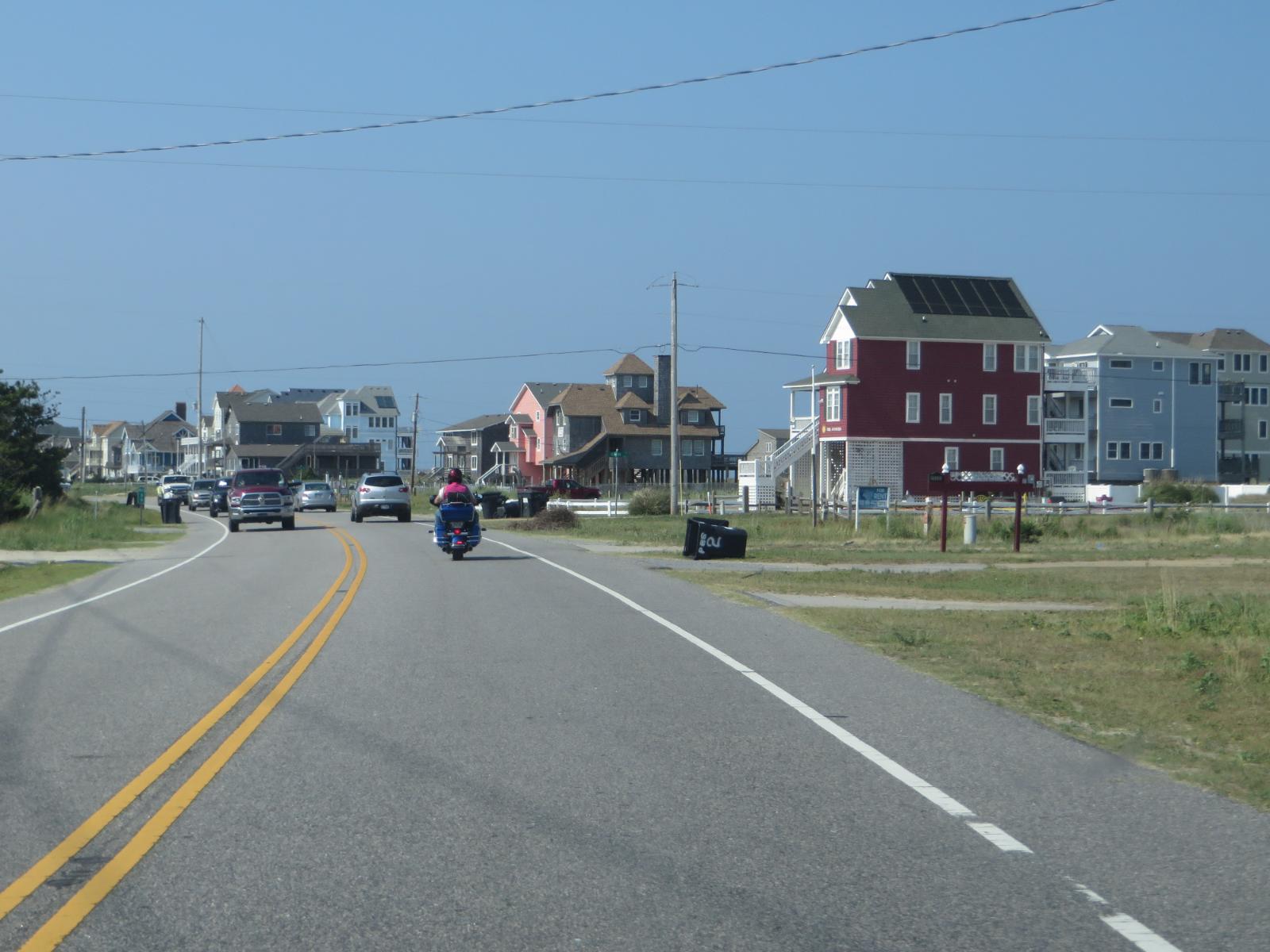
Why are people willing to pay so much to live here? What’s special about it?
Waves attracts buyers seeking the ultimate windsurfing and kiteboarding destination, with Pamlico Sound providing some of the world’s best conditions for wind sports. The village offers an authentic Outer Banks experience away from tourist crowds, where residents enjoy pristine beaches, excellent fishing, and a tight-knit community atmosphere. The area’s location within Cape Hatteras National Seashore ensures permanent protection from overdevelopment.
Property owners benefit from strong vacation rental demand due to the area’s reputation among wind sports enthusiasts and those seeking an genuine coastal experience. The combination of world-class recreational opportunities, natural beauty, and protected status creates a unique investment opportunity for buyers willing to pay premium prices for authentic Outer Banks living.
How Waves Rose to Prominence
Waves began as a small fishing village on Hatteras Island, with residents making their living from the sea through fishing and lifesaving services. The community remained relatively isolated until the mid-20th century when improved road access and the establishment of Cape Hatteras National Seashore brought visitors to the area.
The village’s transformation into a world-renowned windsurfing destination began during the 1980s when wind sports enthusiasts discovered the exceptional conditions created by the interaction of ocean and sound waters. Waves’ reputation spread internationally among windsurfers and kiteboaders, establishing it as a premier destination that commands premium prices for its unique recreational opportunities and authentic coastal character.
3 Interesting Tidbits
1. Windsurfing Capital – Waves is considered one of the world’s premier windsurfing destinations, with Pamlico Sound providing ideal conditions for both beginners and experts.
2. National Seashore Protection – The village’s location within Cape Hatteras National Seashore provides permanent protection from commercial development and overdevelopment.
3. International Reputation – Wind sports enthusiasts travel from around the world to experience the unique conditions created by the interaction of ocean and sound waters at Waves.
10. Holden Beach – 98% Home Price Increase Since 2010

- 2010: $452,110
- 2011: $401,587
- 2012: $374,370
- 2013: $388,168
- 2014: $397,761
- 2015: $405,988
- 2016: $413,723
- 2017: $422,967
- 2018: $441,578
- 2019: $459,914
- 2020: $476,317
- 2021: $628,214
- 2022: $823,044
- 2023: $819,091
- 2024: $874,441
- 2025: $893,835
Holden Beach achieved remarkable 98% growth since 2010, nearly doubling from $452,110 to $893,835 by 2025. This family-friendly coastal community recovered from early-decade declines to show explosive growth during 2021-2022 when values jumped from $628,214 to $823,044. The area’s wide beaches and small-town atmosphere continue attracting families and investors.
Why Holden Beach?
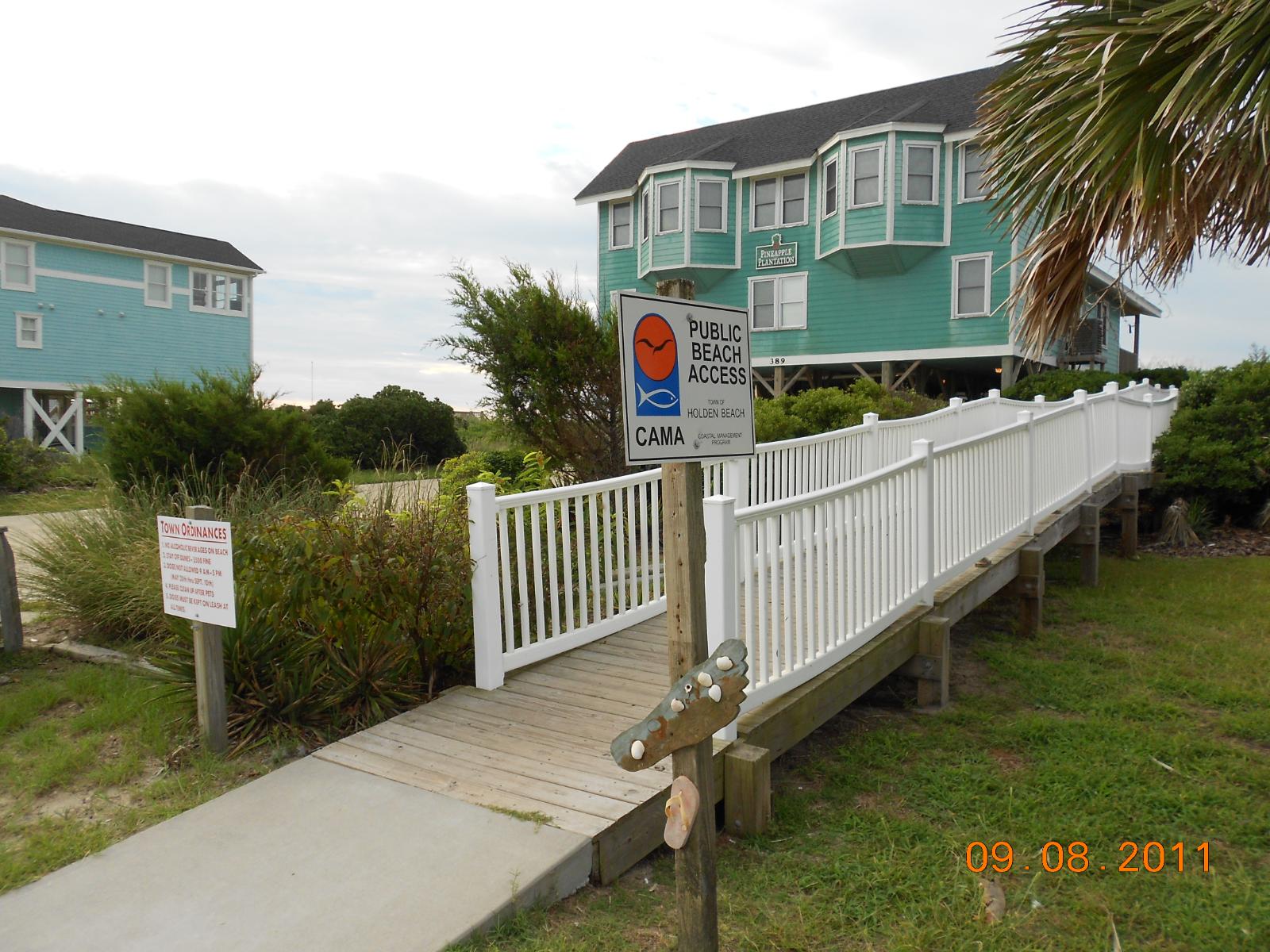
Why are people willing to pay so much to live here? What’s special about it?
Holden Beach offers a classic family beach experience with wide, clean beaches and a deliberately quiet atmosphere that appeals to families seeking traditional coastal vacations. The community maintains strict building codes and commercial restrictions that preserve its residential character while providing excellent access to fishing, boating, and beach activities. The area’s reputation as a family-friendly destination creates strong rental demand for property owners.
Residents and visitors enjoy the island’s commitment to maintaining its small-town charm while providing modern conveniences and excellent access to both ocean and intracoastal waters. The combination of beautiful beaches, family-friendly atmosphere, and investment potential makes Holden Beach an attractive destination for buyers seeking both lifestyle and financial returns.
How Holden Beach Rose to Prominence
Holden Beach was named after John Holden, who acquired the island in the 1750s, but remained largely undeveloped until the mid-20th century when bridges made it accessible to mainland visitors. The community’s development focused on creating a family-oriented destination that preserved the island’s natural beauty while providing the amenities needed for comfortable beach living.
The area’s growth accelerated during the 1980s and 1990s as North Carolina’s coast gained popularity as a vacation destination. Holden Beach’s commitment to controlled development and family-friendly policies distinguished it from more commercialized beach communities, creating the premium residential destination that commands today’s elevated prices.
3 Interesting Tidbits
1. Family Legacy – Many families have been vacationing at Holden Beach for multiple generations, creating a loyal following that supports strong property values.
2. Sea Turtle Haven – The island serves as an important nesting ground for loggerhead sea turtles, with the community actively participating in conservation programs.
3. Fishing Paradise – Holden Beach provides excellent access to both surf fishing and deep-sea fishing, with the Gulf Stream relatively close offshore.
9. Corolla – 80% Home Price Increase Since 2010
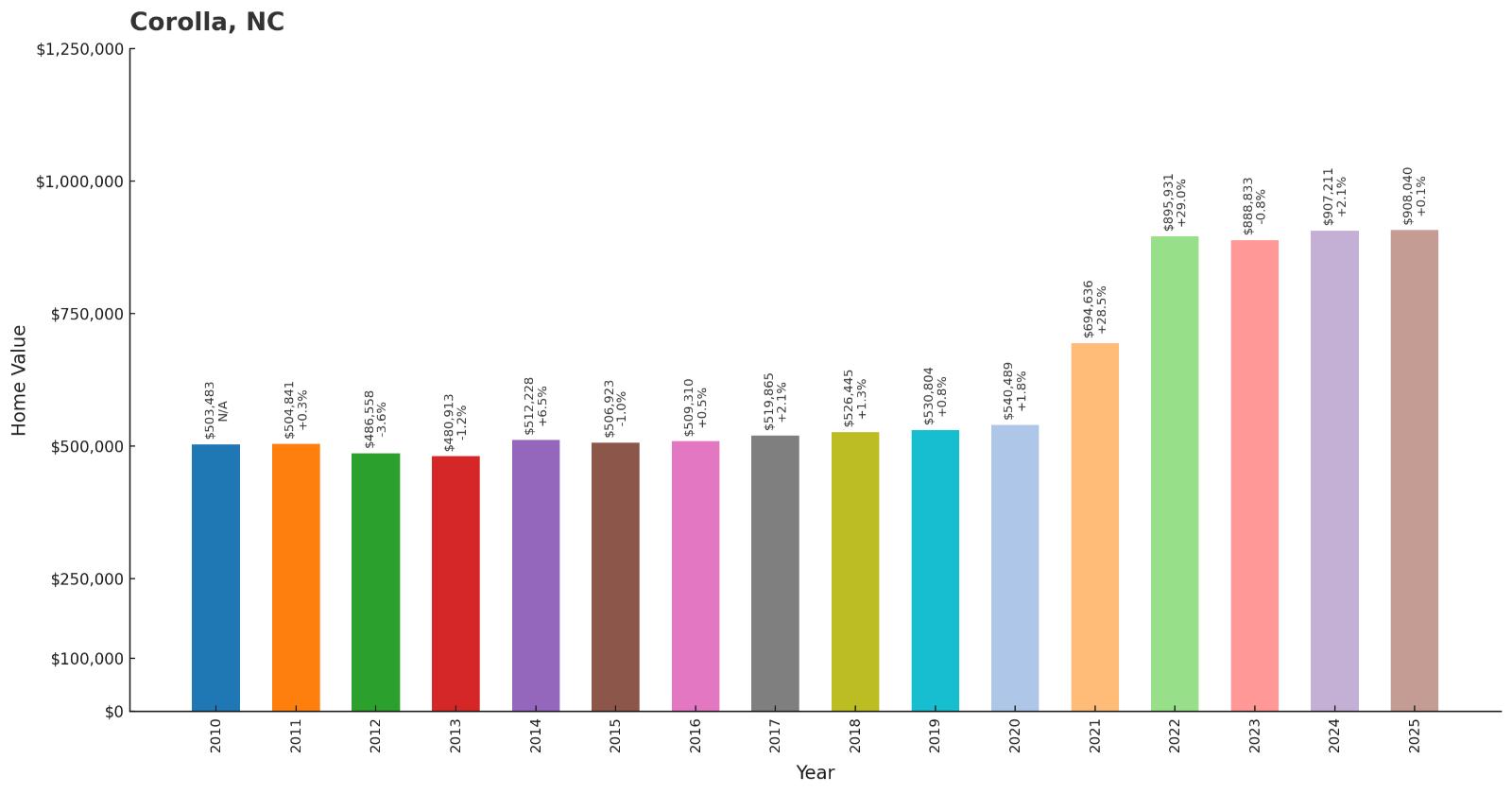
- 2010: $503,483
- 2011: $504,841
- 2012: $486,558
- 2013: $480,913
- 2014: $512,228
- 2015: $506,923
- 2016: $509,310
- 2017: $519,865
- 2018: $526,445
- 2019: $530,804
- 2020: $540,489
- 2021: $694,636
- 2022: $895,931
- 2023: $888,833
- 2024: $907,211
- 2025: $908,040
Corolla demonstrated solid 80% growth since 2010, rising from $503,483 to $908,040 by 2025. This northern Outer Banks community showed steady appreciation through most years, with explosive growth during 2021-2022 when values jumped from $694,636 to $895,931. The area’s wild horses and pristine beaches continue attracting luxury buyers seeking exclusive Outer Banks experiences.
Why Corolla?
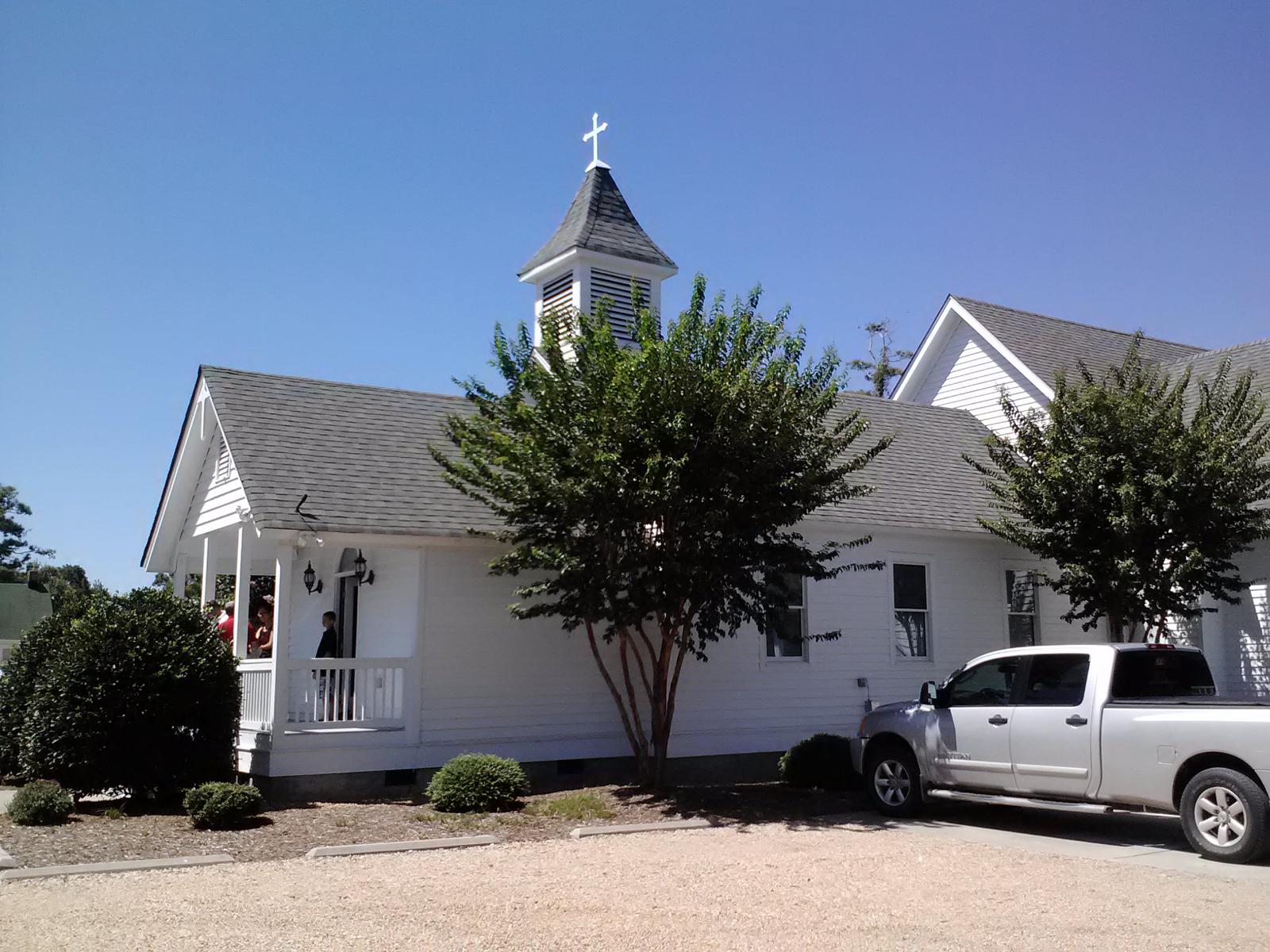
Why are people willing to pay so much to live here? What’s special about it?
Corolla offers an exclusive Outer Banks experience highlighted by the famous wild horses that roam the northern beaches and pristine coastline that remains largely undeveloped. The community provides access to some of the most beautiful and uncrowded beaches on the East Coast, along with luxury amenities and rental income potential that appeals to affluent buyers. The area’s 4-wheel-drive beaches create a unique adventure experience that distinguishes it from other coastal destinations.
Property owners enjoy both natural beauty and investment returns, with luxury homes commanding premium rental rates due to Corolla’s reputation for exclusivity and unique attractions. The combination of wild horses, pristine beaches, and controlled development creates a premium coastal experience that justifies elevated home prices.
How Corolla Rose to Prominence
Corolla remained one of the most isolated areas of the Outer Banks until 1984 when a paved road finally connected it to the rest of the barrier islands. Prior to road access, the area was inhabited mainly by the descendants of lighthouse keepers and the famous Banker horses, descendants of shipwrecked horses that had roamed the area for centuries.
The community’s transformation began immediately after road access was established, with developers and affluent buyers attracted by the area’s pristine beaches, wild horses, and untouched character. Corolla’s development as a luxury destination accelerated during the 1990s and 2000s, with careful planning ensuring that growth preserved the area’s natural attractions while providing upscale amenities for residents and visitors.
3 Interesting Tidbits
1. Wild Horse Legacy – Corolla is home to over 100 wild horses descended from shipwrecks, making it one of the few places in America where wild horses roam free beaches.
2. 4WD Adventure – The northern beaches of Corolla require 4-wheel-drive vehicles to access, creating a unique adventure experience for residents and visitors.
3. Late Development – Corolla remained virtually inaccessible by car until 1984, making it one of the last areas of the Outer Banks to be developed for tourism and residential use.
8. Topsail Beach – 131% Home Price Increase Since 2010

- 2010: $402,308
- 2011: $367,126
- 2012: $372,590
- 2013: $384,075
- 2014: $392,568
- 2015: $406,188
- 2016: $420,431
- 2017: $438,880
- 2018: $460,332
- 2019: $500,463
- 2020: $558,242
- 2021: $696,350
- 2022: $929,676
- 2023: $930,476
- 2024: $919,105
- 2025: $927,911
Topsail Beach achieved exceptional 131% growth since 2010, rising from $402,308 to $927,911 by 2025. This barrier island community showed consistent year-over-year appreciation through most years, with explosive growth during 2021-2022 when values jumped from $696,350 to $929,676. The island’s pristine beaches and protected natural areas continue driving luxury coastal pricing.
Why Topsail Beach?
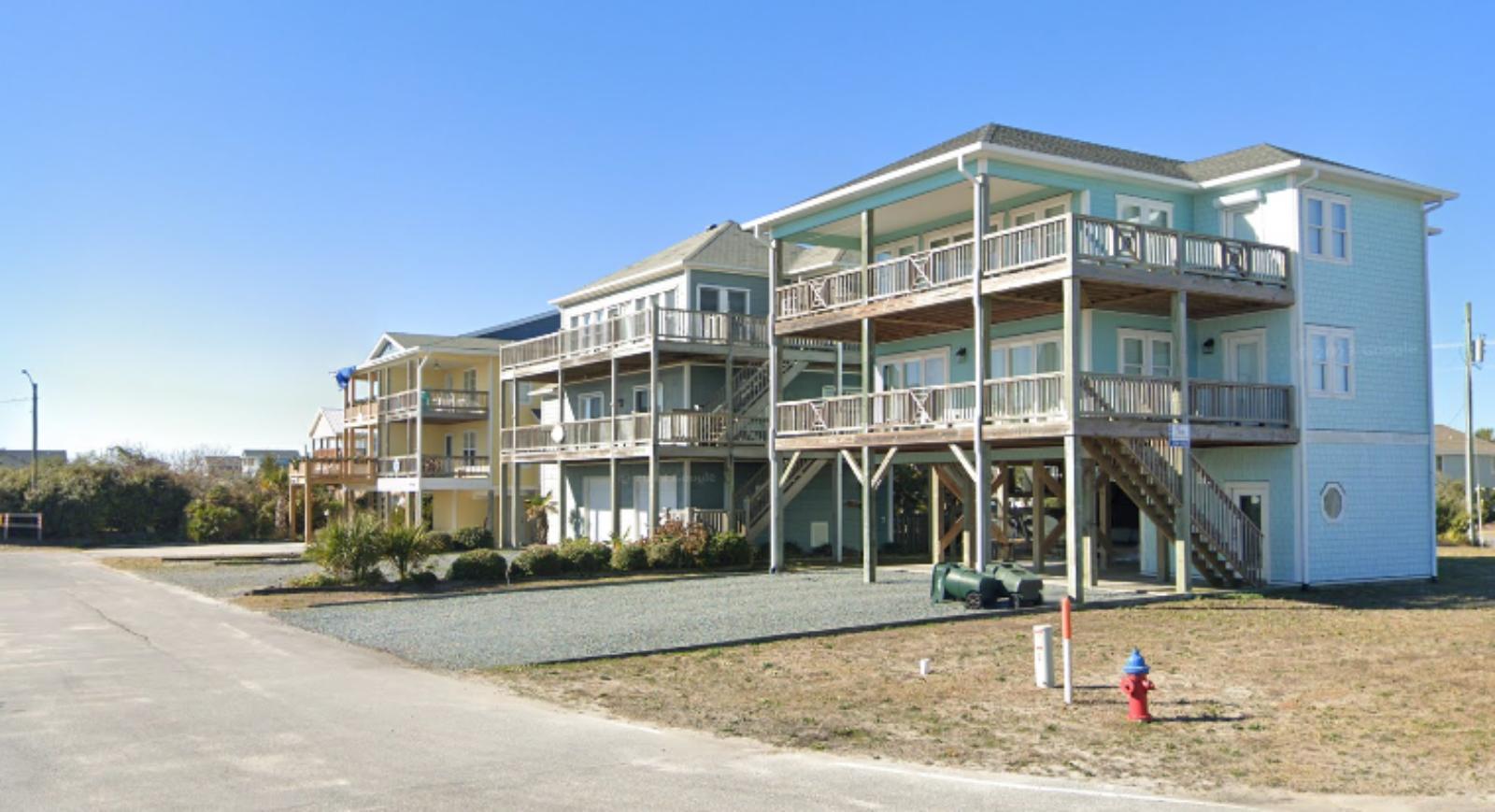
Why are people willing to pay so much to live here? What’s special about it?
Topsail Beach offers an authentic barrier island experience with pristine beaches and a commitment to preserving natural beauty that sets it apart from more developed coastal areas. The community provides excellent access to fishing, surfing, and sea turtle watching, with residents enjoying a peaceful coastal lifestyle away from commercial development. The island’s position and natural protection create some of the most beautiful and uncrowded beaches on the North Carolina coast.
Property owners benefit from the area’s growing reputation as a premium coastal destination while enjoying excellent rental income potential due to the island’s appeal to families and fishing enthusiasts. The combination of natural beauty, recreational opportunities, and protected status creates a unique investment opportunity for buyers seeking authentic coastal living.
How Topsail Beach Rose to Prominence
Topsail Island was used as a secret rocket testing site by the U.S. Navy during the 1940s, with launching towers for experimental missiles that were designed to intercept enemy aircraft. After the military program ended, the island remained largely undeveloped until bridges connected it to the mainland and residential development began in the 1960s and 1970s.
The community’s growth as a premier beach destination accelerated during the 1980s and 1990s as visitors discovered its pristine beaches and excellent fishing opportunities. Topsail Beach’s commitment to controlled development and environmental protection, combined with its unique history and natural beauty, established it as one of North Carolina’s most desirable coastal communities.
3 Interesting Tidbits
1. Secret Military Past – Topsail Island served as a top-secret U.S. Navy rocket testing facility during the 1940s, with concrete launching towers still visible on the island today.
2. Sea Turtle Hospital – The island is home to the Karen Beasley Sea Turtle Rescue and Rehabilitation Center, one of the most important sea turtle conservation facilities on the East Coast.
3. Pirate Legend – Local legend claims the island’s name comes from pirates who would hide behind the island and raise their topsails to signal to confederates on shore.
7. Duck – 80% Home Price Increase Since 2010

- 2010: $548,324
- 2011: $516,690
- 2012: $511,738
- 2013: $534,368
- 2014: $545,606
- 2015: $531,823
- 2016: $533,388
- 2017: $539,271
- 2018: $553,835
- 2019: $584,369
- 2020: $572,693
- 2021: $755,842
- 2022: $965,136
- 2023: $960,156
- 2024: $995,116
- 2025: $989,638
Duck demonstrated solid 80% growth since 2010, rising from $548,324 to $989,638 by 2025. This upscale Outer Banks community showed steady appreciation through most years, with explosive growth during 2021-2022 when values jumped from $755,842 to $965,136. The town’s boardwalk and upscale amenities continue attracting affluent buyers seeking luxury coastal living.
Why Duck?
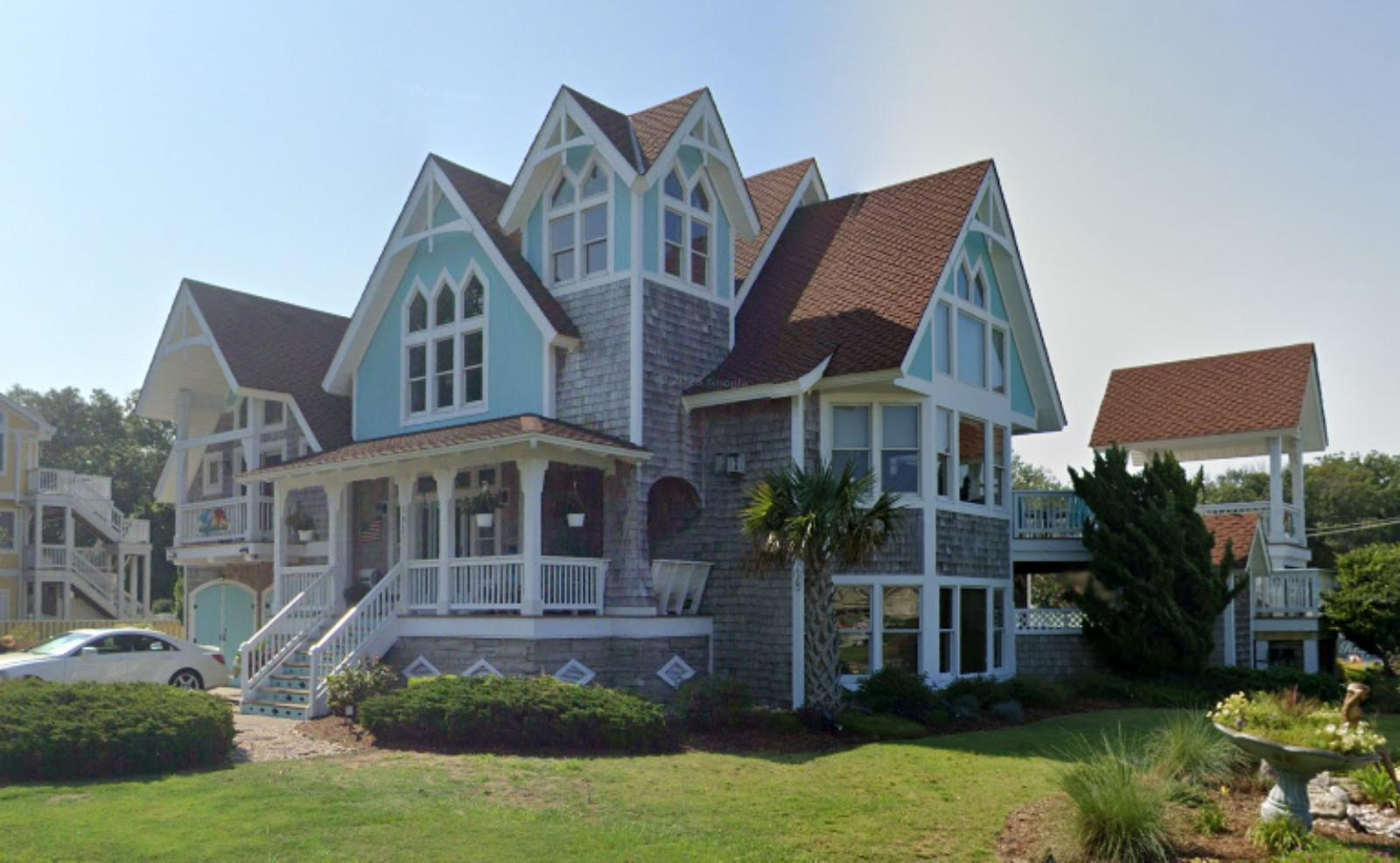
Why are people willing to pay so much to live here? What’s special about it?
Duck offers the pinnacle of upscale Outer Banks living with its famous boardwalk, high-end shops, and restaurants that create a sophisticated coastal experience. The community provides residents with access to pristine beaches, excellent fishing, and recreational amenities while maintaining a more refined atmosphere than other Outer Banks destinations. The town’s careful development and architectural standards ensure that growth enhances rather than detracts from its natural beauty.
Property owners enjoy both lifestyle benefits and excellent investment returns, with Duck’s reputation as a premier destination creating strong vacation rental demand and property appreciation. The combination of natural beauty, upscale amenities, and controlled development creates a luxury coastal experience that commands premium prices.
How Duck Rose to Prominence
Duck began as a remote hunting and fishing area on the northern Outer Banks, remaining largely inaccessible until road connections were established in the 1980s. The community’s transformation into an upscale destination began with careful planning that emphasized preserving the area’s maritime forests and natural beauty while creating sophisticated amenities for visitors and residents.
The town’s development as a luxury destination accelerated during the 1990s with the construction of the famous Duck boardwalk and the establishment of high-end shops and restaurants that distinguished it from other Outer Banks communities. Duck’s success in balancing development with environmental preservation established it as the most upscale community on the northern Outer Banks.
3 Interesting Tidbits
1. Boardwalk Fame – Duck’s mile-long boardwalk through maritime forests and over Currituck Sound is one of the most photographed attractions on the Outer Banks.
2. Maritime Forest Preserve – The town has preserved extensive maritime forests that provide natural storm protection and create unique ecosystems rarely found in developed coastal areas.
3. Upscale Shopping – Duck features the only concentration of upscale boutiques and galleries on the northern Outer Banks, creating a sophisticated shopping and dining destination.
6. Highlands – 120% Home Price Increase Since 2010

- 2010: $450,849
- 2011: $431,353
- 2012: $425,119
- 2013: $430,695
- 2014: $442,535
- 2015: $454,011
- 2016: $450,523
- 2017: $480,845
- 2018: $525,443
- 2019: $530,815
- 2020: $544,341
- 2021: $756,449
- 2022: $980,888
- 2023: $908,837
- 2024: $944,052
- 2025: $991,383
Highlands achieved impressive 120% growth since 2010, rising from $450,849 to $991,383 by 2025. This mountain resort town showed steady appreciation through most years, with explosive growth during 2021-2022 when values jumped from $756,449 to $980,888. The community’s unique elevation and luxury amenities continue attracting buyers seeking premium mountain living.
Why Highlands?
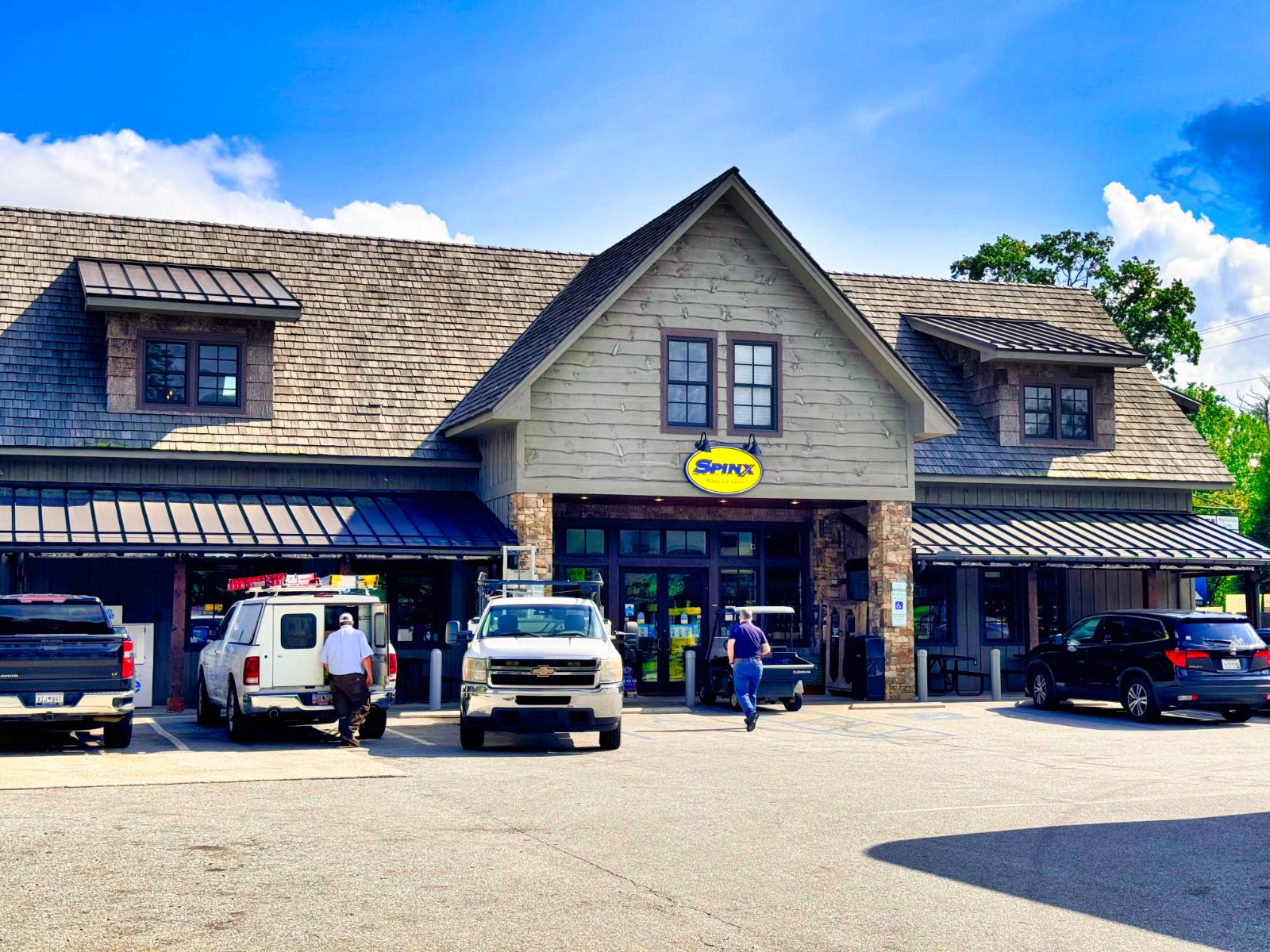
Why are people willing to pay so much to live here? What’s special about it?
Highlands offers an exclusive mountain resort experience at 4,118 feet elevation, providing cool summers and spectacular views that create a natural retreat from lower elevation heat. The community features world-class dining, boutique shopping, and cultural events that rival major cities, all set in a pristine mountain environment. Residents enjoy access to waterfalls, hiking trails, and outdoor recreation while living in one of the Southeast’s most sophisticated mountain towns.
The town’s unique combination of natural beauty and luxury amenities creates a lifestyle that appeals to affluent buyers seeking both adventure and sophistication. Property owners benefit from strong rental demand due to Highlands’ reputation as a premier mountain destination, while the area’s controlled development ensures long-term value appreciation.
How Highlands Rose to Prominence
Highlands was founded in 1875 by Samuel Kelsey and Clinton Hutchinson, who chose the location specifically for its high elevation and cool climate, believing it would become a resort destination for wealthy families from the hot, humid South. The community developed as a summer retreat for affluent families from across the Southeast, with grand hotels and estates built to accommodate visitors seeking mountain coolness and natural beauty.
The town’s transformation into a year-round luxury destination accelerated during the late 20th century as improved access and modern amenities made mountain living more appealing. Highlands’ success in maintaining its exclusive character while accommodating growth established it as one of the premier mountain communities in the Southeast, attracting buyers willing to pay premium prices for mountain luxury.
3 Interesting Tidbits
1. Elevation Excellence – At 4,118 feet, Highlands is one of the highest incorporated towns east of the Mississippi River, providing naturally cool summers and crisp mountain air.
2. Waterfall Wonderland – The area around Highlands features more than 200 waterfalls within a 10-mile radius, including several that can be reached by short hikes from town.
3. Cultural Oasis – Despite its small size, Highlands hosts the Highlands-Cashiers Chamber Music Festival and numerous cultural events that attract visitors from across the region.
5. Weddington – 146% Home Price Increase Since 2010

- 2010: $436,686
- 2011: $418,901
- 2012: $421,316
- 2013: $443,994
- 2014: $478,459
- 2015: $501,283
- 2016: $525,646
- 2017: $564,620
- 2018: $587,170
- 2019: $609,669
- 2020: $633,749
- 2021: $773,109
- 2022: $987,903
- 2023: $976,779
- 2024: $1,063,707
- 2025: $1,074,616
Weddington achieved exceptional 146% growth since 2010, rising from $436,686 to $1,074,616 by 2025. This Charlotte-area suburb showed consistent year-over-year appreciation through most years, with significant acceleration during 2021-2022 when values jumped from $773,109 to $987,903. The community’s excellent schools and upscale development continue attracting affluent families.
Why Weddington?
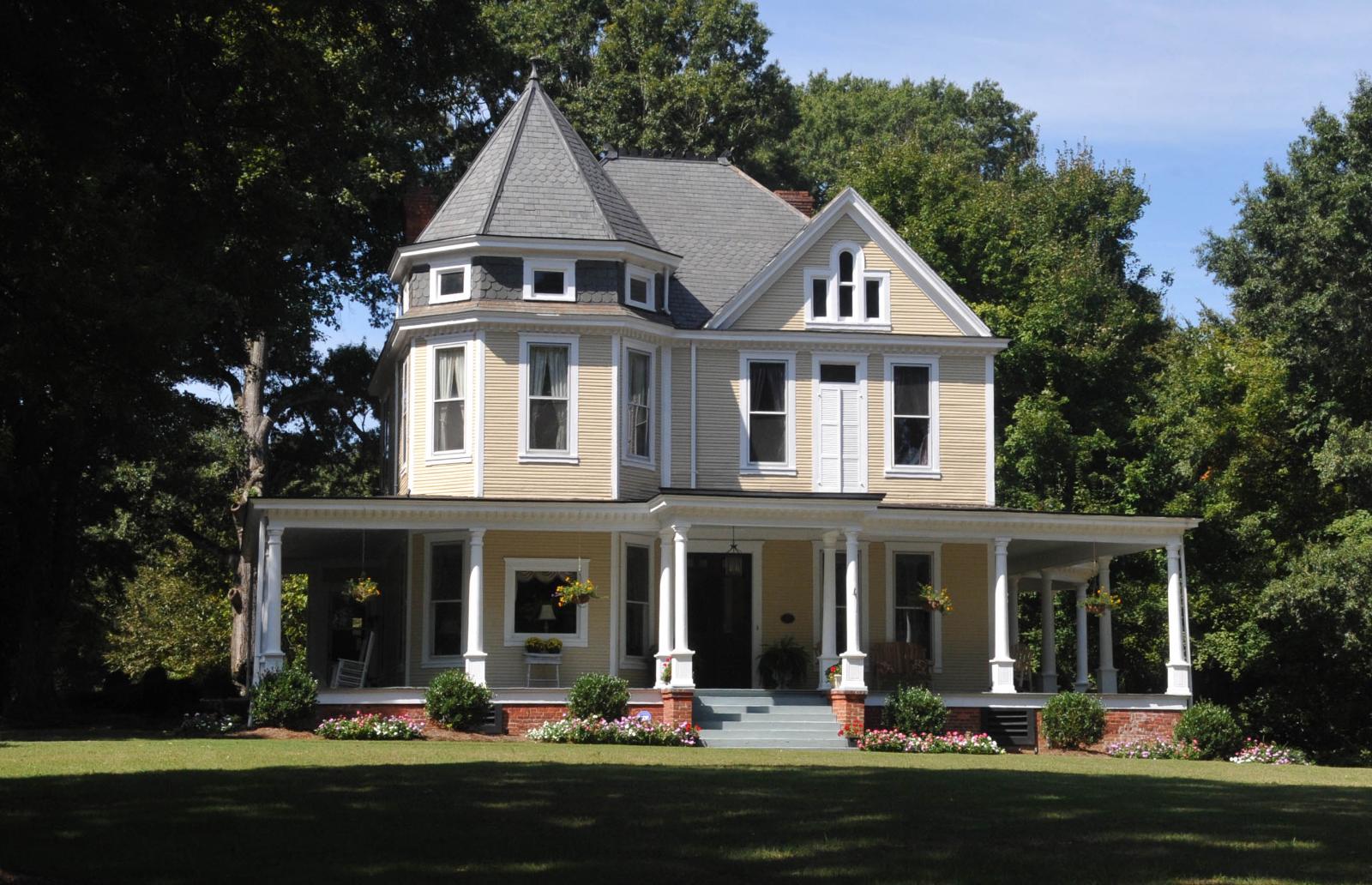
Why are people willing to pay so much to live here? What’s special about it?
Weddington attracts affluent families seeking top-rated schools and upscale suburban living within easy commuting distance of Charlotte’s business district. The community offers newer construction, larger lots, and excellent amenities while maintaining a small-town feel that appeals to families wanting both luxury and community atmosphere. Residents value the area’s careful development that prioritizes quality construction and family-friendly amenities.
The town’s strategic location provides the perfect balance for professionals who want suburban tranquility without sacrificing access to Charlotte’s employment opportunities and cultural amenities. Excellent schools, safe neighborhoods, and modern infrastructure create an attractive package for buyers willing to pay premium prices for quality of life and long-term investment potential.
How Weddington Rose to Prominence
Weddington began as a small rural community in Union County, remaining largely agricultural through much of the 20th century. The town’s transformation began during the 1990s as Charlotte’s metropolitan area expanded outward and families sought high-quality suburban communities with excellent schools and modern amenities.
The community’s growth accelerated dramatically during the 2000s as Charlotte solidified its position as a major banking and business center, creating demand for upscale suburban housing within commuting distance. Weddington’s incorporation and careful planning ensured that development maintained high standards, establishing it as one of the most desirable suburban communities in the Charlotte region.
3 Interesting Tidbits
1. School District Excellence – Weddington is served by Union County Public Schools, consistently ranked among the top school districts in North Carolina for academic achievement.
2. Planned Growth Success – The town’s incorporation in 1983 allowed residents to control development standards, ensuring high-quality construction and preservation of community character.
3. Corporate Proximity – Strategic location provides easy access to Charlotte’s banking district and major corporate headquarters, appealing to executives and business professionals.
4. Marvin – 138% Home Price Increase Since 2010
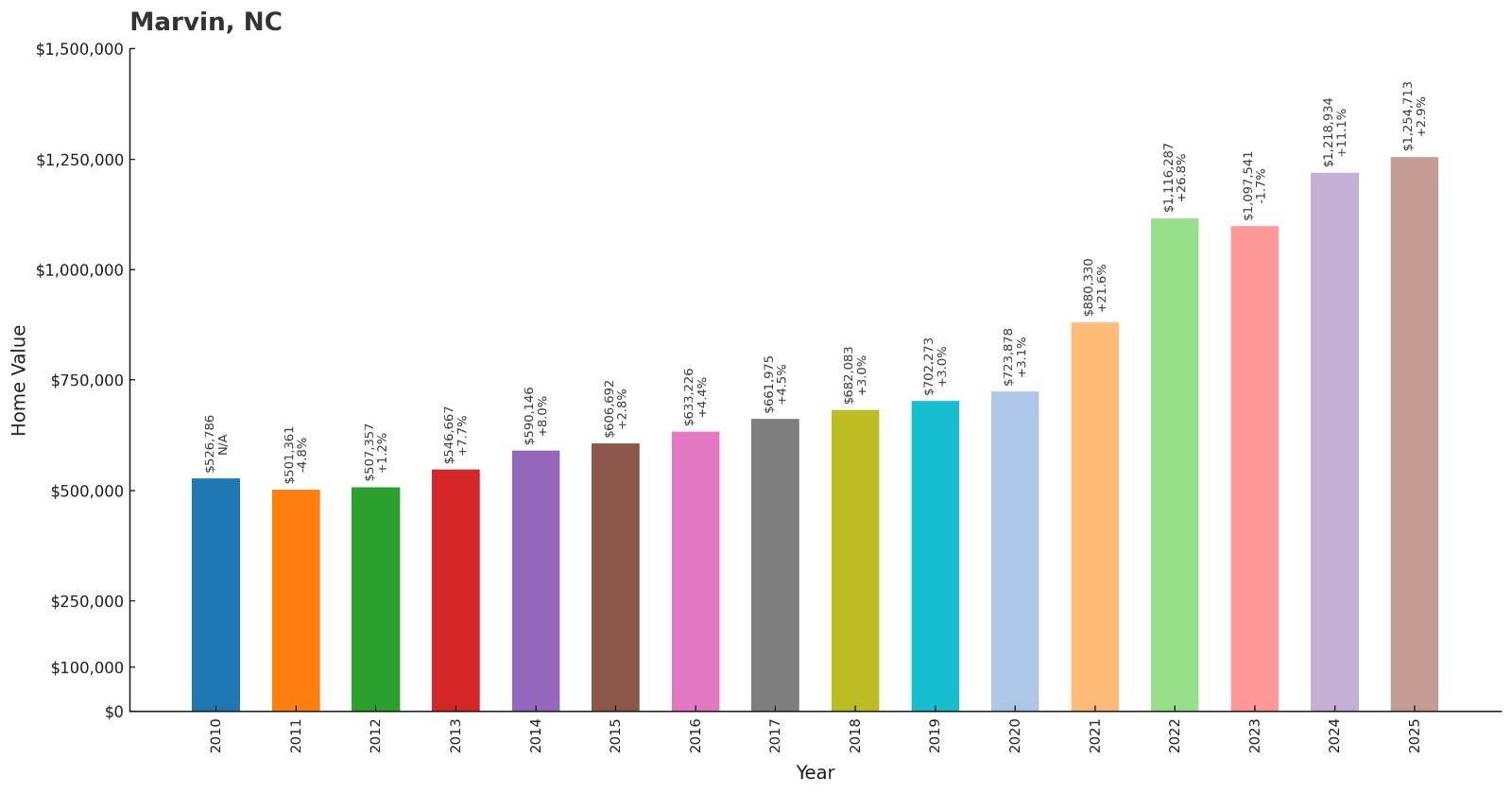
- 2010: $526,786
- 2011: $501,361
- 2012: $507,357
- 2013: $546,667
- 2014: $590,146
- 2015: $606,692
- 2016: $633,226
- 2017: $661,975
- 2018: $682,083
- 2019: $702,273
- 2020: $723,878
- 2021: $880,330
- 2022: $1,116,287
- 2023: $1,097,541
- 2024: $1,218,934
- 2025: $1,254,713
Marvin demonstrated impressive 138% growth since 2010, rising from $526,786 to $1,254,713 by 2025. This upscale Charlotte suburb showed consistent year-over-year appreciation through most years, with explosive growth during 2021-2022 when values jumped from $880,330 to $1,116,287. The community’s luxury homes and excellent location continue attracting high-net-worth buyers.
Why Marvin?

Why are people willing to pay so much to live here? What’s special about it?
Marvin offers an exclusive suburban experience with luxury homes on large lots, providing privacy and space that’s increasingly rare in the Charlotte metropolitan area. The community features upscale neighborhoods, excellent schools, and beautiful parks that create a resort-like atmosphere for families seeking the ultimate in suburban luxury. Residents enjoy the benefits of small-town charm while remaining connected to Charlotte’s business and cultural opportunities.
The town’s commitment to preserving its rural character while accommodating high-quality development has created neighborhoods that appeal to executives, entrepreneurs, and professionals who want both luxury amenities and peaceful living environments. Strategic location and excellent infrastructure make Marvin one of the most desirable addresses in the Charlotte region.
How Marvin Rose to Prominence
Marvin remained a small rural community in Union County through most of its history, with residents primarily engaged in farming and small-town commerce. The area’s transformation began during the 1990s as Charlotte’s economic boom created demand for upscale suburban communities that could provide luxury living within commuting distance of the city.
The community’s development as a luxury destination accelerated during the 2000s with the construction of upscale neighborhoods and the town’s incorporation, which allowed residents to control development standards and preserve the area’s rural character. Marvin’s success in balancing growth with quality of life established it as one of the most exclusive communities in the Charlotte area.
3 Interesting Tidbits
1. Rural Luxury – Marvin successfully maintains a rural feel with large lots and horse properties while providing access to urban amenities and employment opportunities.
2. Marvin Efird Park – The town’s central park features walking trails, sports facilities, and community gathering spaces that create a focal point for community life.
3. Corporate Executive Haven – The community has become a preferred location for executives from Charlotte’s major corporations, creating a concentration of high-net-worth residents.
3. Cashiers – 144% Home Price Increase Since 2010
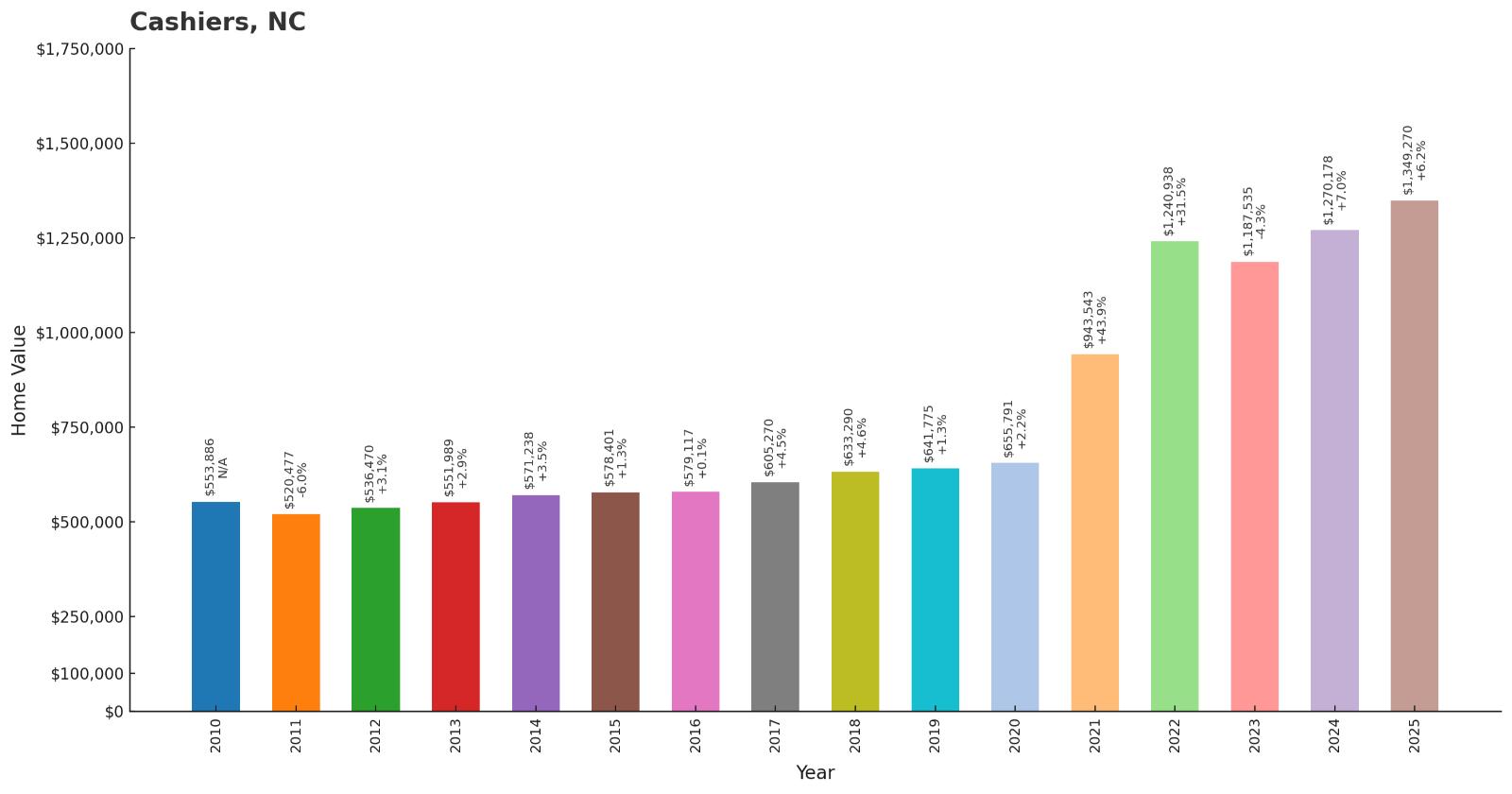
- 2010: $553,886
- 2011: $520,477
- 2012: $536,470
- 2013: $551,989
- 2014: $571,238
- 2015: $578,401
- 2016: $579,117
- 2017: $605,270
- 2018: $633,290
- 2019: $641,775
- 2020: $655,791
- 2021: $943,543
- 2022: $1,240,938
- 2023: $1,187,535
- 2024: $1,270,178
- 2025: $1,349,270
Cashiers achieved remarkable 144% growth since 2010, rising from $553,886 to $1,349,270 by 2025. This mountain resort community showed steady appreciation through most years, with explosive growth during 2021-2022 when values jumped from $943,543 to $1,240,938. The area’s pristine mountain lakes and luxury amenities continue attracting ultra-high-net-worth buyers.
Why Cashiers?

Why are people willing to pay so much to live here? What’s special about it?
Cashiers offers an unparalleled mountain resort lifestyle at 3,500 feet elevation, featuring pristine lakes, championship golf courses, and luxury amenities that rival world-class destinations. The community provides residents with access to crystal-clear mountain lakes perfect for boating and fishing, while surrounding peaks offer hiking trails and spectacular seasonal beauty. The area’s exclusive private clubs and luxury resorts create a sophisticated mountain experience that appeals to affluent buyers seeking both recreation and relaxation.
Property owners benefit from the area’s reputation as one of the Southeast’s premier mountain destinations, with strong rental demand from visitors seeking luxury mountain experiences. The combination of natural beauty, recreational amenities, and exclusive atmosphere creates a premium mountain lifestyle that justifies the elevated home prices.
How Cashiers Rose to Prominence
Cashiers began as a small mountain settlement in the late 1800s, with early residents attracted by the area’s cool climate and natural beauty. The community remained relatively isolated until the mid-20th century when improved roads made it accessible to visitors from across the Southeast seeking mountain retreats and summer homes.
The area’s transformation into a luxury destination accelerated during the 1980s and 1990s with the development of championship golf courses, luxury resorts, and exclusive residential communities. Cashiers’ success in maintaining its natural beauty while providing world-class amenities established it as one of the most exclusive mountain communities in the Southeast, attracting buyers willing to pay premium prices for mountain luxury.
3 Interesting Tidbits
1. Lake Paradise – Cashiers is home to multiple pristine mountain lakes including Lake Glenville and Cashiers Lake, providing residents with exclusive water recreation opportunities.
2. Golf Excellence – The area features several championship golf courses designed by renowned architects, making it a premier destination for serious golfers.
3. Four Seasons Beauty – At 3,500 feet elevation, Cashiers enjoys cool summers, spectacular fall foliage, and occasional snow, providing year-round natural beauty and recreational opportunities.
2. Bald Head Island – 50% Home Price Increase Since 2010
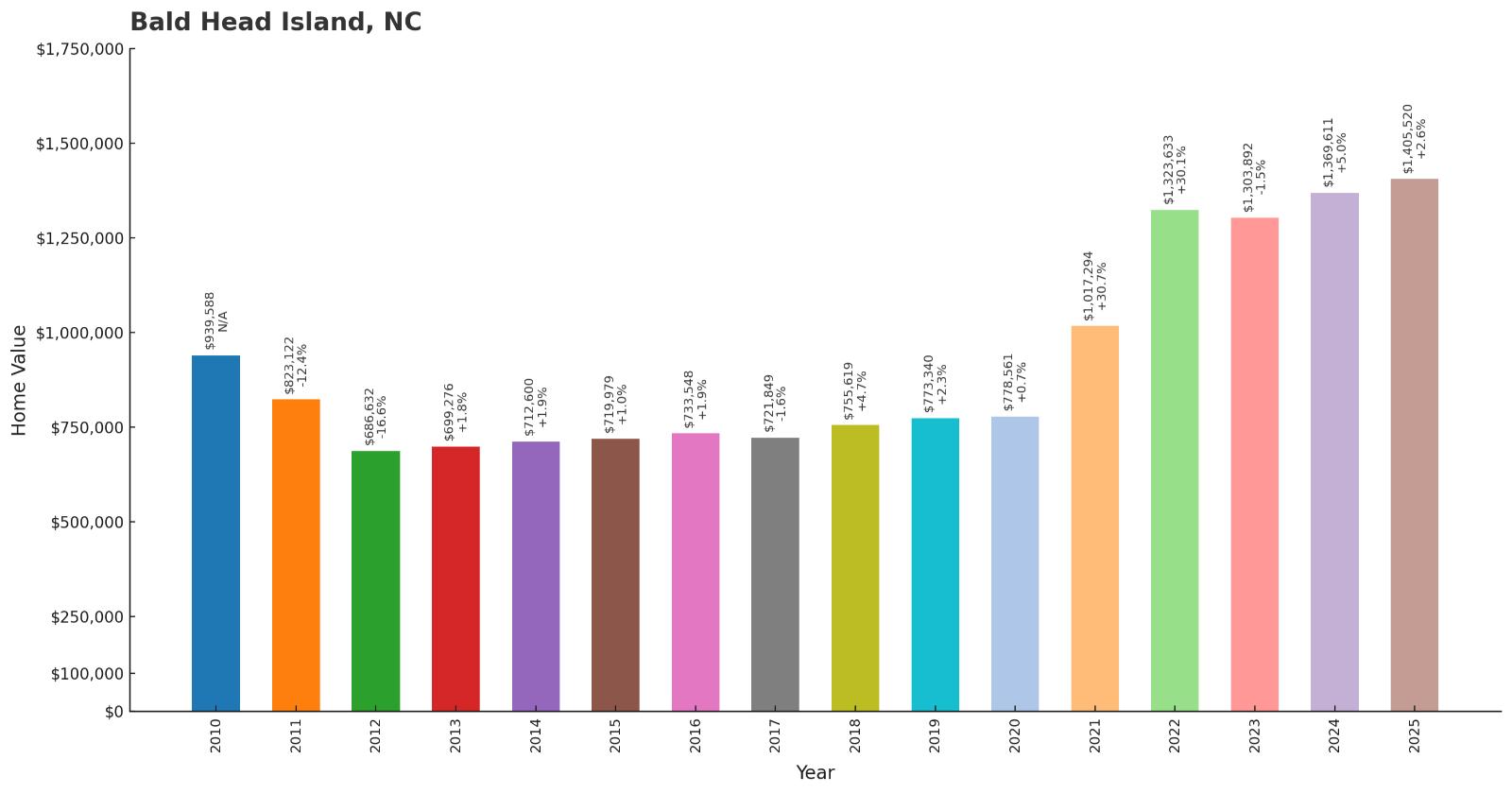
- 2010: $939,588
- 2011: $823,122
- 2012: $686,632
- 2013: $699,276
- 2014: $712,600
- 2015: $719,979
- 2016: $733,548
- 2017: $721,849
- 2018: $755,619
- 2019: $773,340
- 2020: $778,561
- 2021: $1,017,294
- 2022: $1,323,633
- 2023: $1,303,892
- 2024: $1,369,611
- 2025: $1,405,520
Bald Head Island posted solid 50% growth since 2010, rising from $939,588 to $1,405,520 by 2025. This exclusive barrier island community recovered from significant early-decade declines to show explosive growth during 2021-2022 when values jumped from $1,017,294 to $1,323,633. The island’s pristine beaches and car-free environment continue attracting ultra-wealthy buyers.
Why Bald Head Island?

Why are people willing to pay so much to live here? What’s special about it?
Bald Head Island offers the ultimate in exclusive coastal living with a car-free environment accessible only by ferry, creating a private paradise for residents and their guests. The island features pristine beaches, world-class golf, and luxury amenities while maintaining strict environmental protections that preserve its natural beauty. Residents enjoy complete privacy and tranquility in one of the most exclusive residential communities on the East Coast.
Property owners benefit from the island’s reputation as one of America’s most exclusive destinations, with limited development ensuring both privacy and long-term value appreciation. The combination of natural beauty, exclusivity, and luxury amenities creates an unparalleled coastal lifestyle that attracts ultra-high-net-worth buyers seeking the ultimate retreat.
How Bald Head Island Rose to Prominence
Bald Head Island served as an important maritime landmark for centuries, with its lighthouse guiding ships through the dangerous shoals near Cape Fear. The island remained largely undeveloped until the 1980s when developers began creating an exclusive residential community with strict environmental protections and architectural guidelines.
The community’s development as an ultra-luxury destination focused on preserving the island’s natural beauty while providing world-class amenities for residents. The decision to maintain a car-free environment accessible only by ferry created an exclusive atmosphere that attracts the wealthiest buyers seeking complete privacy and luxury coastal living.
3 Interesting Tidbits
1. Car-Free Paradise – Bald Head Island prohibits cars, with residents and visitors using golf carts and bicycles to travel around the 12,000-acre island.
2. Historic Lighthouse – “Old Baldy,” built in 1817, is North Carolina’s oldest standing lighthouse and serves as the island’s iconic landmark.
3. Environmental Sanctuary – Over 10,000 acres of the island are permanently protected as nature preserves, ensuring that development never compromises the natural environment.
1. Wrightsville Beach – 106% Home Price Increase Since 2010

- 2010: $763,780
- 2011: $708,593
- 2012: $677,540
- 2013: $682,882
- 2014: $725,829
- 2015: $771,267
- 2016: $790,844
- 2017: $809,313
- 2018: $833,176
- 2019: $868,811
- 2020: $912,553
- 2021: $1,170,383
- 2022: $1,499,982
- 2023: $1,493,845
- 2024: $1,501,235
- 2025: $1,572,888
Wrightsville Beach achieved impressive 106% growth since 2010, more than doubling from $763,780 to $1,572,888 by 2025. This iconic coastal destination showed consistent year-over-year appreciation through most years, with explosive growth during 2021-2022 when values jumped from $1,170,383 to $1,499,982. The beach’s crystal-clear waters and upscale amenities continue attracting the most affluent coastal buyers in North Carolina.
Why Wrightsville Beach?
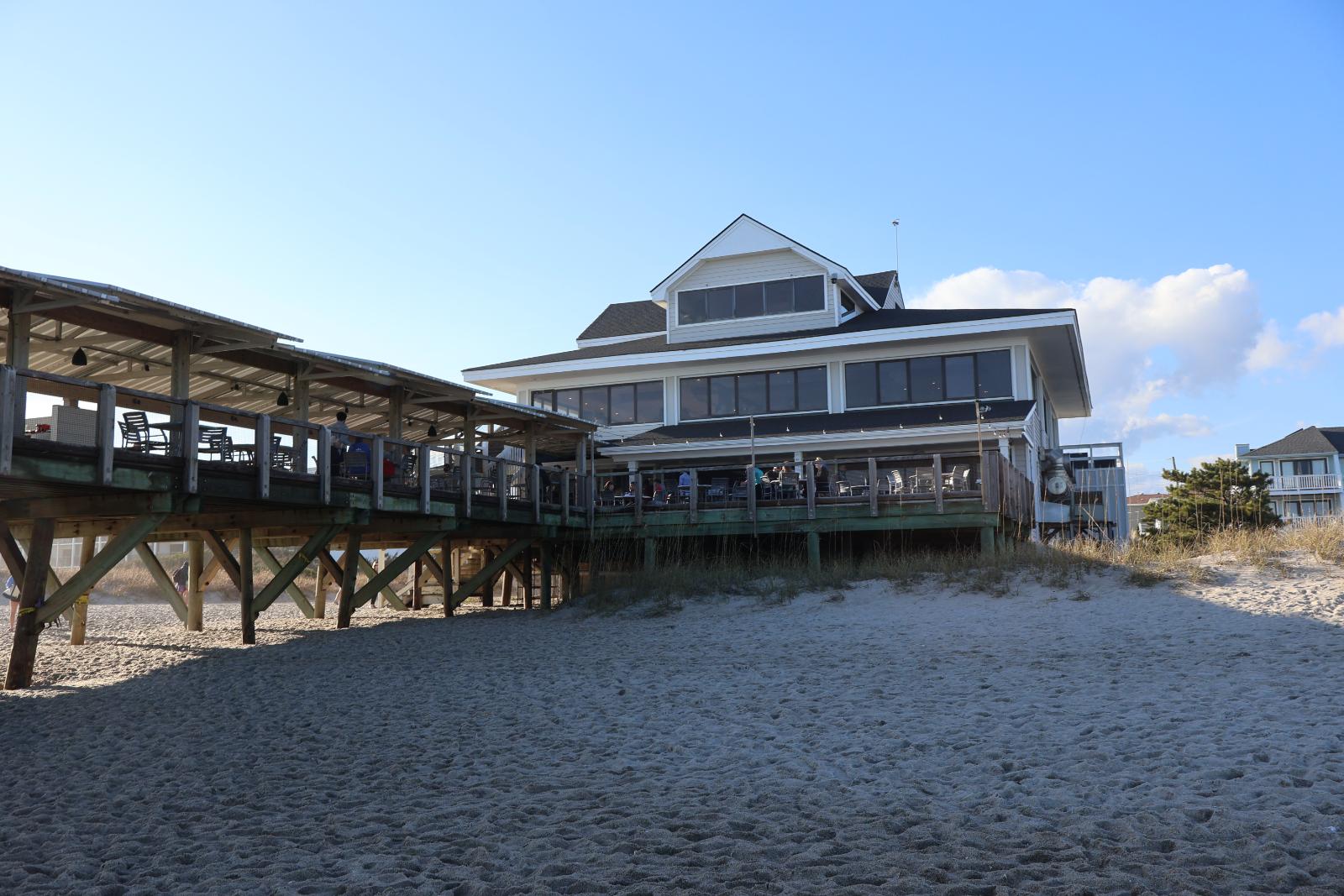
Why are people willing to pay so much to live here? What’s special about it?
Wrightsville Beach represents the pinnacle of North Carolina coastal living, offering crystal-clear waters, pristine white sand beaches, and an exclusive atmosphere that has attracted affluent families for generations. The island provides residents with world-class surfing, fishing, and boating opportunities while maintaining strict development controls that preserve its natural beauty and exclusive character. Many properties offer both oceanfront and soundfront access, creating unique recreational opportunities found nowhere else on the coast.
Property owners benefit from the beach’s reputation as one of the Southeast’s most prestigious coastal destinations, with homes often staying in families for generations and creating a stable, exclusive community atmosphere. The combination of natural beauty, recreational opportunities, and social prestige makes Wrightsville Beach the ultimate North Carolina coastal address for buyers who can afford the premium prices.
How Wrightsville Beach Rose to Prominence
Wrightsville Beach began attracting wealthy visitors in the late 1800s when a railroad connection made it accessible from Wilmington and beyond, establishing it as one of the first major resort destinations in North Carolina. The construction of grand hotels and the development of residential areas created a sophisticated coastal community that attracted prominent families from across the Southeast.
The beach’s transformation into the state’s most exclusive coastal community continued throughout the 20th century, with careful development and strong community standards maintaining its prestigious character. Wrightsville Beach’s combination of natural beauty, recreational opportunities, and social cachet established it as the premier coastal destination in North Carolina, attracting the state’s wealthiest residents and commanding the highest real estate prices.
3 Interesting Tidbits
1. Crystal Waters – Wrightsville Beach is famous for having some of the clearest waters on the East Coast, with visibility often extending 20-30 feet underwater.
2. Surfing Capital – The beach is considered the surfing capital of North Carolina, hosting numerous professional surfing competitions and maintaining a vibrant surf culture.
3. Generational Wealth – Many properties have remained in the same families for multiple generations, creating a close-knit community of established coastal families and contributing to the area’s exclusive atmosphere.

